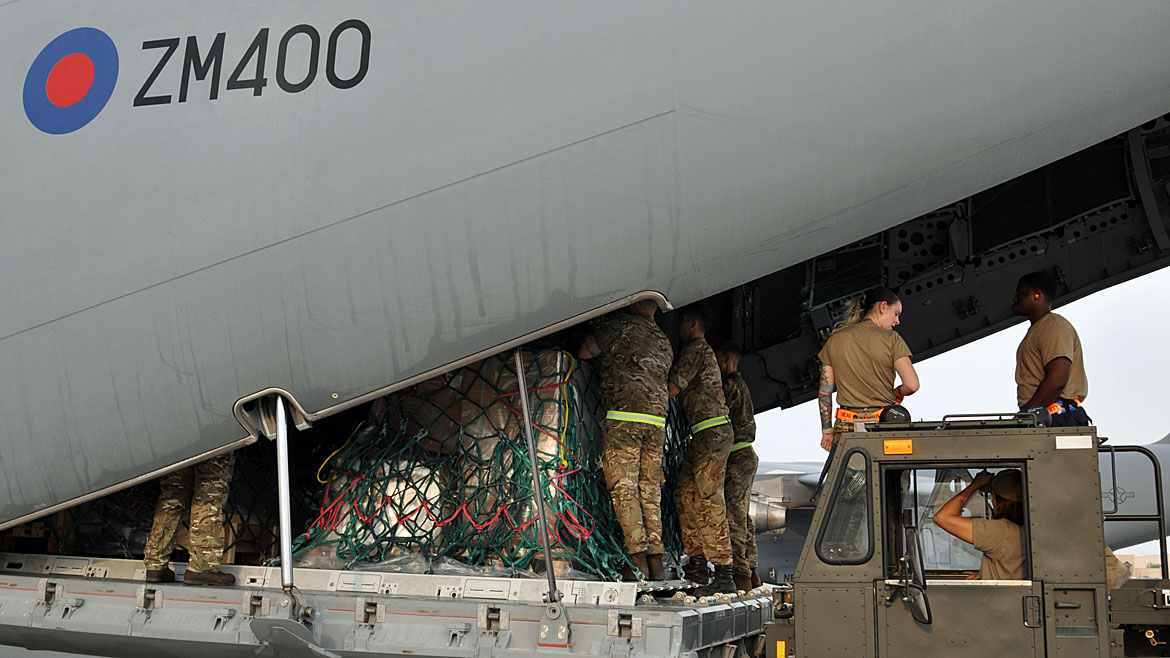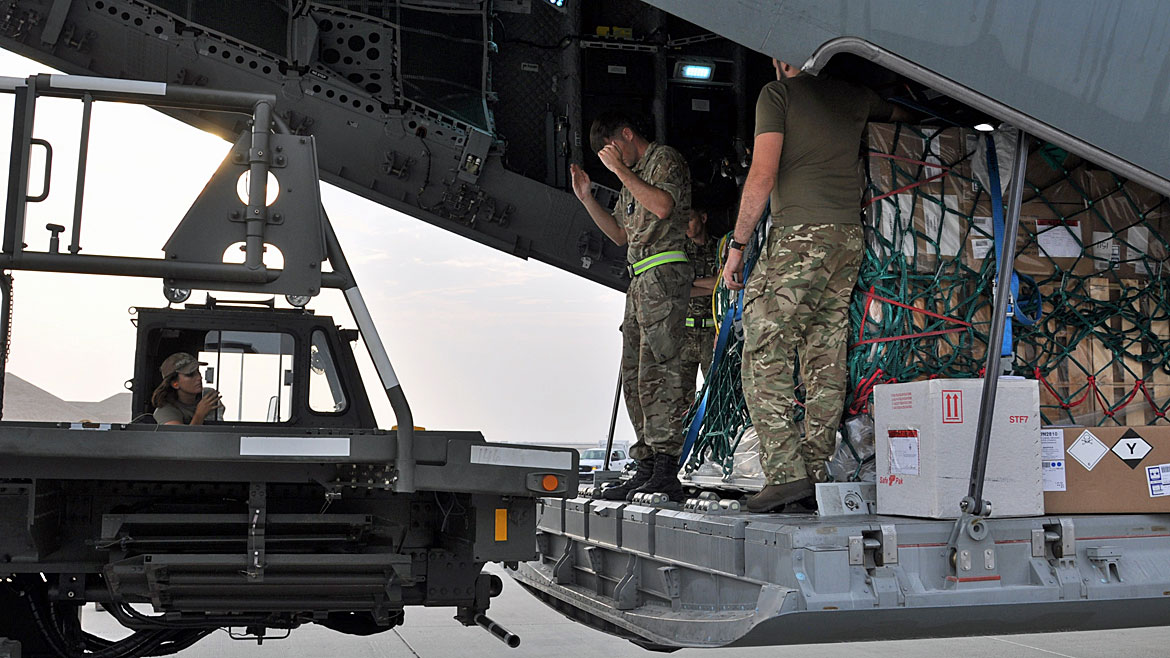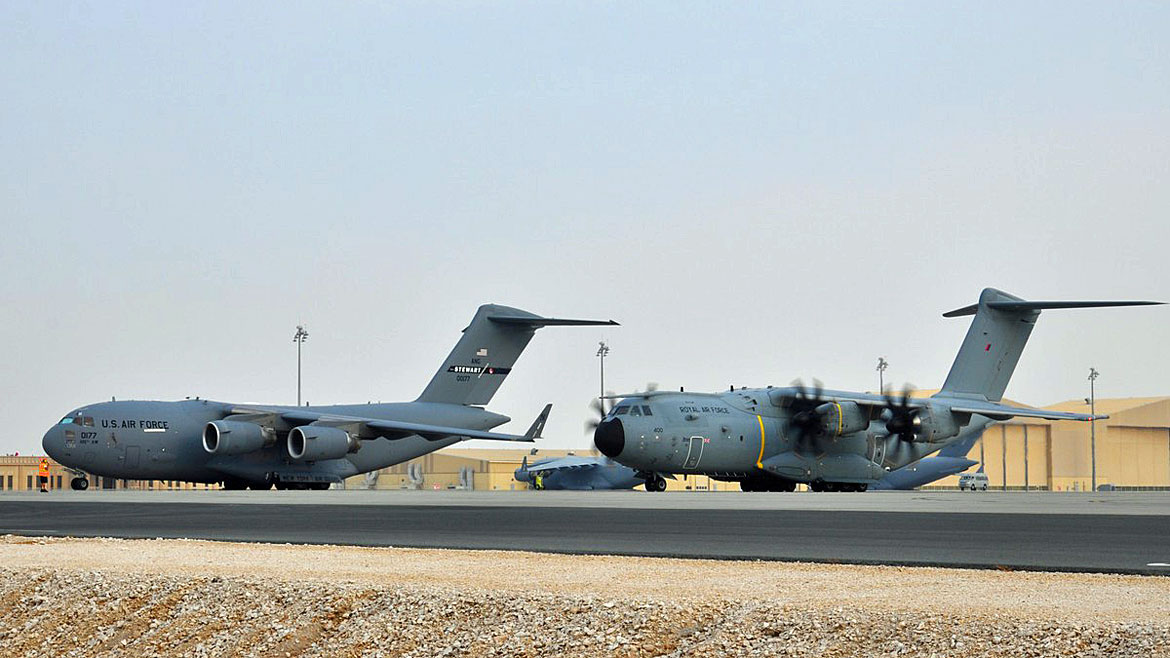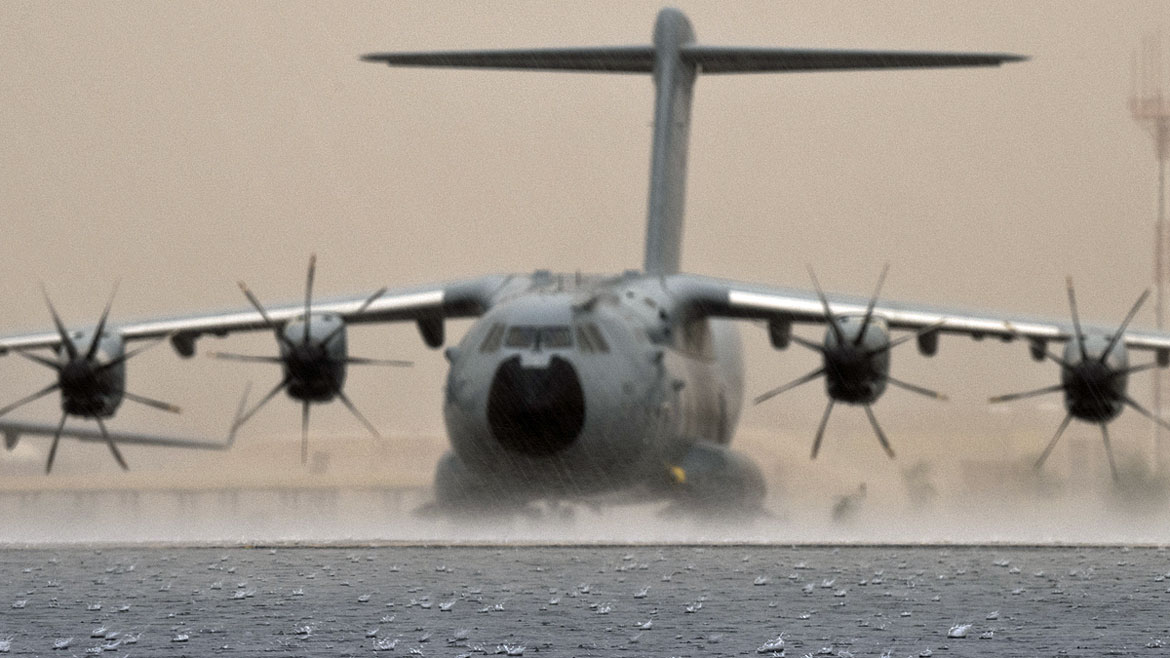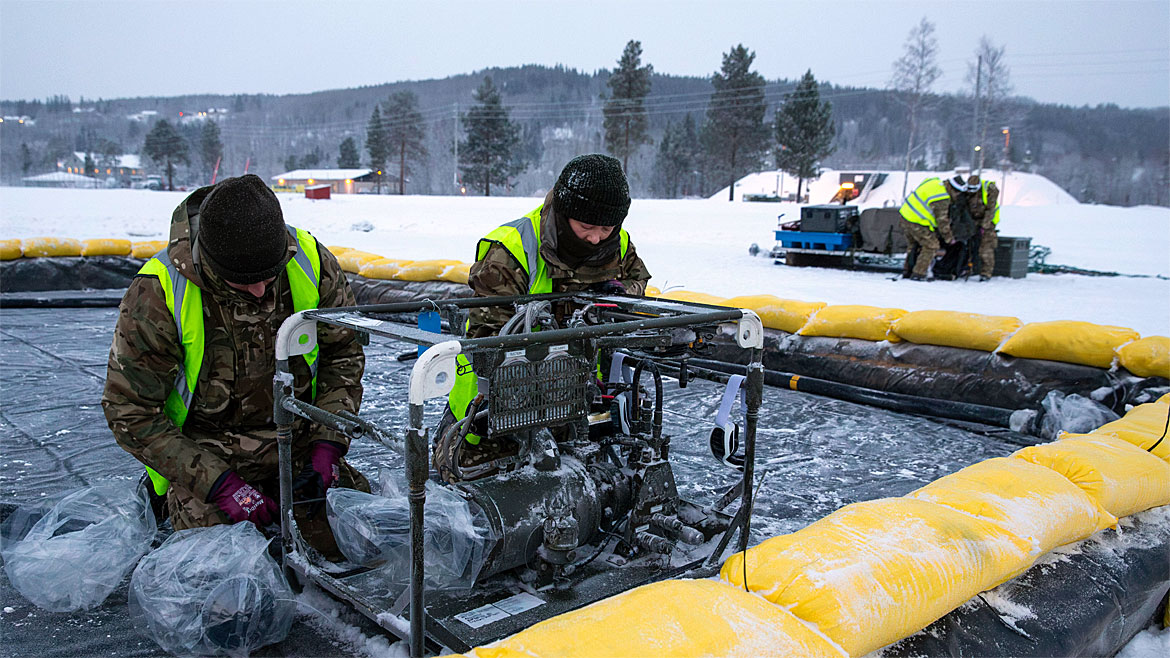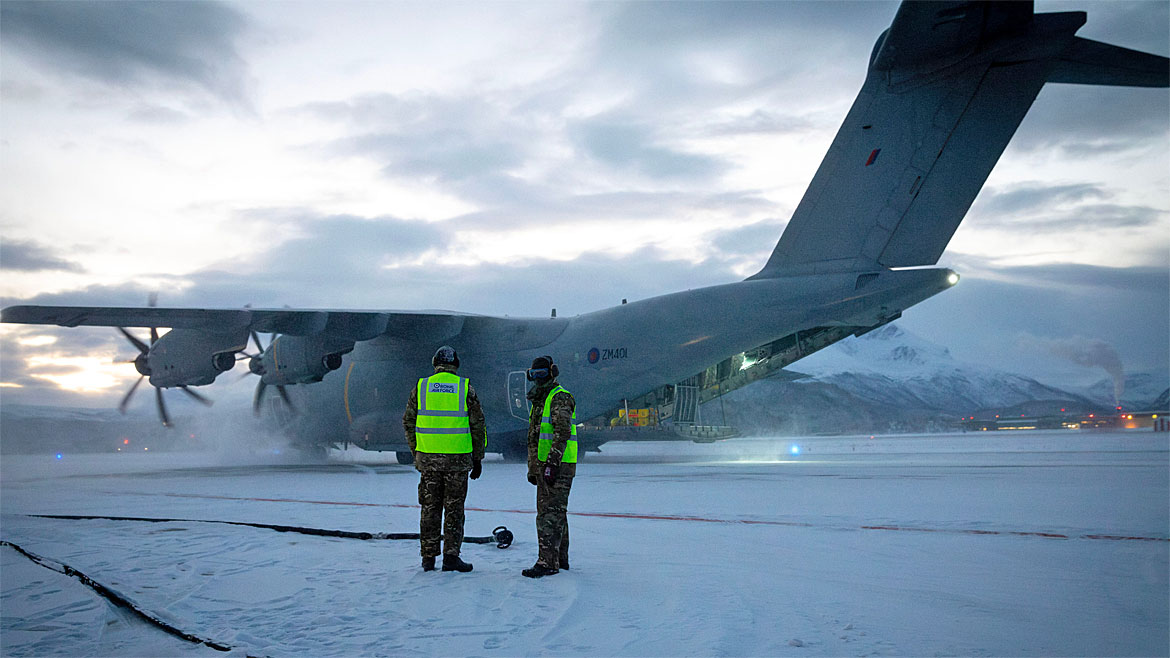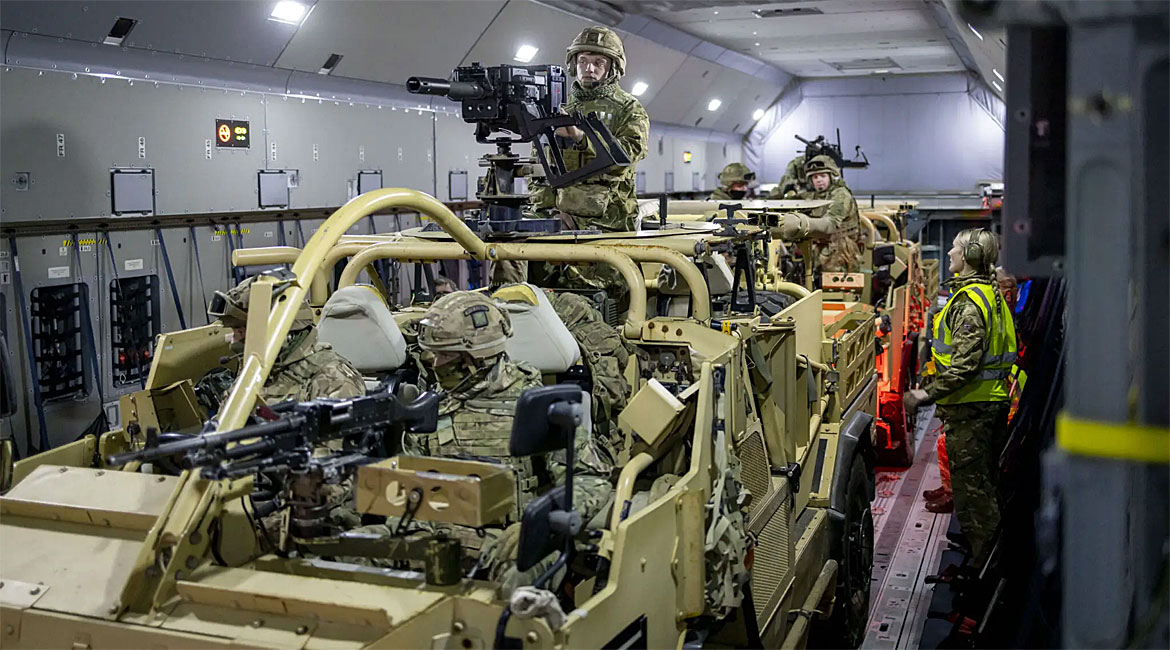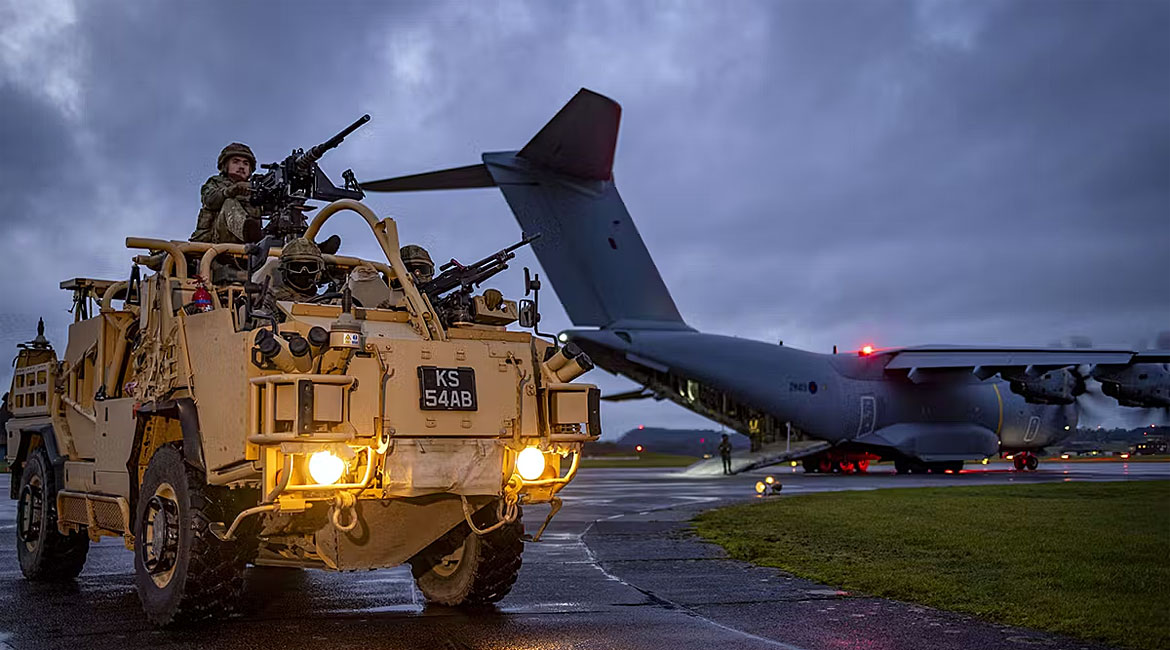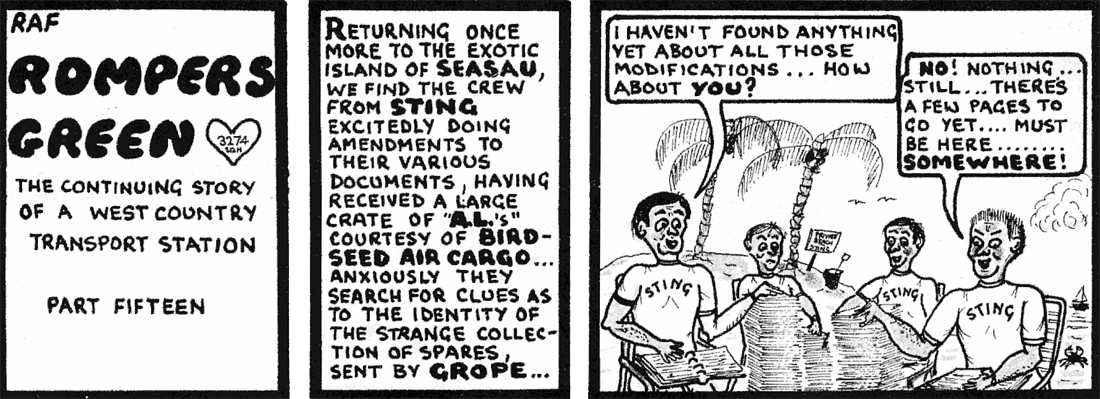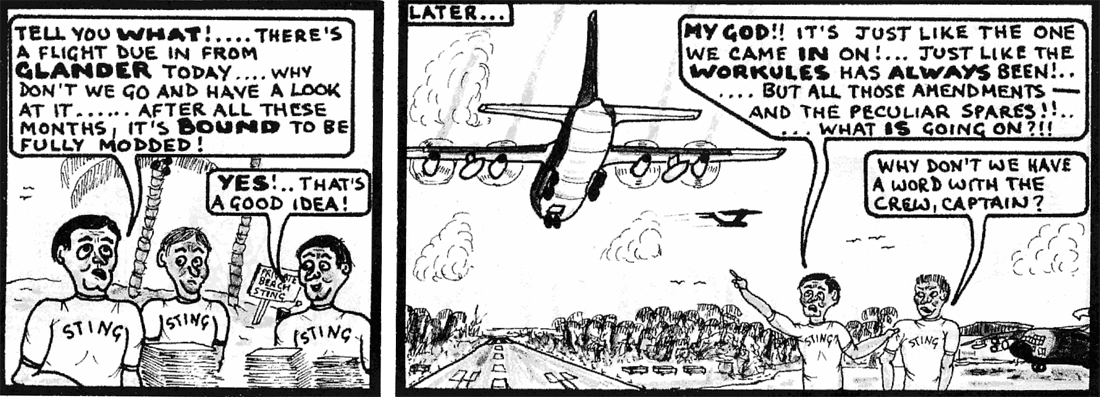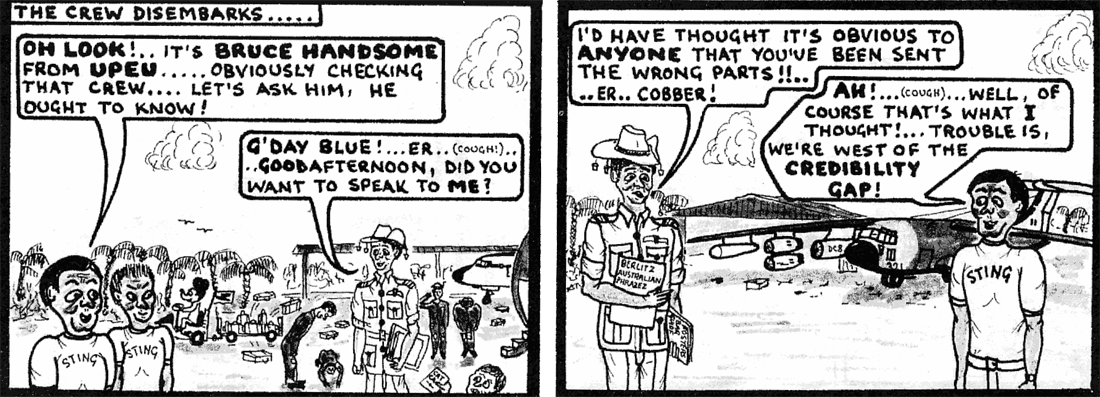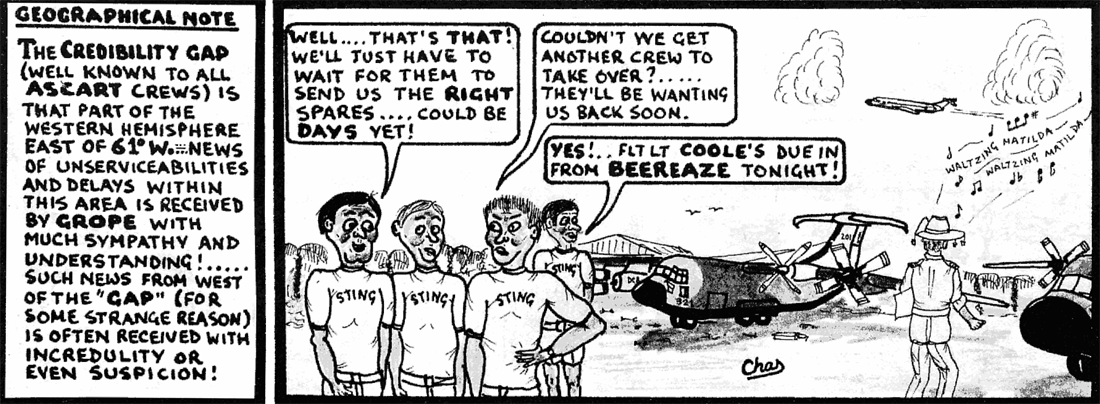

From: Mark Attrill, Tallinn
Subject: Post Air Force Careers & Food
Tony,
Post Air Force Careers. In the run up to completing just over 41 years service in the RAF, my last working day as the Deputy Commander of the NATO Force Integration Unit here in Estonia was on Friday 29 January 2021. Due to the ongoing issues associated with COVID-19 and my overseas service, I had already foregone my entitlement to any resettlement leave etc and started work at the Baltic Defence College, 185kms south of Tallinn the following Monday, 1 February! I cannot believe that I have now completed almost three years in my new job and have loved every minute of it. I found the transition from military service to a defence orientated educational institute extremely easy although the college have been very quick in providing me with active employment. I currently enjoy a wide range of responsibilities, including lecturing on Air Power in general, NATO Air and Joint Operations, and facilitating and directing our annual historical Staff Ride and the major Command Post Exercise that takes place at the end of each Joint Command and General Staff Course. In between all of this, and as part of my academic duties, I am expected to write one or two books so I am now busier than ever!
Now onto more interesting stuff - Food.
Singapore - Chicken Satay and Curry Puffs with Tiger Beer from the stalls adjacent to Bugis Street (which was nothing like it was in the 1970's when I visited (secretly) once or twice as a teenager).
New Delhi - Some of the best curries ever in the company of Paddy Power (and I had already spent 6+ years in the Far East as a teenager).
Bardufoss, Norway - At the end of a particularly trying arrival into Norway and a long day of offloads we wearily made our way to our accommodation. The first issue was the location - some 15km from the Air Station and half way up a mountain. The 1 Group Recce Team had booked the 'hotel' (in reality a hostel) in the autumn without taking account of the weather conditions in February. After struggling to get our 'all terrain' vehicles up the hill, we abandoned them at the half-way point and walked the rest. Our hearty evening meal (after a day largely without food) was a very large bowl of a boiling white mass that turned out to be Whale Blubber, soaked up with a rather bland and hard loaf of bread. We looked forward to our MCSU cooked English breakfast with the CLOCKWORK team the following day but not before we came off the road and had to be recovered from a deep ditch, during which Paddy Power crushed a rib or two.
En Route - Gander to Dulles. The best in-flight meal I ever had on a military transport aircraft was the Salmon Salad prepared by the Loadmaster while en-route between Gander and Dulles. The In-Flight catering team at Gander had messed up our original order so the Loadmaster asked them to provide him with all the fresh ingredients separately. Once airborne he took almost two hours to painstakingly put together an absolutely superb salad, to rival one that you would find in a 5* Hotel buffet, and served it up to everyone in equal measure, topped off with some excellent desserts and coffee.
Thanks again, Tony
Mark A
Subject: Post Air Force Careers & Food
Tony,
Post Air Force Careers. In the run up to completing just over 41 years service in the RAF, my last working day as the Deputy Commander of the NATO Force Integration Unit here in Estonia was on Friday 29 January 2021. Due to the ongoing issues associated with COVID-19 and my overseas service, I had already foregone my entitlement to any resettlement leave etc and started work at the Baltic Defence College, 185kms south of Tallinn the following Monday, 1 February! I cannot believe that I have now completed almost three years in my new job and have loved every minute of it. I found the transition from military service to a defence orientated educational institute extremely easy although the college have been very quick in providing me with active employment. I currently enjoy a wide range of responsibilities, including lecturing on Air Power in general, NATO Air and Joint Operations, and facilitating and directing our annual historical Staff Ride and the major Command Post Exercise that takes place at the end of each Joint Command and General Staff Course. In between all of this, and as part of my academic duties, I am expected to write one or two books so I am now busier than ever!
Now onto more interesting stuff - Food.
Singapore - Chicken Satay and Curry Puffs with Tiger Beer from the stalls adjacent to Bugis Street (which was nothing like it was in the 1970's when I visited (secretly) once or twice as a teenager).
New Delhi - Some of the best curries ever in the company of Paddy Power (and I had already spent 6+ years in the Far East as a teenager).
Bardufoss, Norway - At the end of a particularly trying arrival into Norway and a long day of offloads we wearily made our way to our accommodation. The first issue was the location - some 15km from the Air Station and half way up a mountain. The 1 Group Recce Team had booked the 'hotel' (in reality a hostel) in the autumn without taking account of the weather conditions in February. After struggling to get our 'all terrain' vehicles up the hill, we abandoned them at the half-way point and walked the rest. Our hearty evening meal (after a day largely without food) was a very large bowl of a boiling white mass that turned out to be Whale Blubber, soaked up with a rather bland and hard loaf of bread. We looked forward to our MCSU cooked English breakfast with the CLOCKWORK team the following day but not before we came off the road and had to be recovered from a deep ditch, during which Paddy Power crushed a rib or two.
En Route - Gander to Dulles. The best in-flight meal I ever had on a military transport aircraft was the Salmon Salad prepared by the Loadmaster while en-route between Gander and Dulles. The In-Flight catering team at Gander had messed up our original order so the Loadmaster asked them to provide him with all the fresh ingredients separately. Once airborne he took almost two hours to painstakingly put together an absolutely superb salad, to rival one that you would find in a 5* Hotel buffet, and served it up to everyone in equal measure, topped off with some excellent desserts and coffee.
Thanks again, Tony
Mark A


From: Gordon Gray, Powick, Worcs
Subject: October OBA
Hi Tony,
I wholeheartedly agree with Ian Berry’s topic on the backdrop substance of Shrewsbury; where on earth is our World and the human race going? Our forebears’ would be turning in their graves, witnessing current day ‘antics’ of humans in a modern day fighting force!
The ‘World has gone mad’ and our thoughts have spewed out into every aspect of instant information access. Where are we headed now with ‘AI’ and what on earth is coming next? AdditionalIy, I once had some respect for our ‘RAF Ambassador’ over the years but that too has now fizzled out, sadly.
I guess we’d all say our forebears would be horrified the way we humans conduct our lifestyle and lives today. As an octogenarian I am appalled; rant over!
Sincere thanks Tony, for your commitment to the OBA.
Gordon
Subject: October OBA
Hi Tony,
I wholeheartedly agree with Ian Berry’s topic on the backdrop substance of Shrewsbury; where on earth is our World and the human race going? Our forebears’ would be turning in their graves, witnessing current day ‘antics’ of humans in a modern day fighting force!
The ‘World has gone mad’ and our thoughts have spewed out into every aspect of instant information access. Where are we headed now with ‘AI’ and what on earth is coming next? AdditionalIy, I once had some respect for our ‘RAF Ambassador’ over the years but that too has now fizzled out, sadly.
I guess we’d all say our forebears would be horrified the way we humans conduct our lifestyle and lives today. As an octogenarian I am appalled; rant over!
Sincere thanks Tony, for your commitment to the OBA.
Gordon
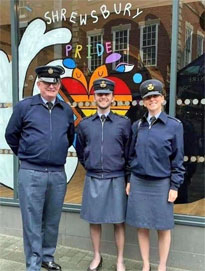
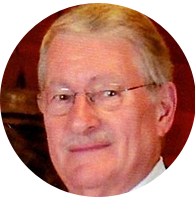

From: George Graves, Carlisle, Cumbria
Subject: Re: UKMAMS OBA OBB #103123
Hi Tony,
In response to Alex Masson who was wondering if any other mover had received the nuclear medal. Well it’s yes, I received mine just a couple of weeks ago [October]. I served at Maralinga, Australia, for one year 1961/62. Although the testing had finished, I was there for the clearing up. l was a supplier back then, just a boy 19/20 years old.
Regards,
George
Subject: Re: UKMAMS OBA OBB #103123
Hi Tony,
In response to Alex Masson who was wondering if any other mover had received the nuclear medal. Well it’s yes, I received mine just a couple of weeks ago [October]. I served at Maralinga, Australia, for one year 1961/62. Although the testing had finished, I was there for the clearing up. l was a supplier back then, just a boy 19/20 years old.
Regards,
George


RAF Air Mobility Force sustains UK military activities in the Middle East
(This article was first published on 9th November 2023)
(This article was first published on 9th November 2023)
Royal Air Force Brize Norton based Atlas A400M tactical transport aircraft continue to sustain UK military activities in the Middle East. The Atlas aircraft are one element of the Air Mobility Force and is the RAF’s tactical air transport aircraft. One key role of the aircraft is to provide the logistical link between the UK and deployed UK military units in the Middle East. These sorties form the Broader Middle East Air Transport Schedule and are known as ‘BATS’. The sorties deliver the supplies needed for all activities to continue.
Recent BATS sorties have seen the A400M deliver equipment to support the RAF participation on the Qatari led Exercise Ferocious Falcon V. This annual Qatari exercise is designed to allow their military forces to work with their key partner nations and this year in addition to RAF Typhoons, a British Army contingent from 1st Battalion the Scots Guards and HMS Lancaster are taking part.
Squadron Leader Clarke, Lead Logistics Planning Officer with 83 Expeditionary Air Group in the Middle East said, “These sorties are both routine and vital. It is one of the core functions of the Air Mobility Force to deliver the supplies needed be able to sustain UK military activities here and it is a task that the A400M has been fulfilling in the Middle East now for some years”.
At Al Udeid Air Base the Atlas is loaded and unloaded by a combined team of ‘Movers’ from the RAF and USAF. The RAF team is from RAF Brize Norton based 1 Air Mobility Wing and the USAF personnel are from the 8th Expeditionary Air Mobility Squadron based at Ramstein Air Base Germany.
One of the Exercise Ferocious Falcon V deliveries was especially challenging, as it happened during a sudden sandstorm as the Atlas was taxiing and was immediately followed by a heavy desert thunderstorm that tested, the ‘Movers’ and aircrew. The challenging conditions however, demonstrated the teamwork that has been established between the RAF and USAF personnel at the desert airbase.
Royal Air Force
Recent BATS sorties have seen the A400M deliver equipment to support the RAF participation on the Qatari led Exercise Ferocious Falcon V. This annual Qatari exercise is designed to allow their military forces to work with their key partner nations and this year in addition to RAF Typhoons, a British Army contingent from 1st Battalion the Scots Guards and HMS Lancaster are taking part.
Squadron Leader Clarke, Lead Logistics Planning Officer with 83 Expeditionary Air Group in the Middle East said, “These sorties are both routine and vital. It is one of the core functions of the Air Mobility Force to deliver the supplies needed be able to sustain UK military activities here and it is a task that the A400M has been fulfilling in the Middle East now for some years”.
At Al Udeid Air Base the Atlas is loaded and unloaded by a combined team of ‘Movers’ from the RAF and USAF. The RAF team is from RAF Brize Norton based 1 Air Mobility Wing and the USAF personnel are from the 8th Expeditionary Air Mobility Squadron based at Ramstein Air Base Germany.
One of the Exercise Ferocious Falcon V deliveries was especially challenging, as it happened during a sudden sandstorm as the Atlas was taxiing and was immediately followed by a heavy desert thunderstorm that tested, the ‘Movers’ and aircrew. The challenging conditions however, demonstrated the teamwork that has been established between the RAF and USAF personnel at the desert airbase.
Royal Air Force
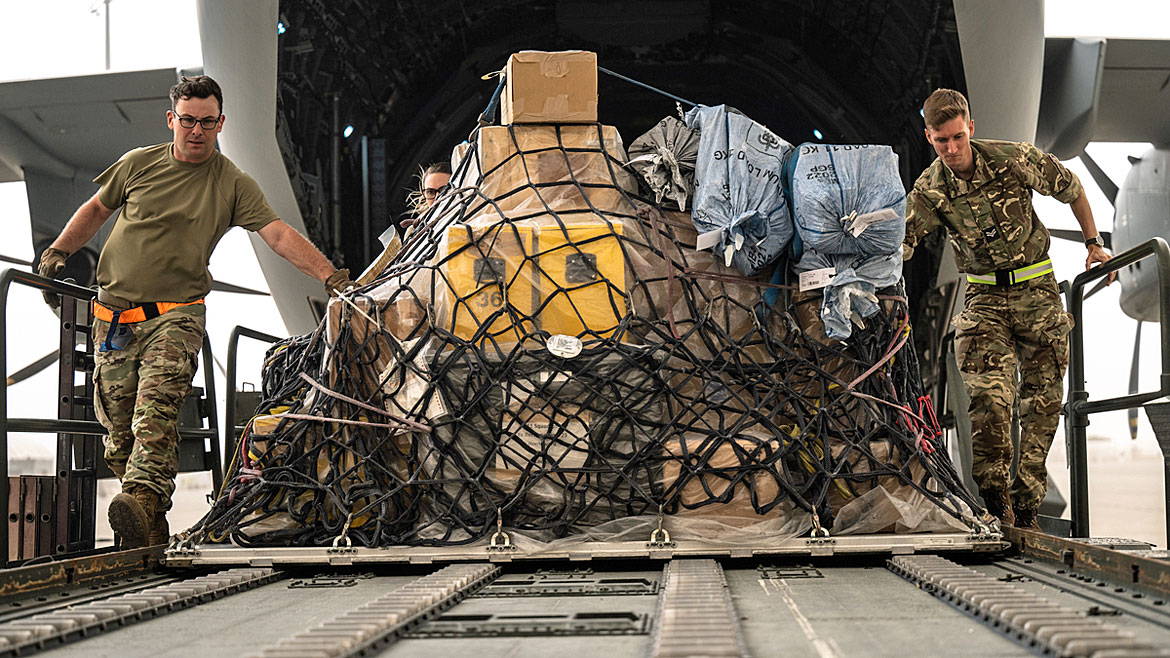
A Spot of Bother By Richard (Dick) King
On the afternoon of 5 June 1982, the 10 Squadron VC10 crew, of which I was the co-pilot and which was captained by Flt Lt Brian Wheeler, arrived at Dakar Airport in Senegal, from our nearby hotel, to fly the round trip from Dakar to Ascension Island and back. The Falkland Island troubles had been the main focus of our lives since the Argentinians had invaded the islands earlier in April. As part of the logistic supply to the Ascension Island base, we flew daily trips there from RAF Brize Norton in the UK via Dakar. Because of the distance involved we slipped crews at Dakar to maintain a regular non-stop service of up to three or four aircraft a day. Accommodation at Ascension was very limited so the three-hour each way sectors from Dakar, coupled with a 1½ hour turn-round at Ascension was well within our crew duty time limits and the accommodation problem was solved by the numerous crews flying the route all staying in hotels in Dakar. Banjul in the Gambia was also used for a short period during the conflict, until the RAF used up all their fuel.
The VC10 XV105 taxied in and the crew which had brought the aircraft from the UK disembarked. The captain, Flt Lt Robbie Robinson, a close friend of mine from Kenyan schooldays in Nairobi, took Brian aside and was deep in conversation with him for a few minutes. The rest of our crew thought that he was merely briefing Brian on the cargo and other relatively mundane aspects of his flight out. This transpired not to be the case. In fact, Brian was being told that we were not just going to Ascension and back but were now being tasked with taking the aircraft further south to Montevideo in Uruguay in order to fly a “Red Cross Flight” back from there. Wounded sailors who had been injured by the sinking of the Royal Navy ships HMS Sheffield and HMS Coventry, together with Army casualties from Goose Green had been evacuated from the area by the hospital ship (I forget whether it was the Uganda or Canberra) and taken to a military hospital in Montevideo. Robbie’s crew left the airport for their hotel and Brian told us the news. We had been told there would be charts and documents left in a green document bag on the flight deck for our unanticipated crossing of the South Atlantic. They were nowhere to be found. It later materialised that they had simply been left behind at Brize Norton. The Navigator and I went across to the Air Traffic Control Tower at Dakar where the flight plan would have to be filed. The usual procedure was for us to fly on civilian air routes using recognised airways depicted on civilian air charts. However, with no charts we would have a problem trying to ascertain which civilian ATC (air traffic control) agency we would have to be in contact with, whilst over the ocean. On the wall of the Flight Planning Office in Dakar we saw a fly-splattered American Air Force Atlantic chart that must have been at least 10 years old. A quick trip for me back to the aircraft ensued, returning with a bag of the most vile-tasting coffee brand that was sometimes put into our in-flight rations. The age of bartering in Africa still lived. We handed over the coffee to the flight-planning clerk and swapped it for the out-of-date chart. Luckily aircraft, even in the ‘80s, utilised a computer flight-planning system that produced a document from the Jeppesen Company in San Francisco which was sent to our handling agents by telex and it was known as the Jetplan. This contained all the route tracks, distances, leg-times, fuel burns, planned altitudes and a host of other information necessary for a safe flight. Our handling agent now produced our Jetplan, sent via telex from our HQ at Upavon in the UK, meaning that we now had just enough paper-work to allow us to legally get airborne.
The VC10 XV105 taxied in and the crew which had brought the aircraft from the UK disembarked. The captain, Flt Lt Robbie Robinson, a close friend of mine from Kenyan schooldays in Nairobi, took Brian aside and was deep in conversation with him for a few minutes. The rest of our crew thought that he was merely briefing Brian on the cargo and other relatively mundane aspects of his flight out. This transpired not to be the case. In fact, Brian was being told that we were not just going to Ascension and back but were now being tasked with taking the aircraft further south to Montevideo in Uruguay in order to fly a “Red Cross Flight” back from there. Wounded sailors who had been injured by the sinking of the Royal Navy ships HMS Sheffield and HMS Coventry, together with Army casualties from Goose Green had been evacuated from the area by the hospital ship (I forget whether it was the Uganda or Canberra) and taken to a military hospital in Montevideo. Robbie’s crew left the airport for their hotel and Brian told us the news. We had been told there would be charts and documents left in a green document bag on the flight deck for our unanticipated crossing of the South Atlantic. They were nowhere to be found. It later materialised that they had simply been left behind at Brize Norton. The Navigator and I went across to the Air Traffic Control Tower at Dakar where the flight plan would have to be filed. The usual procedure was for us to fly on civilian air routes using recognised airways depicted on civilian air charts. However, with no charts we would have a problem trying to ascertain which civilian ATC (air traffic control) agency we would have to be in contact with, whilst over the ocean. On the wall of the Flight Planning Office in Dakar we saw a fly-splattered American Air Force Atlantic chart that must have been at least 10 years old. A quick trip for me back to the aircraft ensued, returning with a bag of the most vile-tasting coffee brand that was sometimes put into our in-flight rations. The age of bartering in Africa still lived. We handed over the coffee to the flight-planning clerk and swapped it for the out-of-date chart. Luckily aircraft, even in the ‘80s, utilised a computer flight-planning system that produced a document from the Jeppesen Company in San Francisco which was sent to our handling agents by telex and it was known as the Jetplan. This contained all the route tracks, distances, leg-times, fuel burns, planned altitudes and a host of other information necessary for a safe flight. Our handling agent now produced our Jetplan, sent via telex from our HQ at Upavon in the UK, meaning that we now had just enough paper-work to allow us to legally get airborne.

Unfortunately, though, there was also the outstanding omission of a big red cross painted on either side of the aircraft’s nose. There hadn’t been enough time in the UK to get this done before the aircraft had been tasked for the flight. Apparently, it had been decided that because all of our flight from Ascension onwards would be in the dark, it would make sense to paint the red crosses on the nose once we landed in Uruguay, while we were resting before the flight home and before our casualty load boarded. - Our ground engineer wouldn’t be resting much or doing any sightseeing when we arrived in Uruguay.
We landed uneventfully at Ascension and off-loaded the outbound passengers who had been on the aircraft from the UK, together with their baggage. An hour and a half later, having refuelled, we left Runway 14 at Ascension and climbed up into the dark Atlantic night heading south-west. It is common practice for all ‘non-combatant aircraft’, for want of a better phrase, to utilise civilian air traffic control radio frequencies when transiting through civilian airspace. We conformed to this procedure and passed our position reports on the HF long-range radio to Dakar and later to Recife and Porto Alegre in Brazil. It is common for many air traffic agencies to work the same frequencies on an HF wireless network and it was not uncommon for an aircraft to be heard calling and reporting to an agency that we were not required to be in contact with. HF coms was an acquired art.
As we neared the South American coast, some 500 miles or so out to sea, I called Porto Alegre one more time to pass a position report. No answer. There was a great deal of static noise but no Recife to be heard. I repeated my call. Still no answer. Then, from out of the dark night, came a voice so loud and clear that I thought he was sitting next to me. “Go ahead. Ascot 2645. This is Buenos Aires. I will relay your position to Porto Alegre.” But Buenos Aires is in Argentina..... Hang on ! - We were fighting a war against Argentina. I pretended I had not heard him and we ignored the generosity of our enemy’s friendly civilian air traffic controller. We kept a very close watch on our weather radar after that in case we were approached by any unwanted visitors although our equipment was not really designed to pick up other aircraft. Eventually we came within range and into contact with Montevideo on the clearer and shorter-range VHF radio for our position reporting. But our troubles had only just started.
It must have been about midnight, local time in Uruguay. The lady operating the radio frequency advised us quite simply that we could not land in Montevideo because visibility there was down to about 50 metres in thick fog. Unlike today’s Category 3B zero feet and 75 metres visibility automatic-landing procedures, which are taken as the norm in low- visibility conditions, in the 1960s designed VC10, we had to be able to see to land with a minimum visibility of about 600 metres. The only solution was to divert. Where to? There are relatively few airfields in Uruguay suitable for long-range airliners such as the VC10. In our somewhat rudimentary flight planning back in the Dakar office with the aid of our ‘bartered’ chart, we had chosen to use an airfield near Montevideo called Maldonado as our preferred ‘alternate’ or diversion airfield. It was situated on the coast of Uruguay about 100 miles south-east of the capital, Montevideo.
We landed uneventfully at Ascension and off-loaded the outbound passengers who had been on the aircraft from the UK, together with their baggage. An hour and a half later, having refuelled, we left Runway 14 at Ascension and climbed up into the dark Atlantic night heading south-west. It is common practice for all ‘non-combatant aircraft’, for want of a better phrase, to utilise civilian air traffic control radio frequencies when transiting through civilian airspace. We conformed to this procedure and passed our position reports on the HF long-range radio to Dakar and later to Recife and Porto Alegre in Brazil. It is common for many air traffic agencies to work the same frequencies on an HF wireless network and it was not uncommon for an aircraft to be heard calling and reporting to an agency that we were not required to be in contact with. HF coms was an acquired art.
As we neared the South American coast, some 500 miles or so out to sea, I called Porto Alegre one more time to pass a position report. No answer. There was a great deal of static noise but no Recife to be heard. I repeated my call. Still no answer. Then, from out of the dark night, came a voice so loud and clear that I thought he was sitting next to me. “Go ahead. Ascot 2645. This is Buenos Aires. I will relay your position to Porto Alegre.” But Buenos Aires is in Argentina..... Hang on ! - We were fighting a war against Argentina. I pretended I had not heard him and we ignored the generosity of our enemy’s friendly civilian air traffic controller. We kept a very close watch on our weather radar after that in case we were approached by any unwanted visitors although our equipment was not really designed to pick up other aircraft. Eventually we came within range and into contact with Montevideo on the clearer and shorter-range VHF radio for our position reporting. But our troubles had only just started.
It must have been about midnight, local time in Uruguay. The lady operating the radio frequency advised us quite simply that we could not land in Montevideo because visibility there was down to about 50 metres in thick fog. Unlike today’s Category 3B zero feet and 75 metres visibility automatic-landing procedures, which are taken as the norm in low- visibility conditions, in the 1960s designed VC10, we had to be able to see to land with a minimum visibility of about 600 metres. The only solution was to divert. Where to? There are relatively few airfields in Uruguay suitable for long-range airliners such as the VC10. In our somewhat rudimentary flight planning back in the Dakar office with the aid of our ‘bartered’ chart, we had chosen to use an airfield near Montevideo called Maldonado as our preferred ‘alternate’ or diversion airfield. It was situated on the coast of Uruguay about 100 miles south-east of the capital, Montevideo.
We notified our charming friend on the radio that we would go there. Her reply gave us the impression that she was somewhat amused. Her words were to the effect, “I don’t think so for two reasons. One is that they have thick fog also and the second is that they have no runway lights.” Hmmmmm.....!! She was determined to make up for this though by saying, “You will divert to Durazno”. Having never heard of Durazno before, we embarrassingly asked her where it was. After telling us that it was approximately 150 kilometres north-west of Montevideo, she then proceeded to tell us all the aviation details about it, which we couldn’t thank her enough for. Remember that we had no charts on board. We later landed there being thankful that Uruguay is predominantly flat with no mountains to worry us and, just as we turned off the runway, the fog came down there as well. The only other suitable airfield within our fuel reserves would have been Buenos Aires, the capital of Argentina, with whom we were at war.......not a good idea, we thought.
By now it was about 01:30 in the morning and it turned out that Durazno was a relatively small training airfield for the Uruguayan Air Force. It was smaller than our own RAF Cranwell. A hangar we walked through did appear to have a considerable number of Pucara aircraft, which we knew were also flown by the Argentinians. In spite of the unearthly hour and our un-announced arrival, we were met by the only two officers on the base who spoke English. One was a major and the other a junior lieutenant. I forget all the minor details about the next hour or so but the outcome was that we were despatched to a small hotel in the nearby town of Durazno where we spent minimum rest. It had been decided that our poor ground engineer would remain at the airfield, though, in order to paint our missing Red Crosses on the aircraft in preparation for our flight, later that afternoon, to Montevideo.
The next morning at about nine o’clock, I awoke in the basic room of the hotel and found an armed guard outside my door. I was however allowed to go to the small room that passed as the hotel restaurant and in dribs and drabs the rest of the crew arrived for breakfast. I use the word ‘breakfast’ loosely; it comprised just cream crackers and jam, with no butter as I recall. The engineer and I decided to see a bit of the town and surprisingly, in spite of our overnight guards, we were nevertheless allowed to venture out of the hotel on our own. It was a sunny Sunday morning yet the town was almost deserted. I recall noticing the numerous heavily-pruned plane trees or their South-American equivalents, as we walked along the streets. There wasn’t much else of note. An hour or so later we were on the bus back to the airfield and were met there by our ground engineer.
During the night he told us that he had been frequently interrupted in his painting of the Red Cross by messengers telling him to go the 200 yards or so to the Operations Room where there had been telephone calls for him. These calls had been from the British Embassy in Montevideo. They kept being cut off. One of them had asked him to check the aircraft’s manifests. These are the documents that list all passengers’ names and details of the freight being carried on board. We had no passengers but loads of stretchers and medical equipment in our holds. It is not in a ground engineer’s remit to understand the finer details of aircraft documentation and he had spent much of his valuable time searching our Loadmaster’s paperwork left on board to find what the Embassy meant; to no avail.
By now it was about 01:30 in the morning and it turned out that Durazno was a relatively small training airfield for the Uruguayan Air Force. It was smaller than our own RAF Cranwell. A hangar we walked through did appear to have a considerable number of Pucara aircraft, which we knew were also flown by the Argentinians. In spite of the unearthly hour and our un-announced arrival, we were met by the only two officers on the base who spoke English. One was a major and the other a junior lieutenant. I forget all the minor details about the next hour or so but the outcome was that we were despatched to a small hotel in the nearby town of Durazno where we spent minimum rest. It had been decided that our poor ground engineer would remain at the airfield, though, in order to paint our missing Red Crosses on the aircraft in preparation for our flight, later that afternoon, to Montevideo.
The next morning at about nine o’clock, I awoke in the basic room of the hotel and found an armed guard outside my door. I was however allowed to go to the small room that passed as the hotel restaurant and in dribs and drabs the rest of the crew arrived for breakfast. I use the word ‘breakfast’ loosely; it comprised just cream crackers and jam, with no butter as I recall. The engineer and I decided to see a bit of the town and surprisingly, in spite of our overnight guards, we were nevertheless allowed to venture out of the hotel on our own. It was a sunny Sunday morning yet the town was almost deserted. I recall noticing the numerous heavily-pruned plane trees or their South-American equivalents, as we walked along the streets. There wasn’t much else of note. An hour or so later we were on the bus back to the airfield and were met there by our ground engineer.
During the night he told us that he had been frequently interrupted in his painting of the Red Cross by messengers telling him to go the 200 yards or so to the Operations Room where there had been telephone calls for him. These calls had been from the British Embassy in Montevideo. They kept being cut off. One of them had asked him to check the aircraft’s manifests. These are the documents that list all passengers’ names and details of the freight being carried on board. We had no passengers but loads of stretchers and medical equipment in our holds. It is not in a ground engineer’s remit to understand the finer details of aircraft documentation and he had spent much of his valuable time searching our Loadmaster’s paperwork left on board to find what the Embassy meant; to no avail.
The Vickers’ designers had however foreseen this possibility and had positioned over-wing refuelling points above each tank in the upper surface of each wing. The procedure should have been simple; undo the 20 or so screws holding down each cap and just pour fuel into each tank by a hose from any refuelling tanker even if it didn’t have pressure assist to help. Unfortunately, this system had never, in the twenty or so years of aircraft in service, been used. The screws in each tank were totally encrusted with paint and every tank’s screws except one, the outer transfer tank in our right wing, refused to budge. Instead of a normal pressure refuel taking about 20 minutes, it took forever to fill this small tank by hand pump and even longer to then pump that fuel into the aircraft’s appropriate main tanks so as to maintain a balance in both wing’s tanks for safe flight. By four in the afternoon the task was completed and we took off for Montevideo.
Our arrival there was met by what seemed to be a very large number of people. Most significant were armed personnel and guard dogs. Nevertheless, we started to off-load seats from upstairs and replace them with stretchers from the holds in readiness for our wounded passengers. I believe that some of the British Embassy staff were also present. After a while the attitude of the assembled throng seemed to change and we were advised to refrain from unloading the rear hold. The Daily Mail later reported that “In spite of vigorous protests from the crew, the Uruguayans insisted on off-loading the hold.” In today’s jargon we could accuse the Mail of giving out ‘fake news’. In reality, faced with armed guards and Doberman or Alsatian dogs, we readily agreed to allow anyone to continue the back-breaking work of unloading.
Our arrival there was met by what seemed to be a very large number of people. Most significant were armed personnel and guard dogs. Nevertheless, we started to off-load seats from upstairs and replace them with stretchers from the holds in readiness for our wounded passengers. I believe that some of the British Embassy staff were also present. After a while the attitude of the assembled throng seemed to change and we were advised to refrain from unloading the rear hold. The Daily Mail later reported that “In spite of vigorous protests from the crew, the Uruguayans insisted on off-loading the hold.” In today’s jargon we could accuse the Mail of giving out ‘fake news’. In reality, faced with armed guards and Doberman or Alsatian dogs, we readily agreed to allow anyone to continue the back-breaking work of unloading.
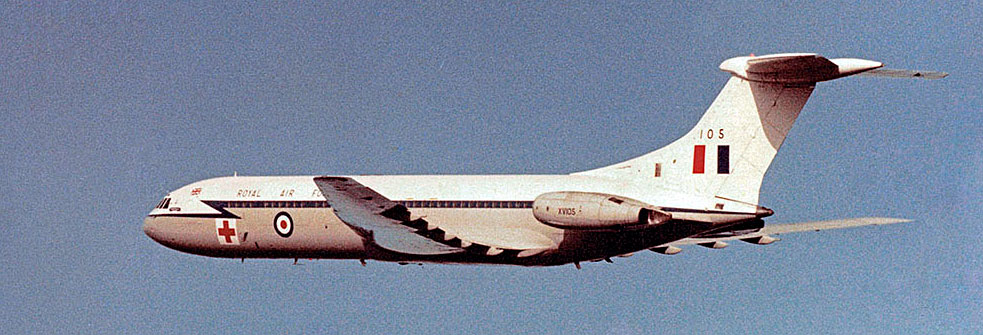
VC-10 XV105 with Red Cross markings
When the VC10 had been designed in the 1960’s it had been anticipated that all refuelling would be carried out by pressure hoses being attached to refuelling points underneath the wing. Fuel was then forced into the tanks under pressure from airport refuelling trucks designed for the purpose. Durazno had none of these pressure-refuelling trucks. How were we to refuel in order to reach Montevideo?
A box containing the personal effects of an RAF officer passenger who had left the aircraft at Ascension Island was found in the rear hold. In the box were certain items of RAF spares that were required for Harrier aircraft which were playing such a major role flying off ships in the UK Task Force close to the Falklands. Un-manifested the spares should never have been secreted in personal baggage in the first place and should, in any case, have been off- loaded at Ascension. But how had anyone in Uruguay got to hear of this? Was the Embassy communications system tapped or hacked into? Had anyone been listening-in to the calls to our ground engineer when he had been cut off so many times at Durazno whilst trying to paint the Red Crosses during the previous night? We never did find out, nor indeed to whom the box belonged.
By 18:00 hours local time we were ready to accept our passengers and all 56 stretchers were occupied by the wounded that had been brought from the military hospital. As the sun set, we took off for the six-hour night-flight to Ascension where on arrival, our crew became passengers for the final sector home to Brize Norton. I recall going back to the passenger cabin and chatting to some of them. They all knew that our crew had had a few problems during the previous 24 hours, delaying their departure from Montevideo. One young sailor on a stretcher, with wounds to his head, even offered for me to use his stretcher for a quick nap: I declined his kind offer. Sat in three of the more normal aircraft seats were three, walking-wounded soldiers who had been injured at Goose Green. One had his arm in a sling and a dressing on his shoulder. I asked what had caused his wounds. He appeared most embarrassed and, just muttering under his breath, wouldn’t tell me. His mates next to him however insisted that I pull rank and order him to explain all: he had been making use of a temporary toilet facility that had been rigged up near his camp. It consisted of two forked sticks and a pole stretched between them to use as a seat. Below the pole was a ten-foot drop where the excrement fell. In the middle of the night, quietly contemplating life and performing, whilst balanced on the pole with his trousers round his ankles, he had been the target of an Argentinian sniper and had been hit in the shoulder by a bullet. Although not very seriously hurt, the impact had sent him reeling backwards down the drop into the ‘you know what’. Foul-smelling and covered in the proverbial, his mates had then refused to pull him out until they could find both the sniper and a rope with which to haul him out, even though he claimed he was bleeding to death in the meantime. A walking-wounded visitor to the flight–deck was a naval lieutenant-commander, who I think was the First Lieutenant from HMS Sheffield. Hit by an Exocet missile the ship had been caught up in flames. His face was one big scab where his anti-flash mask had not covered him. Ugh. He was however, so ‘normal’ and open in his recall of the devastating event and a thoroughly nice fellow who expressed his deep gratitude for all that our RAF Aeromedical team were doing on board. There was no inter-service rivalry aboard Ascot 2645 that night. Everyone, including ourselves, was just grateful to be going home.
Back in the UK stories abounded that Mrs T had been personally involved with our escapade and that the British Embassy communications system in Uruguay may have been compromised. Who was the mystery RAF officer whose kit had contained bits for the Harriers? Would our friendly Argentinian ATC operator have really relayed our position to Montevideo or his own fighter aircraft instead? - I can’t say because we were never told. Reproduced by kind permission of Dick King.
By 18:00 hours local time we were ready to accept our passengers and all 56 stretchers were occupied by the wounded that had been brought from the military hospital. As the sun set, we took off for the six-hour night-flight to Ascension where on arrival, our crew became passengers for the final sector home to Brize Norton. I recall going back to the passenger cabin and chatting to some of them. They all knew that our crew had had a few problems during the previous 24 hours, delaying their departure from Montevideo. One young sailor on a stretcher, with wounds to his head, even offered for me to use his stretcher for a quick nap: I declined his kind offer. Sat in three of the more normal aircraft seats were three, walking-wounded soldiers who had been injured at Goose Green. One had his arm in a sling and a dressing on his shoulder. I asked what had caused his wounds. He appeared most embarrassed and, just muttering under his breath, wouldn’t tell me. His mates next to him however insisted that I pull rank and order him to explain all: he had been making use of a temporary toilet facility that had been rigged up near his camp. It consisted of two forked sticks and a pole stretched between them to use as a seat. Below the pole was a ten-foot drop where the excrement fell. In the middle of the night, quietly contemplating life and performing, whilst balanced on the pole with his trousers round his ankles, he had been the target of an Argentinian sniper and had been hit in the shoulder by a bullet. Although not very seriously hurt, the impact had sent him reeling backwards down the drop into the ‘you know what’. Foul-smelling and covered in the proverbial, his mates had then refused to pull him out until they could find both the sniper and a rope with which to haul him out, even though he claimed he was bleeding to death in the meantime. A walking-wounded visitor to the flight–deck was a naval lieutenant-commander, who I think was the First Lieutenant from HMS Sheffield. Hit by an Exocet missile the ship had been caught up in flames. His face was one big scab where his anti-flash mask had not covered him. Ugh. He was however, so ‘normal’ and open in his recall of the devastating event and a thoroughly nice fellow who expressed his deep gratitude for all that our RAF Aeromedical team were doing on board. There was no inter-service rivalry aboard Ascot 2645 that night. Everyone, including ourselves, was just grateful to be going home.
Back in the UK stories abounded that Mrs T had been personally involved with our escapade and that the British Embassy communications system in Uruguay may have been compromised. Who was the mystery RAF officer whose kit had contained bits for the Harriers? Would our friendly Argentinian ATC operator have really relayed our position to Montevideo or his own fighter aircraft instead? - I can’t say because we were never told. Reproduced by kind permission of Dick King.
OPERATION CORPORATE – ASCENSION ISLAND 1982
By Ian Berry
By Ian Berry
On March 31st, 1982, I was part of a task to deploy a Phantom squadron from Coningsby on a squadron exchange. My Grandmother had recently died and so I had permission to "Air Prep" my private car and fly it up with us on a C130 to Coningsby. At the end of the task, on April 2nd, I drove to the North East to attend my Grandmother’s funeral. It was at the wake later, that someone mentioned that the news was all about an Argentinean invasion of the Falklands. I rang MAMS Ops and was immediately ordered back to Lyneham. These were the days before mobile phones! I knew that one team lead by Flt Lt Jimmy Stewart had already deployed to Ascension. Because of fuel, range and payload concerns all C130 Hercs were flying a route via Gibraltar and Dakar to Ascension and the VC10s were also staging Dakar.
My first task from 4-14 April was to Gibraltar along with Sgt Tony Dunphy and Cpl Chris Thistle. We were to reinforce the Gib Air Movements Flight and we agreed to run one shift whilst they the other. During that time we also recovered a Buccaneer Squadron back to Lossiemouth and I remember Chico Jevons being the Mobility Mover. Back to Lyneham and I was then tasked to handle two C130s at Leuchars 16-17th April. I remember the loads consisting completely of timber to be flown to Gibraltar and Sidewinder Missiles for Ascension. The timber was destined for the Royal Navy Dockyard down there and was to be used to install a helicopter landing deck on the SS Uganda.
By this time more manpower had been sent to Ascension. Frustratingly for me, other work continued and the period 20-25th April saw me doing a MedMan task to Calgary via Keflavik. Again on the 29th April I deployed to Calgary via Gutersloh and Keflavik. This time, remaining in Calgary to achieve the full Battle Group rotation before returning back to UK on a VC10 on May 4th. Whilst in Calgary we had heard the news of the sinking of the Argentinean cruiser, the Belgrano, and were quite elated. During the flight back to UK on May 4th we were passed a slip of paper stating that BBC World Service had announced that HMS Sheffield had been struck by an Exocet. The mood on board after that news was sombre.
My next task was an "Off Base Trooper" to Newcastle Airport on 6-7th May. I drove up to the task using one of our Landrovers and was able to stay the night at home with my parents. May 7th saw me struggling to persuade the "Geordie Security men" that I needed to drive on the pans as my vehicle and self were going back on a C130! I eventually succeeded and recall that after arriving back at Lyneham I handed in the vehicle and walked straight into the crew room where a beer call was in full swing.
My final task before deploying to Ascension was 13-14th May when I took a team full of Corporals to Pope AFB on a VC10 to recover some classified freight. (Pope is next door to Fort Bragg).
My first task from 4-14 April was to Gibraltar along with Sgt Tony Dunphy and Cpl Chris Thistle. We were to reinforce the Gib Air Movements Flight and we agreed to run one shift whilst they the other. During that time we also recovered a Buccaneer Squadron back to Lossiemouth and I remember Chico Jevons being the Mobility Mover. Back to Lyneham and I was then tasked to handle two C130s at Leuchars 16-17th April. I remember the loads consisting completely of timber to be flown to Gibraltar and Sidewinder Missiles for Ascension. The timber was destined for the Royal Navy Dockyard down there and was to be used to install a helicopter landing deck on the SS Uganda.
By this time more manpower had been sent to Ascension. Frustratingly for me, other work continued and the period 20-25th April saw me doing a MedMan task to Calgary via Keflavik. Again on the 29th April I deployed to Calgary via Gutersloh and Keflavik. This time, remaining in Calgary to achieve the full Battle Group rotation before returning back to UK on a VC10 on May 4th. Whilst in Calgary we had heard the news of the sinking of the Argentinean cruiser, the Belgrano, and were quite elated. During the flight back to UK on May 4th we were passed a slip of paper stating that BBC World Service had announced that HMS Sheffield had been struck by an Exocet. The mood on board after that news was sombre.
My next task was an "Off Base Trooper" to Newcastle Airport on 6-7th May. I drove up to the task using one of our Landrovers and was able to stay the night at home with my parents. May 7th saw me struggling to persuade the "Geordie Security men" that I needed to drive on the pans as my vehicle and self were going back on a C130! I eventually succeeded and recall that after arriving back at Lyneham I handed in the vehicle and walked straight into the crew room where a beer call was in full swing.
My final task before deploying to Ascension was 13-14th May when I took a team full of Corporals to Pope AFB on a VC10 to recover some classified freight. (Pope is next door to Fort Bragg).

I finally deployed to Ascension (Wideawake) on the 18th May on a VC10 via Dakar. Apart from myself my team consisted of Sgt Derek Barron, Cpl Ian (Dinger) Bell, SACs Paul Newman and Dave Brown and a recalled ex-Officer, Hugh Raynor. I recall we arrived at night but the heat was still oppressive and there was a constant noise of activity and the smell of aviation fuel and exhaust fumes. We were then "trucked" to English Bay some five miles away, There we were shown a 12 x 12 tent, which was to be home for the next seven weeks.
There was only one low brick building at the location and this had presently been "snaffled" by the Odiham helicopter party who were supporting a Chinook held at Ascension for "Vert Repping", vertical replenishment of the ships. That apart, there were proper sinks, showers and ablutions. The site did have a SWO but in fact was run by the Royal Navy and he was a FCPO (Fleet Chief Petty Officer (now WO)) who we affectionately called "Popeye"! From these basic facilities the food was superb and provided by a RAF Mobile Catering Support Unit (MCSU). As time progressed, we embellished our 12 x 12 by extending it to a 20 x 12 and added extra lighting and other comforts by sticking to the old UKMAMS principle: "If it ain't nailed down it's mine - If I can prise it loose it ain't nailed down!” Getting to and from work was by any means you could find but we did have a couple of Landrovers. If you had the energy left you could also use the US Air Force facilities at the Volcano Club on the Airfield.
I seem to recall that the total MAMS personnel numbered 22. We had three teams of six plus three on permanent days and a Sqn Ldr, Chas Cruse, as OC. Poor old Chas had only come down to Ascension for a planned night stop and morale boosting trip when he was told to remain. Consequently he was short of everything - clothing, gear and a sense of humour! Each team would work a 12 hour shift then 24 hours off and so it meant we worked a day shift then a night shift continuously but we were well rested. Apart from the ATC Tower the only major structure on the Airfield was the Nose Hangar. It was a strange looking building with two storeys either side of a covered central area where anything from small to large aircraft could be “nosed in” or vehicles parked. We had one side of this with our Ops/Load control located on the second floor. We had Storno Management Radios but again this was an age before mobile phones, laptops and other now common gadgets. We also had a 25K Condec and 10,500 Henley Forklift to assist our efforts. The aircraft flow was at times quite intense with an arrival/departure every 1-2 hours day and night. Comms were provided by TCW (Tactical Communications Wing) and after many years of deploying these units it was all paying off as we were no strangers to each other. The offices opposite to us in the Nose Hangar housed a detachment of TSW (Tactical Supply Wing a.k.a. TisWas). There were tented cities everywhere and they included the Victor Detachment (Marham), Vulcans (Waddington), Nimrods (Kinloss), 47Sqn SF from Lyneham and soon to be joined by Phantoms from Coningsby. Apart from the C130 detachment all the others had a Mobility element and so we usually knew each other, this paid dividends, especially when on the scrounge for batteries and the like. If we looked out of the window of our Nose Hangar Office we were face-to-face with the two Vulcan Bombers. The limited pan space had Victor refuellers parked either side. Most of our visiting AT (Air Transport) aircraft would be parked down the centre. Very, very hectic and noisy.
There was only one low brick building at the location and this had presently been "snaffled" by the Odiham helicopter party who were supporting a Chinook held at Ascension for "Vert Repping", vertical replenishment of the ships. That apart, there were proper sinks, showers and ablutions. The site did have a SWO but in fact was run by the Royal Navy and he was a FCPO (Fleet Chief Petty Officer (now WO)) who we affectionately called "Popeye"! From these basic facilities the food was superb and provided by a RAF Mobile Catering Support Unit (MCSU). As time progressed, we embellished our 12 x 12 by extending it to a 20 x 12 and added extra lighting and other comforts by sticking to the old UKMAMS principle: "If it ain't nailed down it's mine - If I can prise it loose it ain't nailed down!” Getting to and from work was by any means you could find but we did have a couple of Landrovers. If you had the energy left you could also use the US Air Force facilities at the Volcano Club on the Airfield.
I seem to recall that the total MAMS personnel numbered 22. We had three teams of six plus three on permanent days and a Sqn Ldr, Chas Cruse, as OC. Poor old Chas had only come down to Ascension for a planned night stop and morale boosting trip when he was told to remain. Consequently he was short of everything - clothing, gear and a sense of humour! Each team would work a 12 hour shift then 24 hours off and so it meant we worked a day shift then a night shift continuously but we were well rested. Apart from the ATC Tower the only major structure on the Airfield was the Nose Hangar. It was a strange looking building with two storeys either side of a covered central area where anything from small to large aircraft could be “nosed in” or vehicles parked. We had one side of this with our Ops/Load control located on the second floor. We had Storno Management Radios but again this was an age before mobile phones, laptops and other now common gadgets. We also had a 25K Condec and 10,500 Henley Forklift to assist our efforts. The aircraft flow was at times quite intense with an arrival/departure every 1-2 hours day and night. Comms were provided by TCW (Tactical Communications Wing) and after many years of deploying these units it was all paying off as we were no strangers to each other. The offices opposite to us in the Nose Hangar housed a detachment of TSW (Tactical Supply Wing a.k.a. TisWas). There were tented cities everywhere and they included the Victor Detachment (Marham), Vulcans (Waddington), Nimrods (Kinloss), 47Sqn SF from Lyneham and soon to be joined by Phantoms from Coningsby. Apart from the C130 detachment all the others had a Mobility element and so we usually knew each other, this paid dividends, especially when on the scrounge for batteries and the like. If we looked out of the window of our Nose Hangar Office we were face-to-face with the two Vulcan Bombers. The limited pan space had Victor refuellers parked either side. Most of our visiting AT (Air Transport) aircraft would be parked down the centre. Very, very hectic and noisy.
Two SF C130s were based at Ascension throughout and they would be used to fly further south down the Atlantic and Air Drop essential equipment (and even personnel) to the Royal Navy Task Force. There was also a 47AD detachment who would prepare their equipment for air dropping. As usual, there was little interface with them. I mentioned the Chinook which was there temporarily and there was also a RAF search and rescue Sea King helicopter of 202 Sqn flown from UK by Heavylift Belfast and a Royal Navy Wessex. These helicopters were employed taking out the recently arrived freight to the passing ships. Once in range, the Chinook would start, followed by the Sea King and then the Wessex. As the ship(s) headed further South and the range increased the Wessex, Sea King and Chinook would cease deliveries in that order.
As can be seen in one of the photographs just forward of the SF C130s there was quite a mountain of freight, all hidden under tarpaulins. I’m sure nobody quite knew what it all was but quite often a member of the SAS would appear, climb under the tarps, retrieve some kit and drive off again to their own bivouac. It would be difficult and lengthy to describe each event in detail and so for me personally, I have listed the highs and lows of my own experiences:
• Getting sunburnt and having to “soldier on”.
• The repatriation of the HMS Sheffield survivors on two VC10s. The pathetic sight of them all dressed in crumpled, new navy fatigues with a near empty kitbag and the strong smell of mothballs.
• Arriving on the same recovery flight, many trays of strawberries donated by a well wisher for consumption on the flight home.
• The arrival of the AGM 54 ARM Shrike (Anti-Radar Missiles) which another team had collected by C130 from Spangdahlem AFB in Germany.
• Black Buck 4 Vulcan armed with Shrikes departing on a raid but returned two hours later as a Victor had gone u/s.
• VC10s arriving full of BL755 Cluster Bombs, Sea Skua Missiles and pallets of Naval 5.5ins shells which were huge!
• The arrival of Concertina City from the USA in several C141 Starlifters. This was a prefabricated “City” and erected to house all the aircrew. I don’t know what it was like inside but the horrendous constant whine of air conditioners from across the Airfield was very loud.
• Nimrods armed with Sidewinder Missiles.
• In the attic above the offices of TSW opposite us in the Nose hangar was their V&A (Valuable and Attractive) Store. Amongst the goodies stored there were brand new Bondu Boots which were reserved for officers only. Being as good as any Commando we were able to cross the precarious roof beam divide and help ourselves to this footwear!
• On one occasion a chartered Heavylift Belfast arrived with four huge crates containing a LOX Plant. Being busy and the aircraft being civilian the MAMS Team on shift decided to leave it be until it got quieter and the Belfast crew were quite happy at this situation. It was when MOD signalled asking what was going on as the aircraft operators were charging £14,000 an hour demurrage charges for the delay!
As can be seen in one of the photographs just forward of the SF C130s there was quite a mountain of freight, all hidden under tarpaulins. I’m sure nobody quite knew what it all was but quite often a member of the SAS would appear, climb under the tarps, retrieve some kit and drive off again to their own bivouac. It would be difficult and lengthy to describe each event in detail and so for me personally, I have listed the highs and lows of my own experiences:
• Getting sunburnt and having to “soldier on”.
• The repatriation of the HMS Sheffield survivors on two VC10s. The pathetic sight of them all dressed in crumpled, new navy fatigues with a near empty kitbag and the strong smell of mothballs.
• Arriving on the same recovery flight, many trays of strawberries donated by a well wisher for consumption on the flight home.
• The arrival of the AGM 54 ARM Shrike (Anti-Radar Missiles) which another team had collected by C130 from Spangdahlem AFB in Germany.
• Black Buck 4 Vulcan armed with Shrikes departing on a raid but returned two hours later as a Victor had gone u/s.
• VC10s arriving full of BL755 Cluster Bombs, Sea Skua Missiles and pallets of Naval 5.5ins shells which were huge!
• The arrival of Concertina City from the USA in several C141 Starlifters. This was a prefabricated “City” and erected to house all the aircrew. I don’t know what it was like inside but the horrendous constant whine of air conditioners from across the Airfield was very loud.
• Nimrods armed with Sidewinder Missiles.
• In the attic above the offices of TSW opposite us in the Nose hangar was their V&A (Valuable and Attractive) Store. Amongst the goodies stored there were brand new Bondu Boots which were reserved for officers only. Being as good as any Commando we were able to cross the precarious roof beam divide and help ourselves to this footwear!
• On one occasion a chartered Heavylift Belfast arrived with four huge crates containing a LOX Plant. Being busy and the aircraft being civilian the MAMS Team on shift decided to leave it be until it got quieter and the Belfast crew were quite happy at this situation. It was when MOD signalled asking what was going on as the aircraft operators were charging £14,000 an hour demurrage charges for the delay!
• The staging through of Harrier GR3s from Wittering for transfer to passing ships heading south.
• The successful departure of Shrike armed Vulcan on Black Buck 5 on 31st May.
• The departure of Shrike armed Vulcan on Black Buck 6 on 3rd June but this aircraft failed to return as it broke its refuelling probe and had to divert to Brazil.
• The start of the Red Cross VC10 flights to Montevideo and their return on turnaround which was so sad, especially with all the burns casualties from the LSL Sir Galahad.
• The strained atmosphere after the Shrike Missile Test Equipment incident on the first Red Cross VC10.
• The glaring looks we would get in the “Exiles Bar” in Georgetown which had been declared “Officers Only”. The landlord would not ban the Movers as we were keeping him supplied with beer from the UK!
• FS Charlie Grant taking ill and ending up in the small Georgetown Hospital. He never really recovered and died within the year, I don’t know if this was related.
• The final Vulcan bombing mission to Port Stanley on 12th June. Black Buck 7. To witness three ‘S’ Type Trolleys, each loaded with a wine rack containing 7 x 1,000lb bombs being put in the bomb bay was awesome.
• Hearing on the 14th June that the Argentineans had surrendered.
• The appearance of the C130 Hercules known as a PLR1 – Probe Long Range. Inside were two adapted Andover 8,000lb fuel tanks to give the aircraft longer range. We had to use the “Air Drop” shaded area of the Trim Sheet to make it work.
• The first PLR1 to depart for and land in Port Stanley was on the 23rd June. Space was tight but we loaded on board an Eager Beaver Rough terrain Forklift. It also carried the first three MAMS too who would set up and manage the Airhead – Flt Lt Andy Holliday, F.Sgt Dave Wright and Cpl Steve Munday.
• Three days before we returned to UK Dinger Bell getting a message to return to the UK as his wife had abandoned his children.
At a certain point in May we were told that we had hit the maximum limit for personnel on the Island. This was dictated by the water supplies and so from that date it was “One in – One out!” I also recollect one incidence when we had just finished an arduous night shift and at 07.30hrs in the morning were sat outside our tent sipping a well deserved “Sun Upper” beer. Snaking along close by was the Breakfast queue for the MCSU. Popeye approached and said “I know you guys have just finished shift but this queue seem to think you are just about to go to work – please drink inside the tent!”
So it was I had finished my stint and along with my team we recovered back to UK via Dakar on a C130 on the 26th June. A wild three months and totally unexpected.
Ian Berry
January, 2024
• The successful departure of Shrike armed Vulcan on Black Buck 5 on 31st May.
• The departure of Shrike armed Vulcan on Black Buck 6 on 3rd June but this aircraft failed to return as it broke its refuelling probe and had to divert to Brazil.
• The start of the Red Cross VC10 flights to Montevideo and their return on turnaround which was so sad, especially with all the burns casualties from the LSL Sir Galahad.
• The strained atmosphere after the Shrike Missile Test Equipment incident on the first Red Cross VC10.
• The glaring looks we would get in the “Exiles Bar” in Georgetown which had been declared “Officers Only”. The landlord would not ban the Movers as we were keeping him supplied with beer from the UK!
• FS Charlie Grant taking ill and ending up in the small Georgetown Hospital. He never really recovered and died within the year, I don’t know if this was related.
• The final Vulcan bombing mission to Port Stanley on 12th June. Black Buck 7. To witness three ‘S’ Type Trolleys, each loaded with a wine rack containing 7 x 1,000lb bombs being put in the bomb bay was awesome.
• Hearing on the 14th June that the Argentineans had surrendered.
• The appearance of the C130 Hercules known as a PLR1 – Probe Long Range. Inside were two adapted Andover 8,000lb fuel tanks to give the aircraft longer range. We had to use the “Air Drop” shaded area of the Trim Sheet to make it work.
• The first PLR1 to depart for and land in Port Stanley was on the 23rd June. Space was tight but we loaded on board an Eager Beaver Rough terrain Forklift. It also carried the first three MAMS too who would set up and manage the Airhead – Flt Lt Andy Holliday, F.Sgt Dave Wright and Cpl Steve Munday.
• Three days before we returned to UK Dinger Bell getting a message to return to the UK as his wife had abandoned his children.
At a certain point in May we were told that we had hit the maximum limit for personnel on the Island. This was dictated by the water supplies and so from that date it was “One in – One out!” I also recollect one incidence when we had just finished an arduous night shift and at 07.30hrs in the morning were sat outside our tent sipping a well deserved “Sun Upper” beer. Snaking along close by was the Breakfast queue for the MCSU. Popeye approached and said “I know you guys have just finished shift but this queue seem to think you are just about to go to work – please drink inside the tent!”
So it was I had finished my stint and along with my team we recovered back to UK via Dakar on a C130 on the 26th June. A wild three months and totally unexpected.
Ian Berry
January, 2024
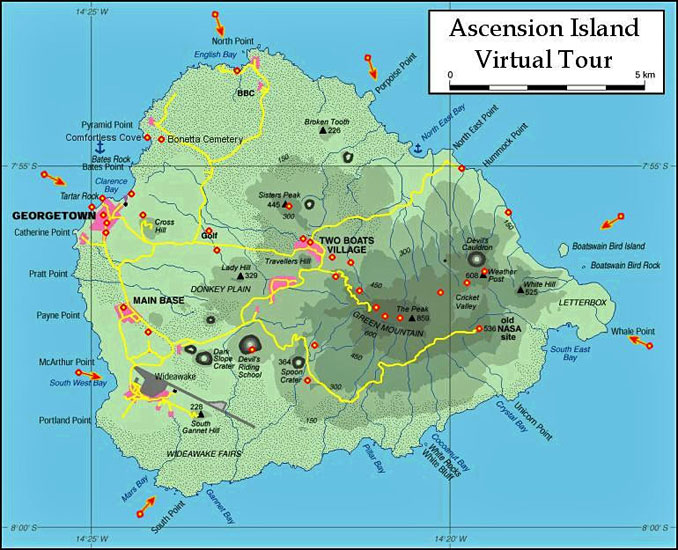
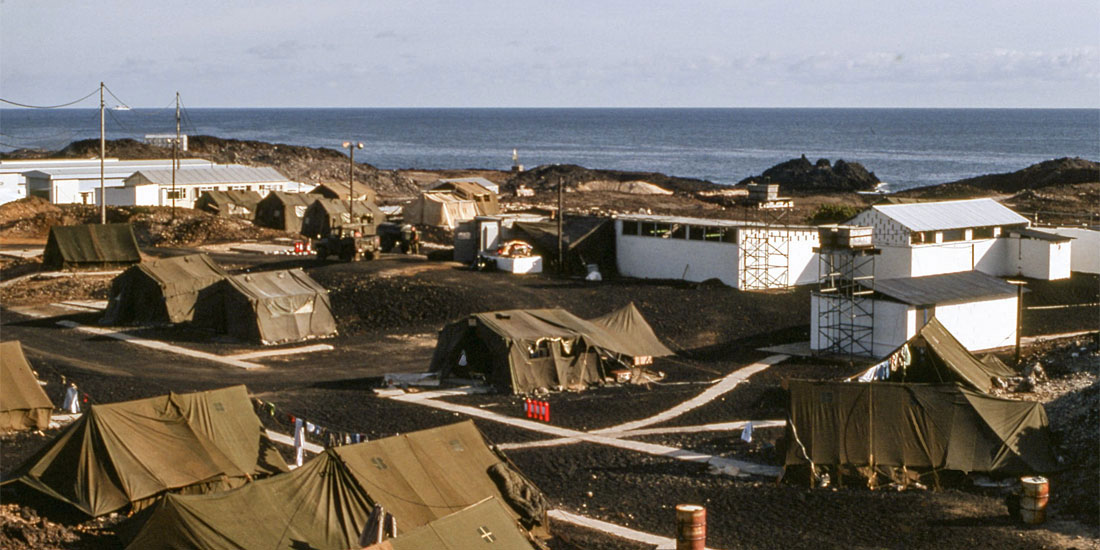
English Bay Tents
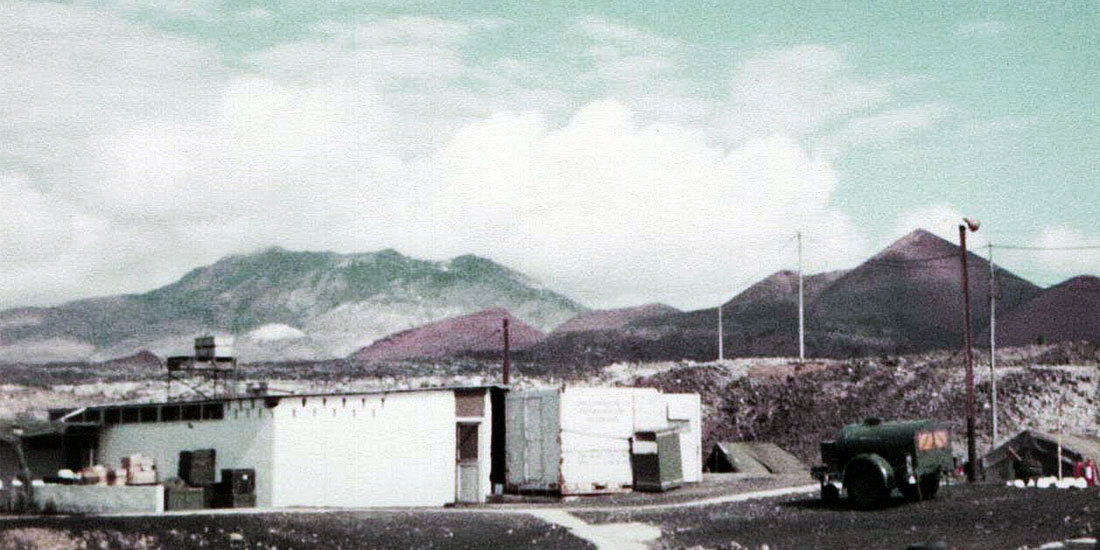
Shower Block
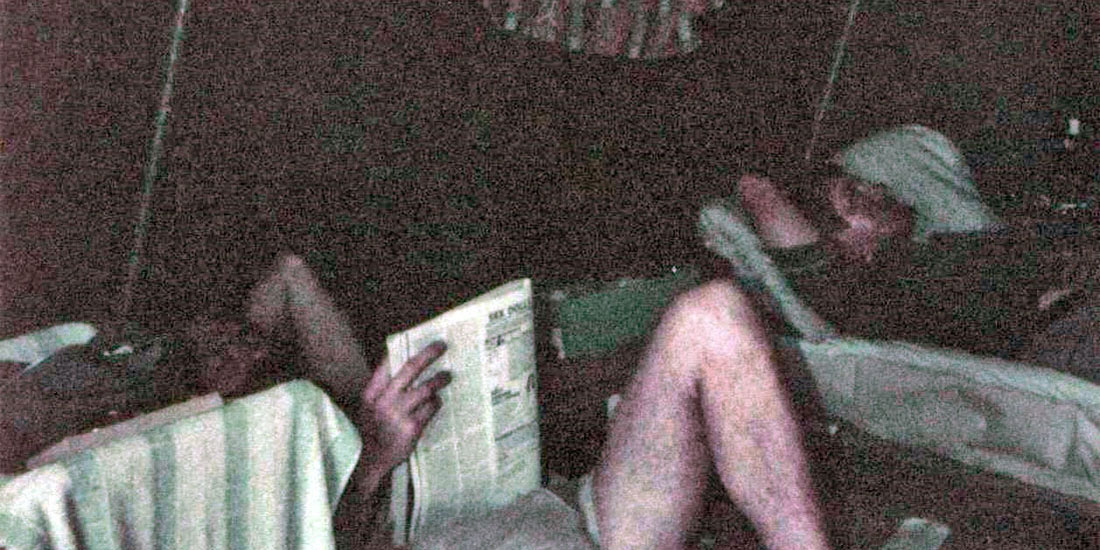
Inside our tent - featuring Paul Newman and Derek Barron
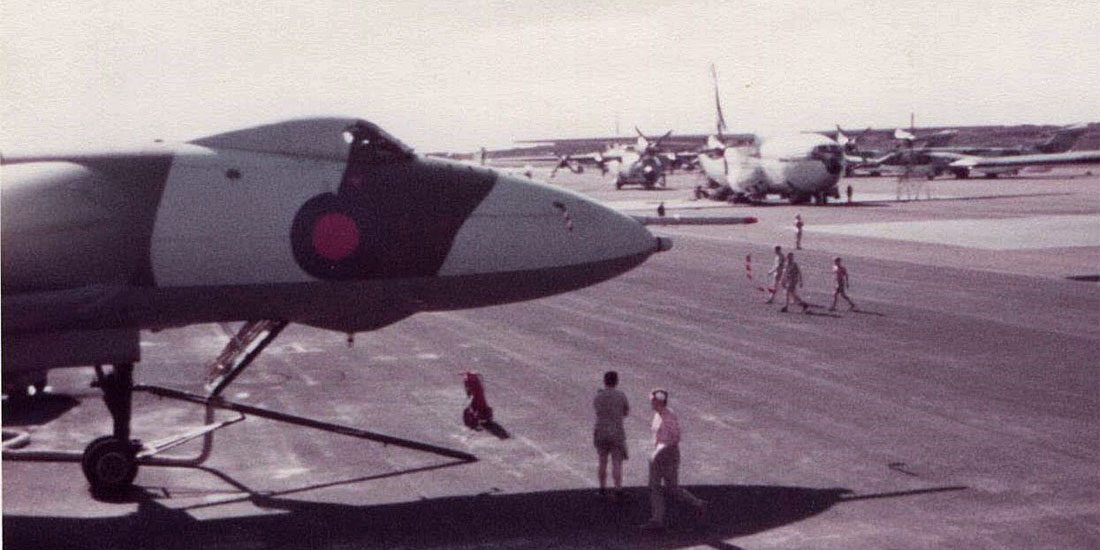
View out of the office window - Black Buck Vulcan, HeavyLift Belfast, C130 and Victors
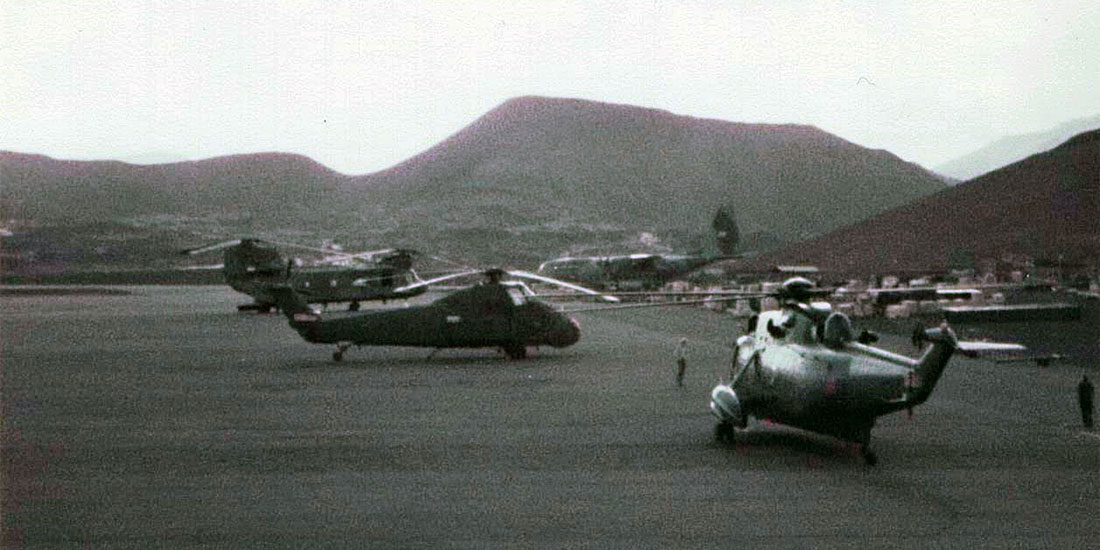
47SF C130 in background with freight "pile" behind!
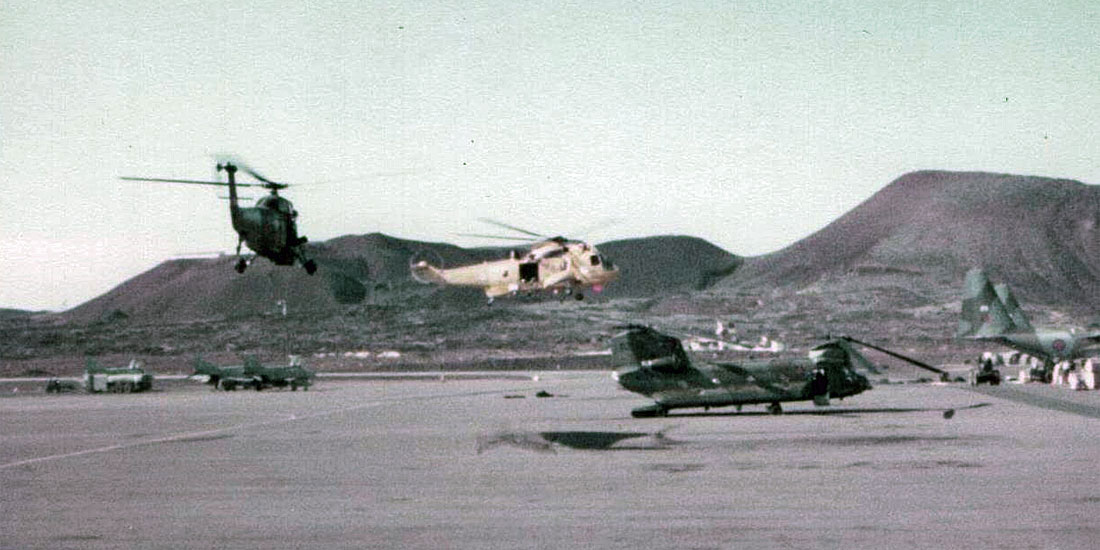
Vertrep in action - Wessex, Sea King and Chinook
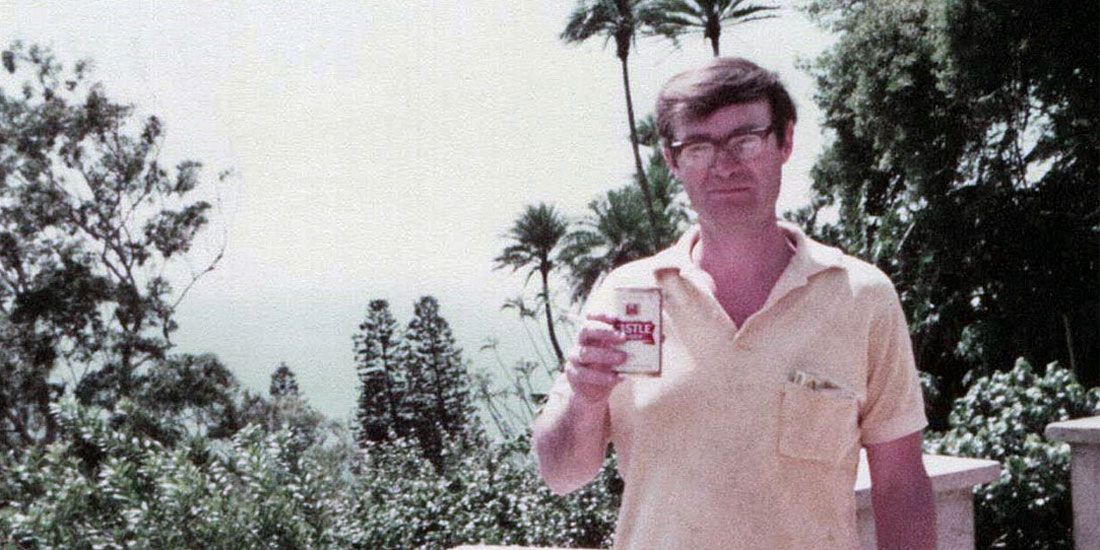
Day off - self having a South African Castle Lager at Two Boats
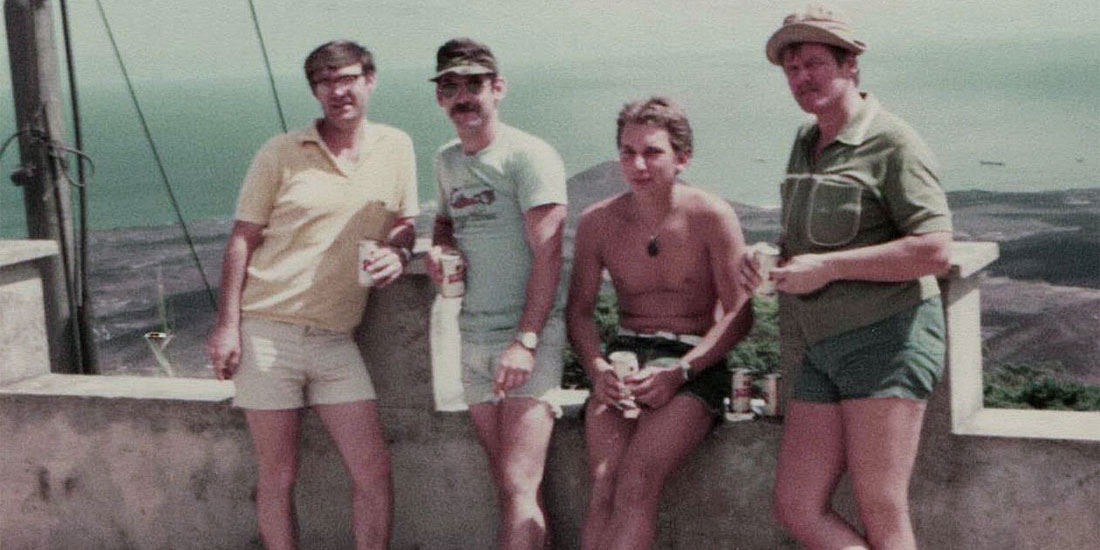
More lager! Self, Paul Newman, Al Brown and Derek Barron
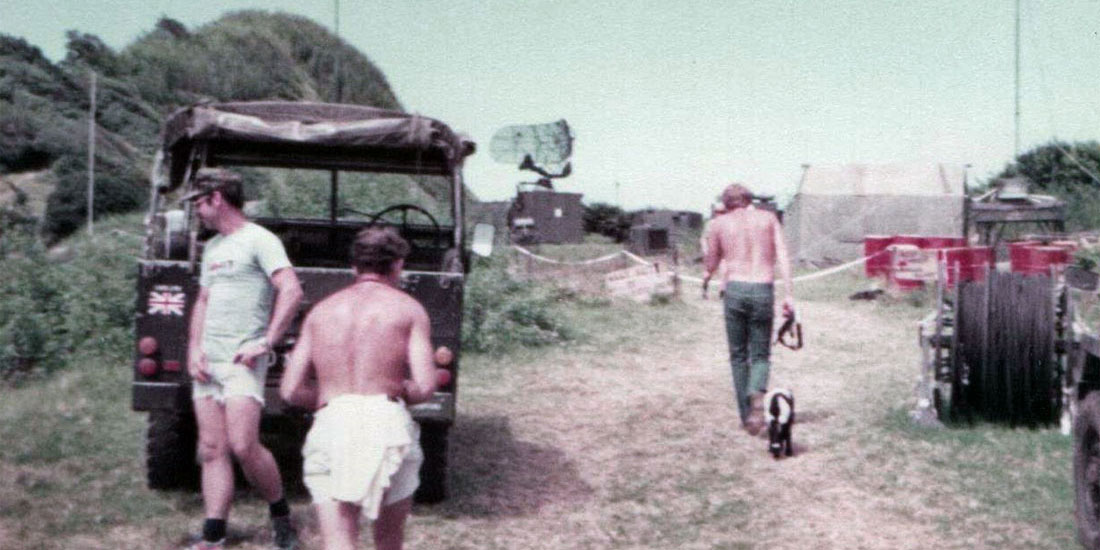
Boulder Radar on Green Mountain - on the left side are Paul Newman and Dinger Bell
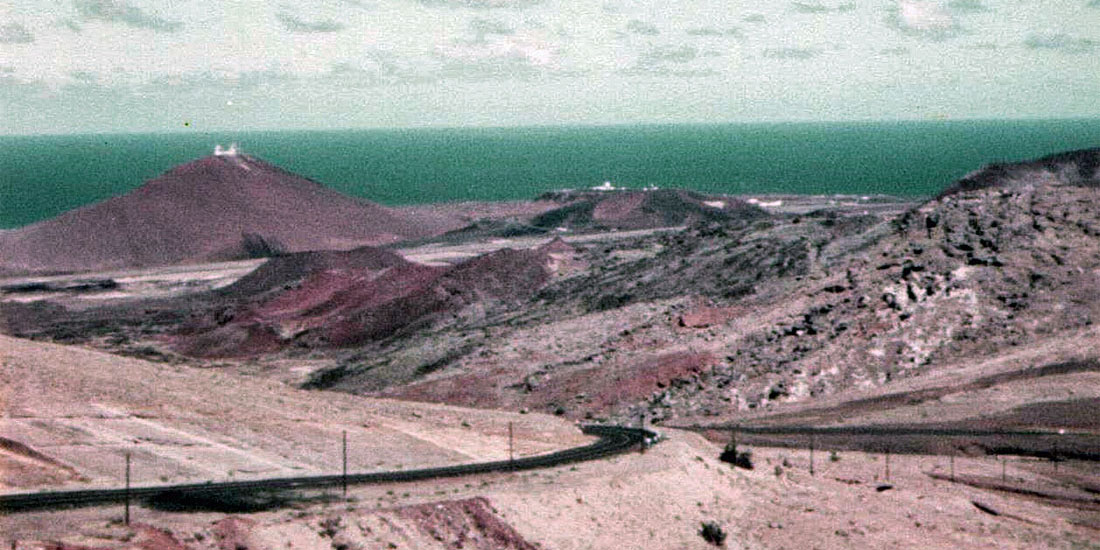
The view from Green Mountain. Wideawake runway can be seen between the volcanoes
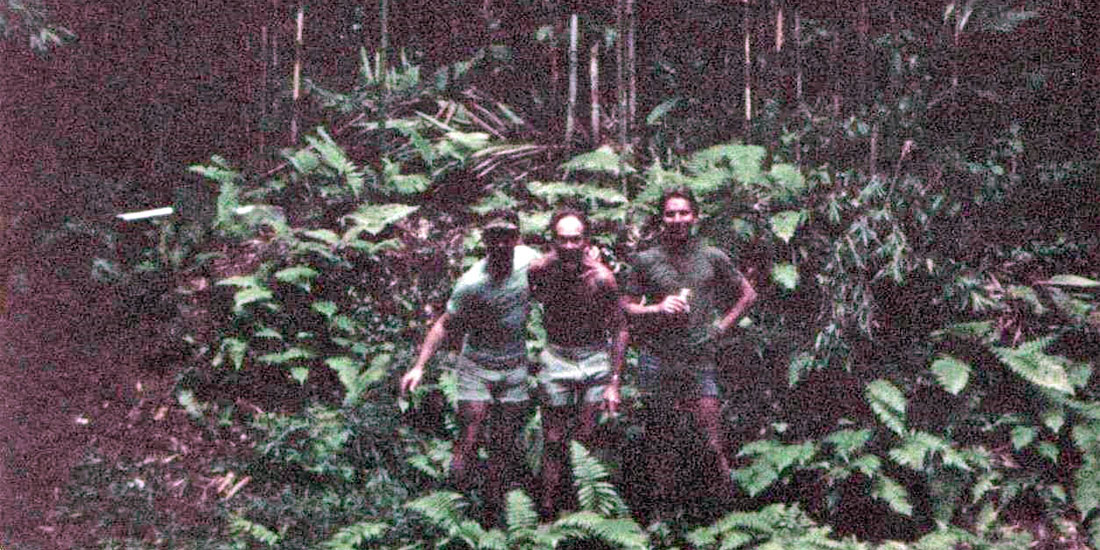
Dew Pond, Green Mountain - Paul Newman, Dinger Bell and Alan Brown
Crowded or what?
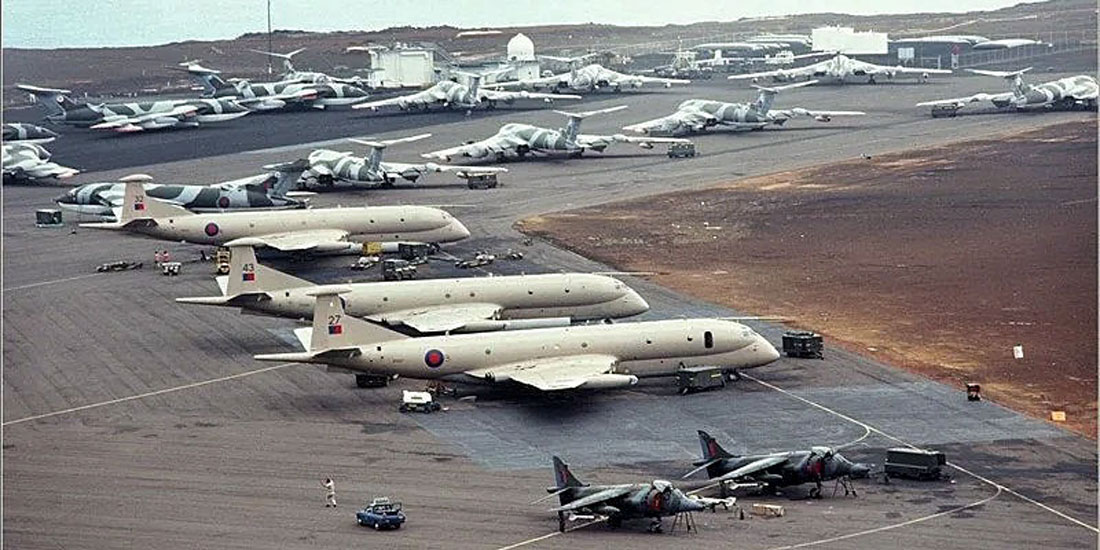


From: Gordon Gray, Powick, Worcs
Subject: My Ghost Laid to Rest! VC10 XV105
Hi Tony, Happy New Year to you and yours and all OBA members!
After 41 years and having just read a brilliant article about RAF VC10’s, including its’ involvement during the Falklands Conflict I wanted to air this revelation. It concerned my involvement the night of 5/6 Jun 1982, location: Load Control, Nose Hangar, Wideawake Airfield, Ascension Island. Fearful was not the word but my actions that night, including those of my team, engendered the gravest of consequences because we knew that very soon the ‘proverbial would hit the fan’
The VC10 had arrived from Dakar on a quick turnaround to depart for Montevideo on a Red Cross mission to uplift casualties of the Falklands Conflict. I was notified that there were some very urgent missile spares for the Harrier force in the Falklands on board which needed to be offloaded and transshipped.
My team out on the pan, having offloaded then repeatedly, and painstakingly searched the aircraft’s holds for some Shrike Missile spares that had not been documented, myself in Load Control frantically making numerous telephone calls to Brize DAMO’s, Cargo shifts and the Officer’s Mess, as to where they were loaded all to no avail.
The aircraft eventually left after an extended delay and what followed was not immediately known until later that morning when yours truly (F.Sgt. Gray) was ‘on the mat’ in front of Peter Gaskin and advised that ‘Questions had been asked in the House’ by PM Mrs Thatcher…... ‘Well Sir, my team searched the aircraft twice, finding no trace of those Shrike spares’
A couple of references to this incident have been made on the OBA web but I only found these full facts in part of the article. Until now, I was not aware of the facts of the spares concealment amongst the aeromedical equipment in the rear hold and in personal belongings in a box!
I wonder if the escorting officer was ever called to account?
Kind regards Tony,
Gordon
Subject: My Ghost Laid to Rest! VC10 XV105
Hi Tony, Happy New Year to you and yours and all OBA members!
After 41 years and having just read a brilliant article about RAF VC10’s, including its’ involvement during the Falklands Conflict I wanted to air this revelation. It concerned my involvement the night of 5/6 Jun 1982, location: Load Control, Nose Hangar, Wideawake Airfield, Ascension Island. Fearful was not the word but my actions that night, including those of my team, engendered the gravest of consequences because we knew that very soon the ‘proverbial would hit the fan’
The VC10 had arrived from Dakar on a quick turnaround to depart for Montevideo on a Red Cross mission to uplift casualties of the Falklands Conflict. I was notified that there were some very urgent missile spares for the Harrier force in the Falklands on board which needed to be offloaded and transshipped.
My team out on the pan, having offloaded then repeatedly, and painstakingly searched the aircraft’s holds for some Shrike Missile spares that had not been documented, myself in Load Control frantically making numerous telephone calls to Brize DAMO’s, Cargo shifts and the Officer’s Mess, as to where they were loaded all to no avail.
The aircraft eventually left after an extended delay and what followed was not immediately known until later that morning when yours truly (F.Sgt. Gray) was ‘on the mat’ in front of Peter Gaskin and advised that ‘Questions had been asked in the House’ by PM Mrs Thatcher…... ‘Well Sir, my team searched the aircraft twice, finding no trace of those Shrike spares’
A couple of references to this incident have been made on the OBA web but I only found these full facts in part of the article. Until now, I was not aware of the facts of the spares concealment amongst the aeromedical equipment in the rear hold and in personal belongings in a box!
I wonder if the escorting officer was ever called to account?
Kind regards Tony,
Gordon
From: Gordon Gray: The following story, "A Spot of Bother", in addition to providing the background to my own tale of woe, gives an insight into what the VC10 operating crew had to endure, even on the outskirts of the Falklands conflict. It's a great read.

From: Mark Holland, Hodnet, Market Drayton, Salop
Subject: Stories from the Falkland Islands War
Hi Tony,
I think Gordon’s story may have been about the wandering Harrier spares.
I remember when it all kicked off, the first shipments out of Brize were food although we didn’t expect the tonnes of tomatoes to be semi-loose. I can’t imagine what it would have been like opening the VC10 vent at the other end.
Kind regards
Mark
Subject: Stories from the Falkland Islands War
Hi Tony,
I think Gordon’s story may have been about the wandering Harrier spares.
I remember when it all kicked off, the first shipments out of Brize were food although we didn’t expect the tonnes of tomatoes to be semi-loose. I can’t imagine what it would have been like opening the VC10 vent at the other end.
Kind regards
Mark


From: Bryan Morgan, Abingdon, Oxon
Subject: Stories from the Falkland Islands War
Tony,
At the height of the Falklands crisis, I was called back to HQ Strike Command from the Supply Control Centre, a merciful release, to become one of the duty officers in the Operations Centre. The shift system was 2 x 12 hour days from 0800 hrs to 2000 hrs followed by 2 x 12 hour night shifts. After a sleep day I then had three days off which was extremely helpful in that our house in Abingdon, purchased 10 years earlier, still needed a lot of work to be done. Over a period of two months I was able to knock it into some form of shape.
One memorable recollection of the war was being called into to our Wing Commander, a fast jet pilot, with absolutely no logistics experience whatsoever, and reprimanded because a siren urgently needed at Stanley airport (which had to be taken from the top of a hangar at RAF Scampton), had failed to to get to its scheduled aircraft at Brize Norton. My plea that others had been at fault fell on deaf ears and I was dismissed with the summary “Life is a delicate balance between high visibility and low profile”, and was invited to consider the latter state for the next 48 hours. The said Wg Cdr retired as an Air Marshal years later, so was I to criticise him?
My other memory of the crisis was a change of Group Captain halfway through the conflict whose first act was to change our 0800-2000 shift patterns to 0300-1500. A torrent of complaints rained down on him with some, like myself, stating that for the night shifts we would have to leave home at 0200. He was having none of it and off we set on the new timetable. It will not surprise that after just one week we reverted back to the former shifts.
Bryan
Subject: Stories from the Falkland Islands War
Tony,
At the height of the Falklands crisis, I was called back to HQ Strike Command from the Supply Control Centre, a merciful release, to become one of the duty officers in the Operations Centre. The shift system was 2 x 12 hour days from 0800 hrs to 2000 hrs followed by 2 x 12 hour night shifts. After a sleep day I then had three days off which was extremely helpful in that our house in Abingdon, purchased 10 years earlier, still needed a lot of work to be done. Over a period of two months I was able to knock it into some form of shape.
One memorable recollection of the war was being called into to our Wing Commander, a fast jet pilot, with absolutely no logistics experience whatsoever, and reprimanded because a siren urgently needed at Stanley airport (which had to be taken from the top of a hangar at RAF Scampton), had failed to to get to its scheduled aircraft at Brize Norton. My plea that others had been at fault fell on deaf ears and I was dismissed with the summary “Life is a delicate balance between high visibility and low profile”, and was invited to consider the latter state for the next 48 hours. The said Wg Cdr retired as an Air Marshal years later, so was I to criticise him?
My other memory of the crisis was a change of Group Captain halfway through the conflict whose first act was to change our 0800-2000 shift patterns to 0300-1500. A torrent of complaints rained down on him with some, like myself, stating that for the night shifts we would have to leave home at 0200. He was having none of it and off we set on the new timetable. It will not surprise that after just one week we reverted back to the former shifts.
Bryan


From: Pat Rowney, Chippenham, Wilts
Subject: Stories from the Falkland Islands War
Tony,
My Falklands experience was unfortunately not a movements one as I was confined to Odiham where, as OC SCAF, I was responsible for much of the preparations to deploy the Chinooks on the containership the Atlantic Conveyor.
Some of my main recollections included sitting a specialist from each of the trades on the Chinook in the Education Section to compile a list of spares needed for the Fly Away Packs (FAP) which hitherto did not exist as the Chinook had only just entered service. The result of this was a wholesale stripping of components such as blades, engines and gearboxes from aircraft in the ASF together with submitting numerous priority 1 demands to create the packs. The latter resulted in a number of phone calls from other OC SCAF’s around the RAF calling to say that they were actioning my priority 1 demand. They were more than surprised when I asked "Which one?" as we had submitted over 200!
Once we had gathered everything together, we submitted a bid for movement and were given a priority call forward to take the FAPs, spare engines, blades and gearboxes etc., plus other support equipment to Plymouth where it would be loaded onto a ship. I clearly recall one of our Corporals who escorted the loads returning and saying that there was the largest ship he had ever seen being loaded at Plymouth and the queue of vehicles waiting stretched back to the motorway! This was of course the Atlantic Conveyor and over the next few days we ran a number of convoys down to the dockside. Fortunately, as the Chinooks were a high priority, our convoys were allowed to bypass the queue and went straight to the ship to be offloaded so we did not have to endure the days of waiting in the queue that some of the lower priority units suffered.
As the result of an urgent operational requirement we received 5 sets of bright yellow dri-clad bags which were used to protect the Chinooks whilst in transit on the ship. These giant zip-up bags made the aircraft look like huge bananas and I often wonder if the 4 Chinooks that went down with the ship are still sitting safely on the seabed in their waterproof bags although I suspect the fire would have melted them! Despite all our efforts everything, except one Chinook, did of course go down with the ship and it took many years for the Chinook force to recover mainly because of the robs that we had carried out on ASF aircraft, particularly the engines which were almost impossible to procure as they were the same as the ones fitted to the Abrams tank which was in the process of being delivered to the US Army.
My final involvement in the Falklands war was to be the butt of many jokes about suppliers adjusting their discrepancies by writing them off against the loss of the ship. I did indeed sign many hundreds of write-offs, including the 4 Chinooks as at the time (and possibly still) to write off a loss due to enemy action only required the signature of a supply officer on a Certificate of Issue Voucher (CIV) which was a tiny pink form. Whilst I was working my way through these, I was buttonholed by the Station Commander, Sandy Hunter, who asked when he was going to write off the Chinooks. I explained that I had already done so as it only needed a supplier and he asked that I reconstitute the 4 CIVs for his signature. I duly provided him with copies which he promptly framed and hung in his loo!
Subject: Stories from the Falkland Islands War
Tony,
My Falklands experience was unfortunately not a movements one as I was confined to Odiham where, as OC SCAF, I was responsible for much of the preparations to deploy the Chinooks on the containership the Atlantic Conveyor.
Some of my main recollections included sitting a specialist from each of the trades on the Chinook in the Education Section to compile a list of spares needed for the Fly Away Packs (FAP) which hitherto did not exist as the Chinook had only just entered service. The result of this was a wholesale stripping of components such as blades, engines and gearboxes from aircraft in the ASF together with submitting numerous priority 1 demands to create the packs. The latter resulted in a number of phone calls from other OC SCAF’s around the RAF calling to say that they were actioning my priority 1 demand. They were more than surprised when I asked "Which one?" as we had submitted over 200!
Once we had gathered everything together, we submitted a bid for movement and were given a priority call forward to take the FAPs, spare engines, blades and gearboxes etc., plus other support equipment to Plymouth where it would be loaded onto a ship. I clearly recall one of our Corporals who escorted the loads returning and saying that there was the largest ship he had ever seen being loaded at Plymouth and the queue of vehicles waiting stretched back to the motorway! This was of course the Atlantic Conveyor and over the next few days we ran a number of convoys down to the dockside. Fortunately, as the Chinooks were a high priority, our convoys were allowed to bypass the queue and went straight to the ship to be offloaded so we did not have to endure the days of waiting in the queue that some of the lower priority units suffered.
As the result of an urgent operational requirement we received 5 sets of bright yellow dri-clad bags which were used to protect the Chinooks whilst in transit on the ship. These giant zip-up bags made the aircraft look like huge bananas and I often wonder if the 4 Chinooks that went down with the ship are still sitting safely on the seabed in their waterproof bags although I suspect the fire would have melted them! Despite all our efforts everything, except one Chinook, did of course go down with the ship and it took many years for the Chinook force to recover mainly because of the robs that we had carried out on ASF aircraft, particularly the engines which were almost impossible to procure as they were the same as the ones fitted to the Abrams tank which was in the process of being delivered to the US Army.
My final involvement in the Falklands war was to be the butt of many jokes about suppliers adjusting their discrepancies by writing them off against the loss of the ship. I did indeed sign many hundreds of write-offs, including the 4 Chinooks as at the time (and possibly still) to write off a loss due to enemy action only required the signature of a supply officer on a Certificate of Issue Voucher (CIV) which was a tiny pink form. Whilst I was working my way through these, I was buttonholed by the Station Commander, Sandy Hunter, who asked when he was going to write off the Chinooks. I explained that I had already done so as it only needed a supplier and he asked that I reconstitute the 4 CIVs for his signature. I duly provided him with copies which he promptly framed and hung in his loo!

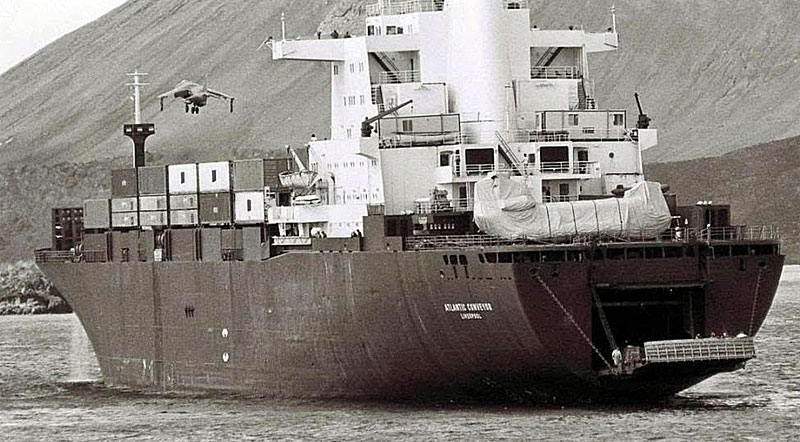
A packaged Chinook "banana" is on the stern of the Atlantic Conveyor whilst
a Harrier is seen taking off from in between the containers on the bow
a Harrier is seen taking off from in between the containers on the bow

From: Roger Whittington, Prescot, Merseyside
Subject: Stories from the Falkland Islands War
Hi Tony, a very happy new year to you and all your readers.
My Falklands stories won’t take long to tell as I don’t really have any! When things started to get serious I was in Akrotiri with 64(R) Phantom OCU squadron on a 6-week APC (Armament Practice Camp). Two years after finishing a two and a half-year tour in Cyprus I was now a newly-promoted corporal based on MSF at RAF Coningsby and I was enjoying my time reacquainting myself with kokkinelli, Keo and kebabs! After lots of urgent meetings we were taken to one side and quietly informed that we would be going to be taking the Phantoms to an airbase in Chile from where CAPs (Combat Air Patrols- basically convoy protection) could be flown. The APC was promptly dismantled and we were flown back to Coningsby and put on 4-hour notice to deploy to the South Atlantic. Unfortunately it turned out that Chile, while willing to give support to the British, did not want to be seen to be launching offensive operations against their next-door neighbours and the plan was scrapped. 29 Squadron did deploy to Ascension Island later on but my OC did not want his pet mover to go with them and leave Coningsby without someone to load any aircraft that might drop in.
As things turned out, the only time I was needed to perform was to load an oxygen trolley onto a Belfast! After a few weeks the C/Tech who originated the trolley came to me complaining that this trolley still hadn’t been received by the squadron in ASI and he wanted to know where the hell it was. I fired off a signal asking for details and the Navy told me exactly where it was, in fact they even gave a map reference for it. It turned out to be somewhere on the South Atlantic ridge, about 2000 feet down. Apparently this trolley had somehow ended up on the deck of one of the Navy ships. (Nice one whoever was doing imports at ASI!) There was an urgent need to cross deck important supplies and, as I have been reliably informed, less important stuff - which included this trolley - was pushed over the side. When I informed the C/Tech from ground eng about this I was so impressed by the shade of red that his face turned. I learnt lots of new swear words that day! So while my comrades were busy turning ASI into the busiest airfield in the world, I was delivering personal effects around Lincolnshire!
Ref the last newsletter’s subject of memorable meals, I hope you’ll allow me to mention mine - sorry it’s late. It’s two meals - both in Penang. The first happened when I was on a global Herc trip. I was with Mike Humphries and the late, great Terry Roberts and it was the first time that I’d visited the Far East which seemed just as exotic and wonderful as I’d been told about by the old crusty muppets. The whole crew crossed to the island on a rusty old ferry and we were met by loads of trishaws that took us to an open-air restaurant where we had the most fantastic Chinese/Malay food under the stars. On the way back to the ferry port all of the trishaws had a race through the narrow streets along the waterfront, it was worth the extra tip!
The second meal took place years later when I was on R and R from Hong Kong. I had spent a brilliant week in Kuala Lumpur and was coming to the end of my time in Penang before I moved onto Singapore. I found a restaurant in the back streets of Georgetown which was signposted as “The Oldest Restaurant in Penang” in which I ate some prawns that were probably left over from the opening night! The results were spectacular to say the least with the words “eye of a needle from ten paces” springing to mind. How I managed to get myself to the airport and then onto a flight to Singapore I will never know. I expect it took Cathay Pacific about three days to clean the aft toilets out though!
Roger
Subject: Stories from the Falkland Islands War
Hi Tony, a very happy new year to you and all your readers.
My Falklands stories won’t take long to tell as I don’t really have any! When things started to get serious I was in Akrotiri with 64(R) Phantom OCU squadron on a 6-week APC (Armament Practice Camp). Two years after finishing a two and a half-year tour in Cyprus I was now a newly-promoted corporal based on MSF at RAF Coningsby and I was enjoying my time reacquainting myself with kokkinelli, Keo and kebabs! After lots of urgent meetings we were taken to one side and quietly informed that we would be going to be taking the Phantoms to an airbase in Chile from where CAPs (Combat Air Patrols- basically convoy protection) could be flown. The APC was promptly dismantled and we were flown back to Coningsby and put on 4-hour notice to deploy to the South Atlantic. Unfortunately it turned out that Chile, while willing to give support to the British, did not want to be seen to be launching offensive operations against their next-door neighbours and the plan was scrapped. 29 Squadron did deploy to Ascension Island later on but my OC did not want his pet mover to go with them and leave Coningsby without someone to load any aircraft that might drop in.
As things turned out, the only time I was needed to perform was to load an oxygen trolley onto a Belfast! After a few weeks the C/Tech who originated the trolley came to me complaining that this trolley still hadn’t been received by the squadron in ASI and he wanted to know where the hell it was. I fired off a signal asking for details and the Navy told me exactly where it was, in fact they even gave a map reference for it. It turned out to be somewhere on the South Atlantic ridge, about 2000 feet down. Apparently this trolley had somehow ended up on the deck of one of the Navy ships. (Nice one whoever was doing imports at ASI!) There was an urgent need to cross deck important supplies and, as I have been reliably informed, less important stuff - which included this trolley - was pushed over the side. When I informed the C/Tech from ground eng about this I was so impressed by the shade of red that his face turned. I learnt lots of new swear words that day! So while my comrades were busy turning ASI into the busiest airfield in the world, I was delivering personal effects around Lincolnshire!
Ref the last newsletter’s subject of memorable meals, I hope you’ll allow me to mention mine - sorry it’s late. It’s two meals - both in Penang. The first happened when I was on a global Herc trip. I was with Mike Humphries and the late, great Terry Roberts and it was the first time that I’d visited the Far East which seemed just as exotic and wonderful as I’d been told about by the old crusty muppets. The whole crew crossed to the island on a rusty old ferry and we were met by loads of trishaws that took us to an open-air restaurant where we had the most fantastic Chinese/Malay food under the stars. On the way back to the ferry port all of the trishaws had a race through the narrow streets along the waterfront, it was worth the extra tip!
The second meal took place years later when I was on R and R from Hong Kong. I had spent a brilliant week in Kuala Lumpur and was coming to the end of my time in Penang before I moved onto Singapore. I found a restaurant in the back streets of Georgetown which was signposted as “The Oldest Restaurant in Penang” in which I ate some prawns that were probably left over from the opening night! The results were spectacular to say the least with the words “eye of a needle from ten paces” springing to mind. How I managed to get myself to the airport and then onto a flight to Singapore I will never know. I expect it took Cathay Pacific about three days to clean the aft toilets out though!
Roger


From: Barry Tappenden, Shortstown, Beds
Subject: Stories from the Falkland Islands War
Good morning Tony, from a pretty chilly UK!
When I was deployed to the Falklands, after the war, I was put in charge of Heli-Replen, petrol station for helicopters. One of the many tasks that befell me was to walk the pipeline everyday through a known minefield. The Argentinians had laid numerous plastic mines on the shoreline and the pipeline stretched from the airfield to the offshore tanker. The weather conditions, strong winds, use to blow (badly selected word!!) the mines across the sands and inevitably close to the pipes.
One fine sunny day I was walking the pipeline when I saw a couple, doing horizontal exercises, in the middle of the minefield! (They just had a new intake of NAAFI girls) As I was “wired” up, a quick call to the ops to get the stand-by “teeny weeny airways” helicopter to investigate and extract. The couple were so engrossed in their activity that they didn’t hear the approaching “chopper” (sorry) so the pilot approached them and sand blasted a protruding naked buttock. They say sand gets in everywhere!!
Best regards
Barry
Subject: Stories from the Falkland Islands War
Good morning Tony, from a pretty chilly UK!
When I was deployed to the Falklands, after the war, I was put in charge of Heli-Replen, petrol station for helicopters. One of the many tasks that befell me was to walk the pipeline everyday through a known minefield. The Argentinians had laid numerous plastic mines on the shoreline and the pipeline stretched from the airfield to the offshore tanker. The weather conditions, strong winds, use to blow (badly selected word!!) the mines across the sands and inevitably close to the pipes.
One fine sunny day I was walking the pipeline when I saw a couple, doing horizontal exercises, in the middle of the minefield! (They just had a new intake of NAAFI girls) As I was “wired” up, a quick call to the ops to get the stand-by “teeny weeny airways” helicopter to investigate and extract. The couple were so engrossed in their activity that they didn’t hear the approaching “chopper” (sorry) so the pilot approached them and sand blasted a protruding naked buttock. They say sand gets in everywhere!!
Best regards
Barry


UK bringing 20,000 troops to exercise with USA and other NATO allies
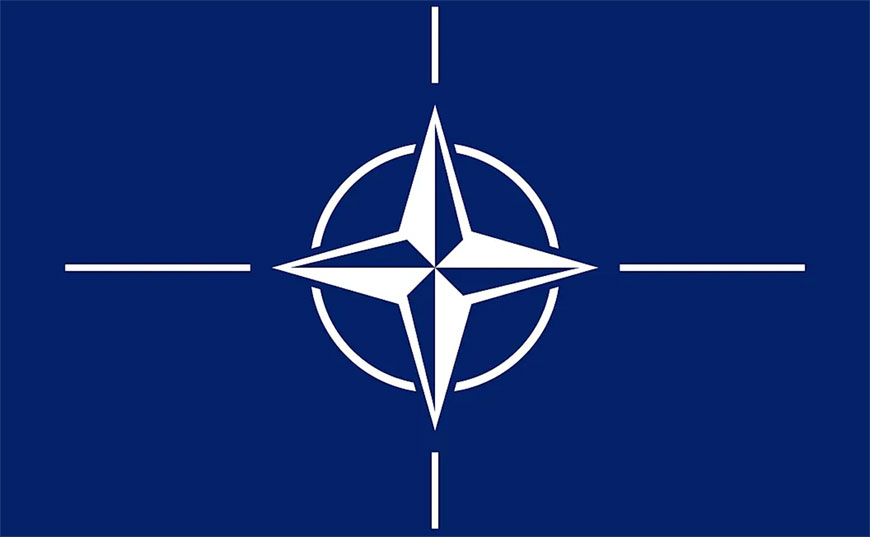
This year, the U.K. will send 20,000 troops to Steadfast Defender, NATO’s largest combat drill since the Cold War, British Defense Secretary Grant Shapps announced Jan. 16, 2024.
The United Kingdom will soon dispatch 20,000 troops to an exercise bringing together thousands of American and other allied militaries for maneuvers across Europe, making it NATO’s largest combat drill since the Cold War. British Defense Secretary Grant Shapps on Monday announced the U.K.’s contribution to exercise Steadfast Defender, saying it is about sending a message of deterrence at a time of security upheaval on the Continent. “Battle lines are being redrawn,” Shapps said in a statement. “The tanks are literally on Ukraine’s lawn. And the foundations of the world order are being shaken to their core. We stand at a crossroads.”
Steadfast Defender, which will run from February to June, is expected to serve as a testing ground for new NATO defense plans designed to counter the threat posed by Russia.
The Royal Air Force’s most modern fighter jets and surveillance aircraft, along with Royal Navy warships and submarines and a full range of ground forces, are among the elements to be deployed, the Defense Ministry said.
Stars and Stripes
The United Kingdom will soon dispatch 20,000 troops to an exercise bringing together thousands of American and other allied militaries for maneuvers across Europe, making it NATO’s largest combat drill since the Cold War. British Defense Secretary Grant Shapps on Monday announced the U.K.’s contribution to exercise Steadfast Defender, saying it is about sending a message of deterrence at a time of security upheaval on the Continent. “Battle lines are being redrawn,” Shapps said in a statement. “The tanks are literally on Ukraine’s lawn. And the foundations of the world order are being shaken to their core. We stand at a crossroads.”
Steadfast Defender, which will run from February to June, is expected to serve as a testing ground for new NATO defense plans designed to counter the threat posed by Russia.
The Royal Air Force’s most modern fighter jets and surveillance aircraft, along with Royal Navy warships and submarines and a full range of ground forces, are among the elements to be deployed, the Defense Ministry said.
Stars and Stripes

A question about the strength of the British Armed Forces has once again highlighted a consistent decrease in personnel numbers across the British Army, Royal Navy, and Royal Air Force since the turn of the millennium. The figures, disclosed in a parliamentary written question by SNP MP for Kilmarnock and Loudoun, Alan Brown, and answered by Parliamentary Under-Secretary for the Ministry of Defence, Andrew Murrison, paint a concerning picture of the diminishing size of the UK’s military forces.
The statistics indicate that since the year 2000, the British Army has seen its numbers fall from 109,600 to 76,950 in 2023, marking a significant reduction of nearly 30%. Similarly, the Royal Navy and Royal Marines have not been spared, with their numbers dwindling from 42,800 to 32,590 in the same period. The Royal Air Force has experienced a similar downward trajectory, with personnel numbers dropping from 54,600 to 31,940.
The percent reduction in personnel for each service since the year 2000 is as follows:
British Army: Reduced by approximately 29.79%
Royal Navy and Royal Marines: Reduced by approximately 23.86%
Royal Air Force: Reduced by approximately 41.50%
See: "Britain’s ruling elite back call for conscription..." later in this issue
The statistics indicate that since the year 2000, the British Army has seen its numbers fall from 109,600 to 76,950 in 2023, marking a significant reduction of nearly 30%. Similarly, the Royal Navy and Royal Marines have not been spared, with their numbers dwindling from 42,800 to 32,590 in the same period. The Royal Air Force has experienced a similar downward trajectory, with personnel numbers dropping from 54,600 to 31,940.
The percent reduction in personnel for each service since the year 2000 is as follows:
British Army: Reduced by approximately 29.79%
Royal Navy and Royal Marines: Reduced by approximately 23.86%
Royal Air Force: Reduced by approximately 41.50%
See: "Britain’s ruling elite back call for conscription..." later in this issue
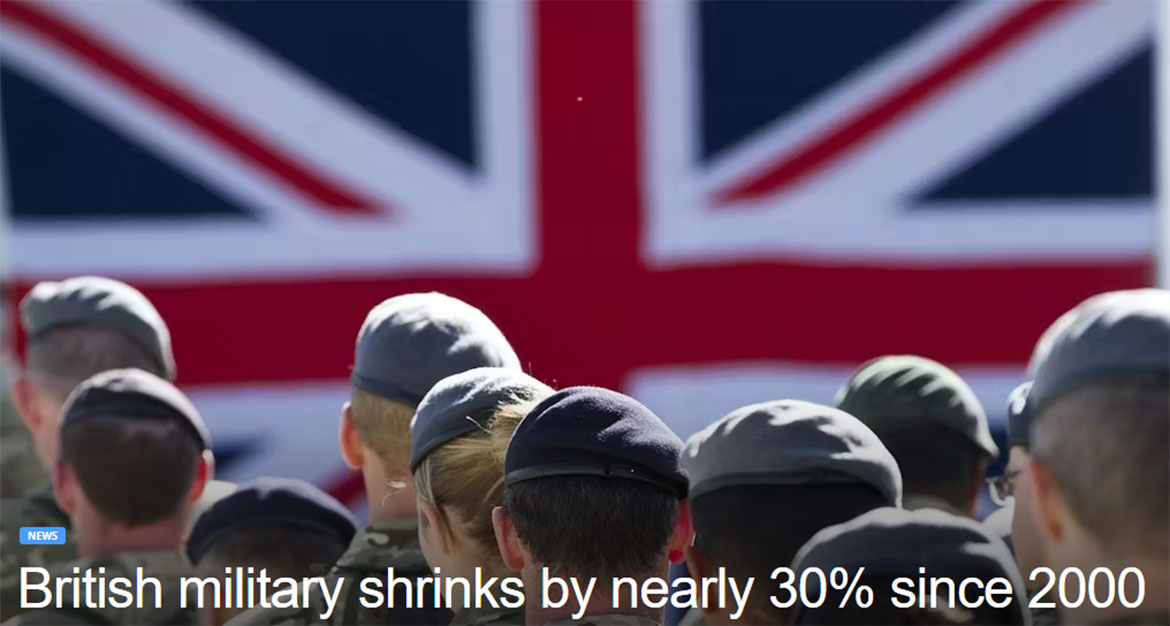

From: Harold Jones, Neston, Cheshire
Subject: Stories from the Falkland Islands War
Tony,
I left the Royal Air Force in April 1975 and after some years in the Middle East, on contract work, I came home, to Neston and started looking for a job. After a couple of years just marking time, Marconi Space and Defence Services opened a new manufacturing site in Neston just up the road to produce a new torpedo called Sting Ray. I applied and was successful as a Standards Control Engineer. Move on a few years and I was a Senior Engineer, responsible for certifying, to the Ministry man, that each torpedo was fit for use and met the required specifications.
Then came the Falklands Conflict. Both Sting Ray and the old Mk 24 were in great demand, we were working long hours to meet the demand.
It brought back memories of Brize Norton when Turkey invaded Cyprus and our runway was being resurfaced, so we had to work out of a moth balled Fairford. That was long hard work as well to meet the demand and with only basic equipment and not much of that! Just like being back on UKMAMS.
So, that was my Falklands war.
Harold
Subject: Stories from the Falkland Islands War
Tony,
I left the Royal Air Force in April 1975 and after some years in the Middle East, on contract work, I came home, to Neston and started looking for a job. After a couple of years just marking time, Marconi Space and Defence Services opened a new manufacturing site in Neston just up the road to produce a new torpedo called Sting Ray. I applied and was successful as a Standards Control Engineer. Move on a few years and I was a Senior Engineer, responsible for certifying, to the Ministry man, that each torpedo was fit for use and met the required specifications.
Then came the Falklands Conflict. Both Sting Ray and the old Mk 24 were in great demand, we were working long hours to meet the demand.
It brought back memories of Brize Norton when Turkey invaded Cyprus and our runway was being resurfaced, so we had to work out of a moth balled Fairford. That was long hard work as well to meet the demand and with only basic equipment and not much of that! Just like being back on UKMAMS.
So, that was my Falklands war.
Harold


From: Dave Green, Huntingdon, Cambs
Subject: Stories from the Falkland Islands War
Hi Tony,
I never got to the Falklands, but I did do a safe-hand-of-escort task taking dispatches to Maj Gen Jeremey Moore on his return to the UK via Ascension. I handed the documents to him and was supposed to then get straight back on the returning VC10. I was surrounded by troops returning with him to the UK who didn't have seats for several days, so I offloaded myself to offer up a seat to a more needy passenger. I stayed on ASI for several days with Simon Baxter and Jerry Allen.
Whilst I was at Coningsby as OC TSF in '83, we sent out the first Phantoms to defend the FI and I got copies of many of the detachment's photos. I have enclosed a few which may be of interest to the readership
Rgds
Dave Green
Subject: Stories from the Falkland Islands War
Hi Tony,
I never got to the Falklands, but I did do a safe-hand-of-escort task taking dispatches to Maj Gen Jeremey Moore on his return to the UK via Ascension. I handed the documents to him and was supposed to then get straight back on the returning VC10. I was surrounded by troops returning with him to the UK who didn't have seats for several days, so I offloaded myself to offer up a seat to a more needy passenger. I stayed on ASI for several days with Simon Baxter and Jerry Allen.
Whilst I was at Coningsby as OC TSF in '83, we sent out the first Phantoms to defend the FI and I got copies of many of the detachment's photos. I have enclosed a few which may be of interest to the readership
Rgds
Dave Green
Coming Ashore
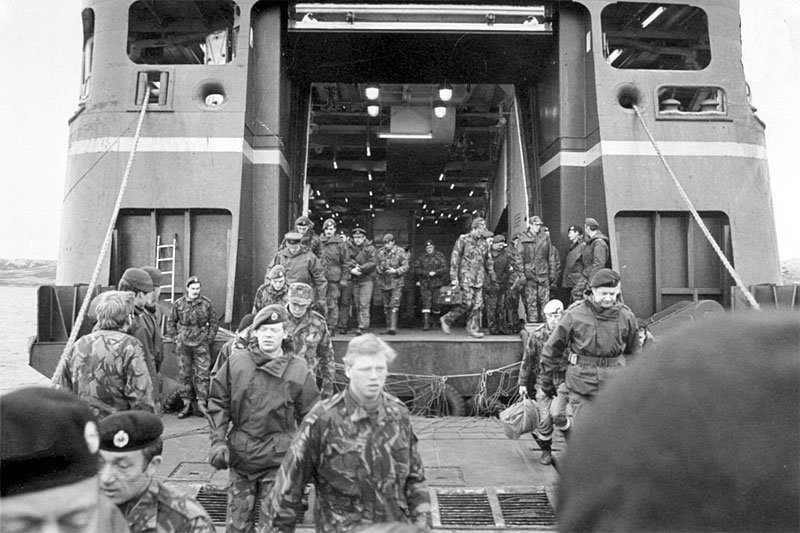
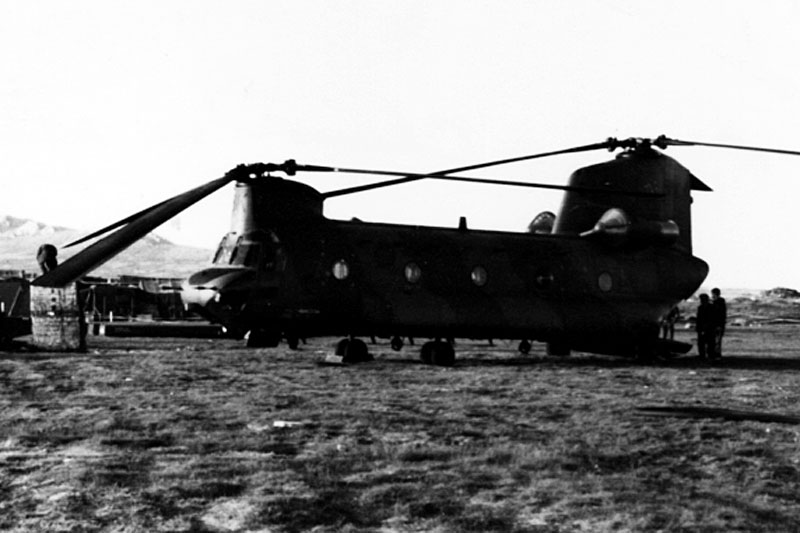
Chinook on refuelling point
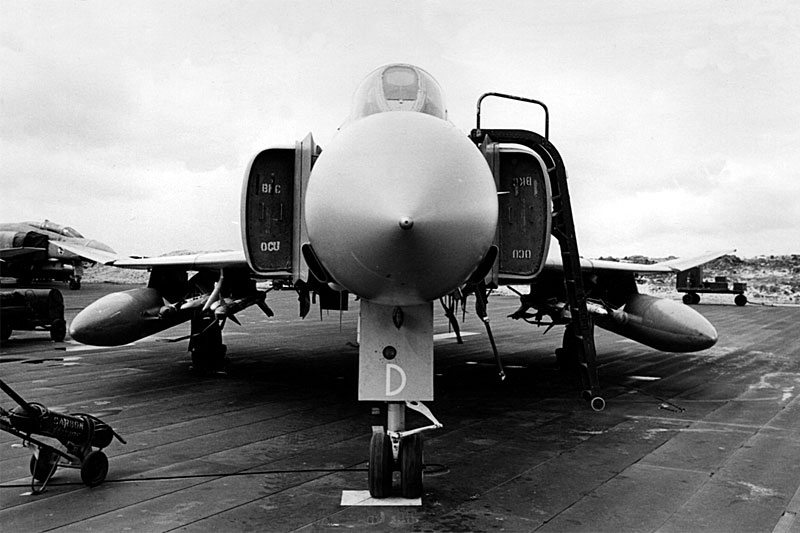
29 Squadron Phantom
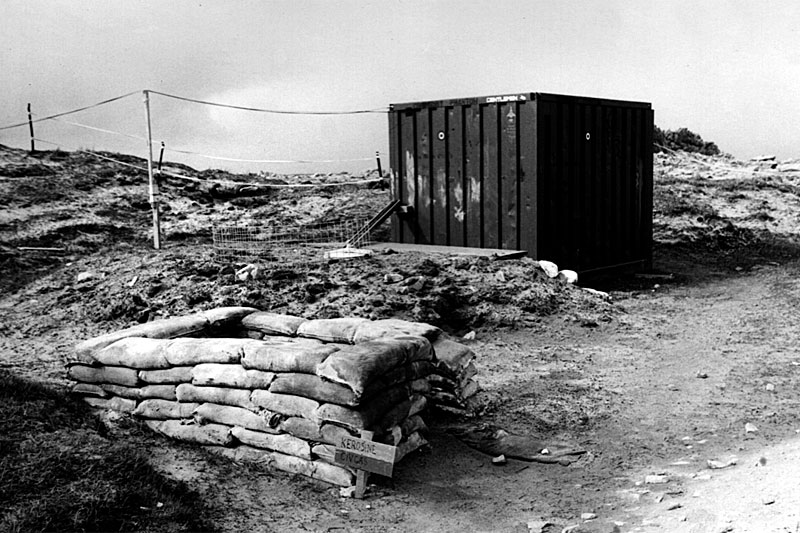
Daily Express: "Best Rated Crapper"
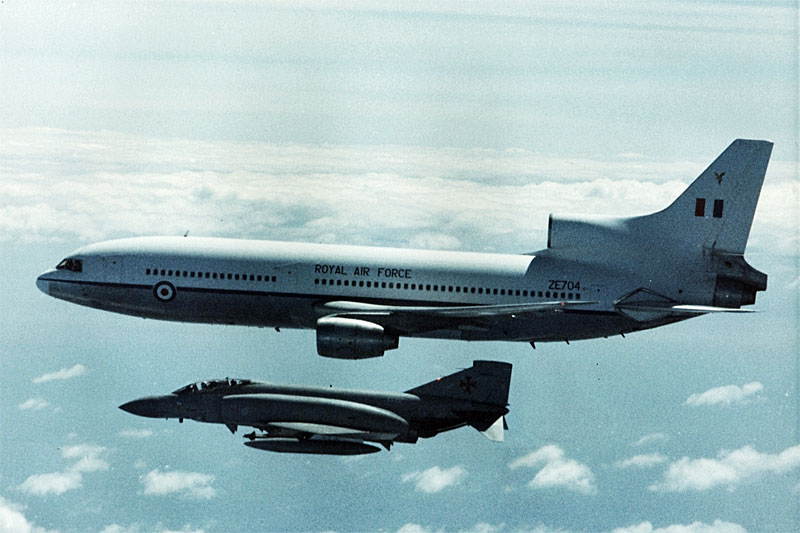
29 Squadron Performing Escort Duties
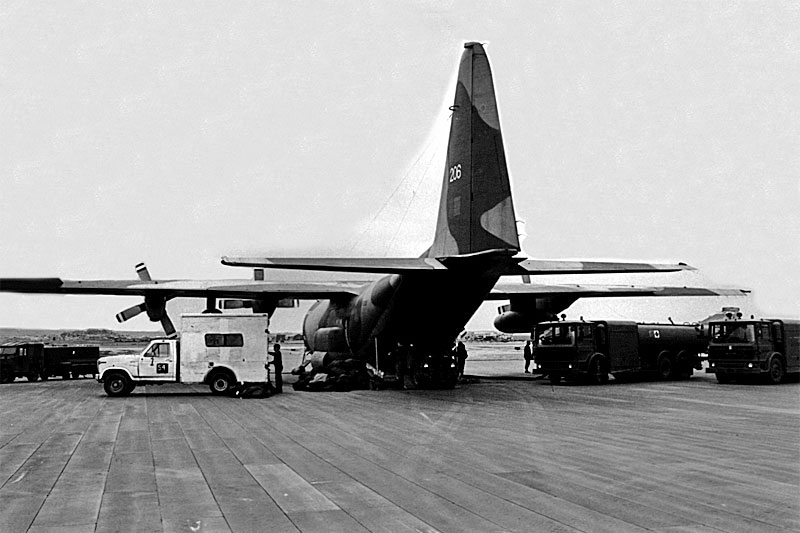
Offloading BFPO Mail
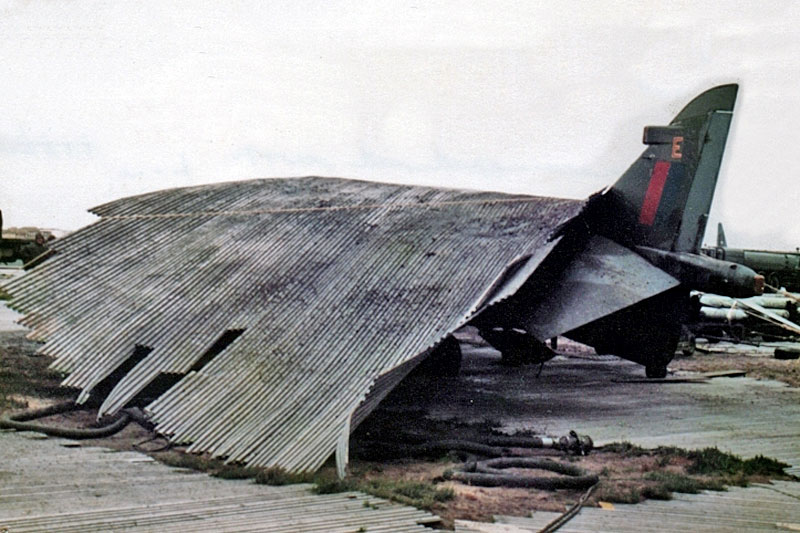
Ooops! Move along - nothing to see here!
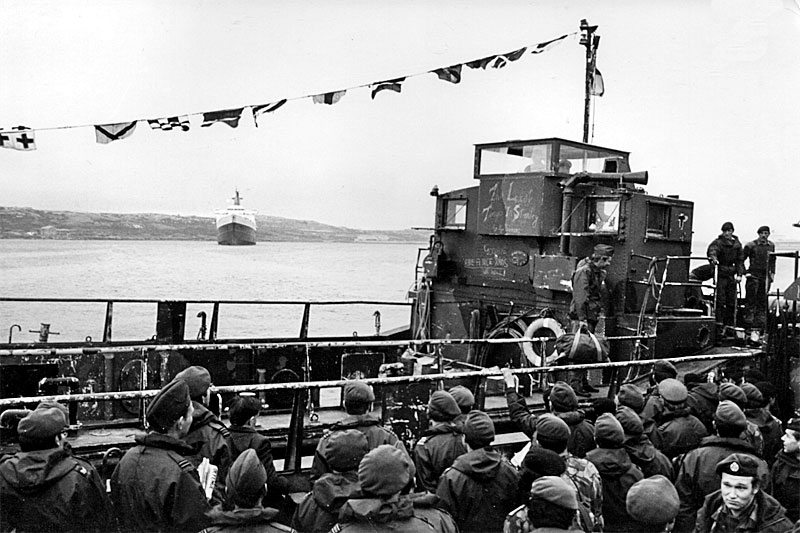
Landing Craft Crews Arriving Home
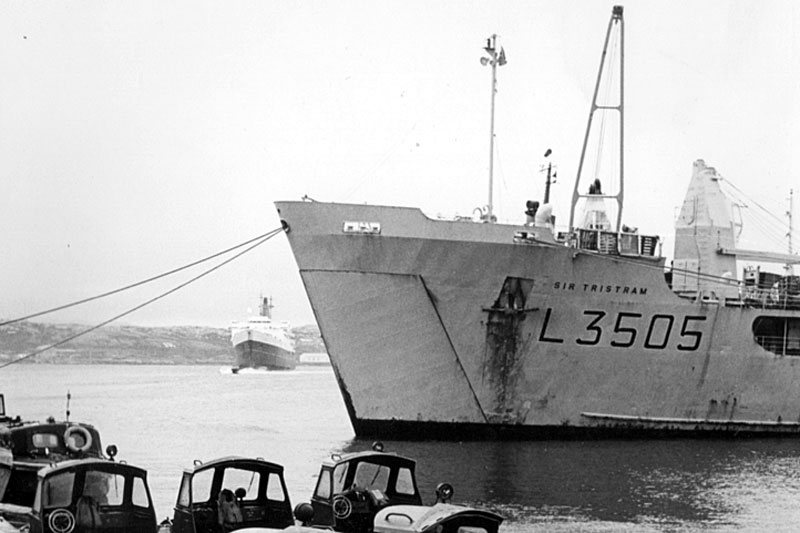
Sir Tristram and MV Rangatiri

Apply for an HM Armed Forces Veteran Card
An HM Armed Forces Veteran Card is a way to prove that you served in the UK armed forces. The card can make it quicker and easier to apply for support as a veteran.
It’s free to apply: https://www.gov.uk/veteran-card
You can currently only apply for a Veteran Card if you have a UK address. Veterans who do not have a UK address will be able to apply later this year.
It’s free to apply: https://www.gov.uk/veteran-card
You can currently only apply for a Veteran Card if you have a UK address. Veterans who do not have a UK address will be able to apply later this year.

OPERATION CORPORATE - THE SANTE FE
By Ian Berry
By Ian Berry
On the 25th May 1982, HMS's Antrim, Brilliant, Plymouth and Endurance had been despatched to retake the Island of South Georgia. The Argentine Submarine, Santa Fe, was spotted on radar by the Wessex HAS 3 from HMS Antrim. They promptly dropped two Mk11 depth charges which caused internal damage to the submarine. A Lynx HAS 2 from HMS Brilliant then launched a Mk 46 torpedo but it went under the Sub as it was designed to attack submerged vessels. A Wasp HAS 1 from HMS Plymouth followed by two more from HMS Endurance fired AS12 Air-to-Surface missiles and damaged the fin and conning tower. The Santa Fe limped back to Grytviken Harbour and the crew began to return fire. However, several helicopters now started to strafe the resistors and they surrendered. The Agentine Marine Party refused to surrender but did so the next day, 26th May. All the Argentine submarine crew and Marines were now POWs and were transferred to RFA Tidespring on which they were eventually brought back to Ascension Island. There they were processed and in due course returned to Uruguay, a neutral country, on board a chartered Red Cross Aircraft.

POWs inside RFA Tidespring after arriving at Ascension Island
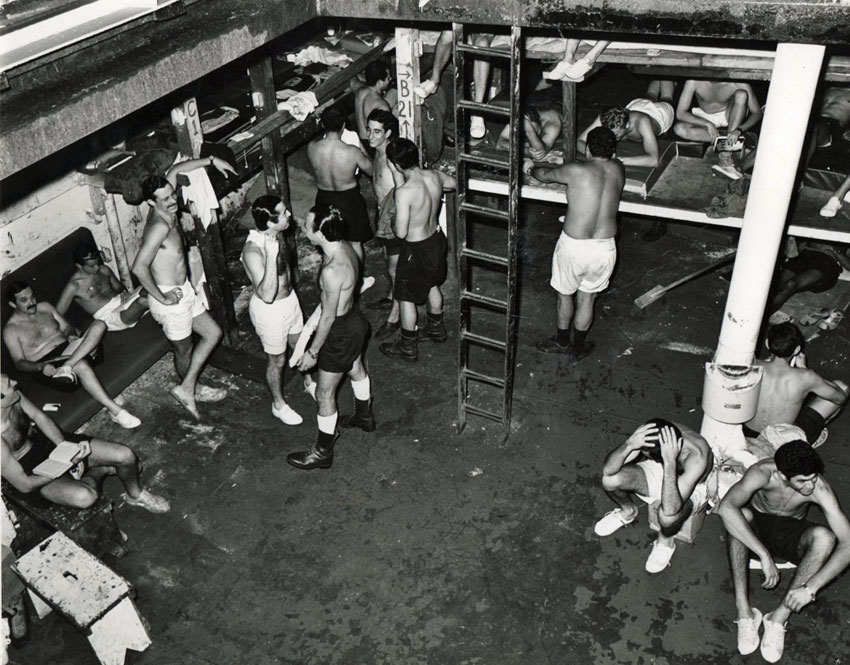
Ship's Officers arriving at the airfield in a blacked out minibus.
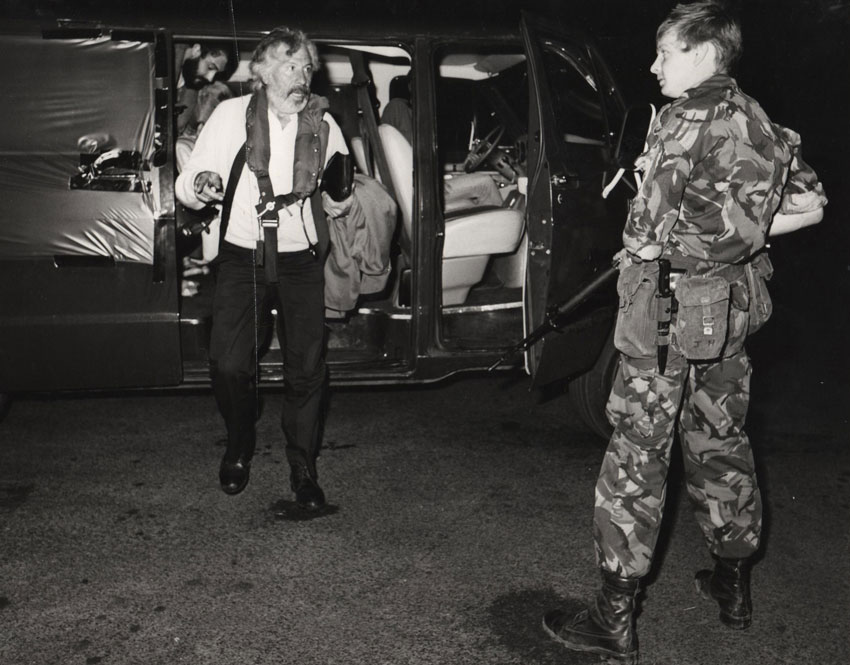
FO John Buchanan (UKMAMS) checking off POWs against manifests
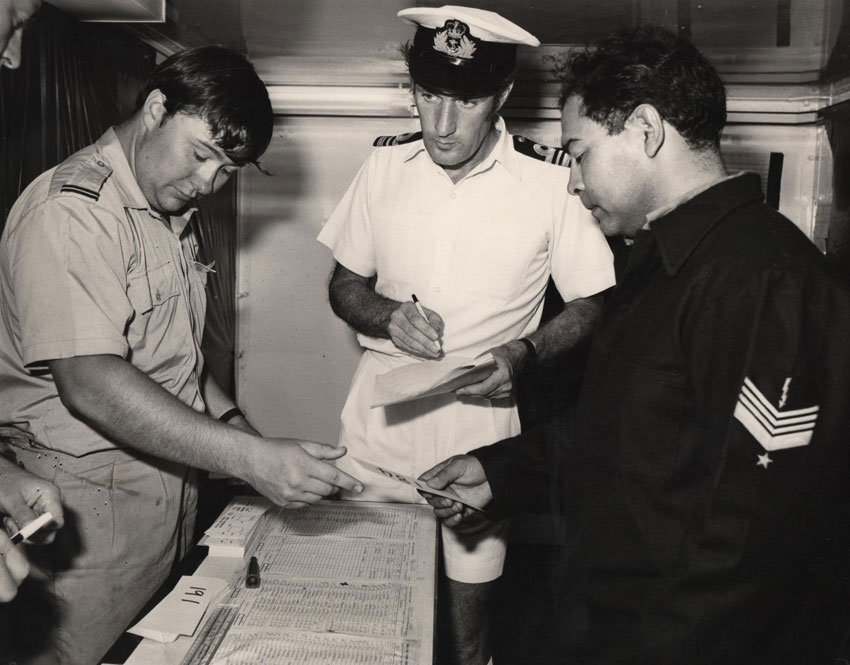
Corporal Alberto Macias, an Argentinian sailor who had a leg amputated
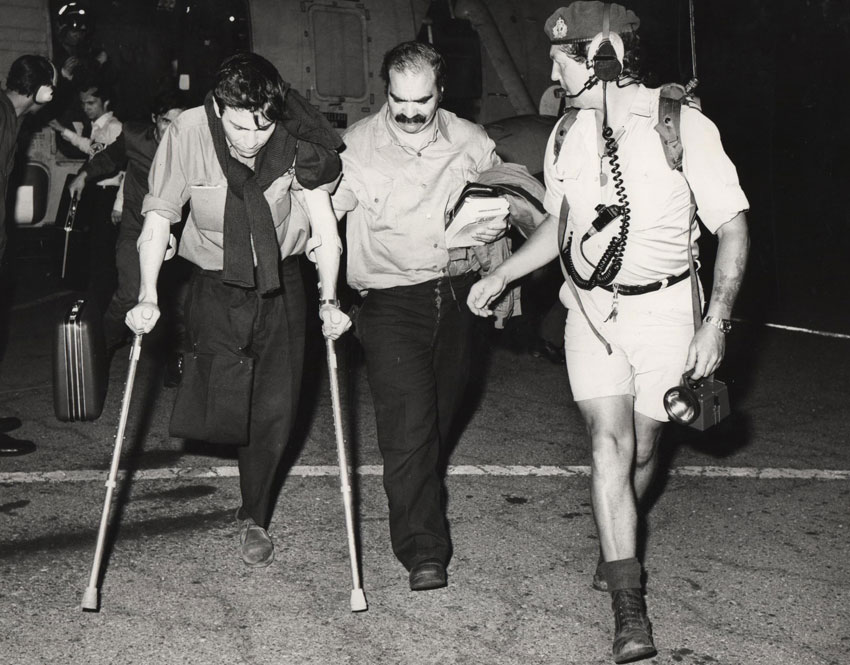
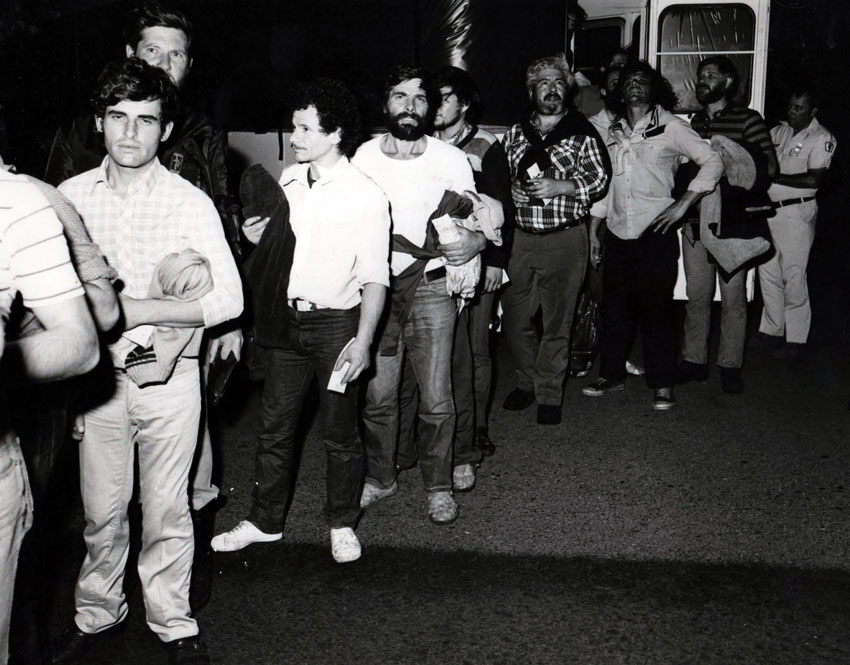
Santa Fe crew awaiting processing
Royal Marines on patrol at the abandoned Argentine submarine ARA Santa Fe at South Georgia. Two liners, SS Canberra and Queen Elizabeth 2, can be seen in the background. (Photo: Imperial War Museum)
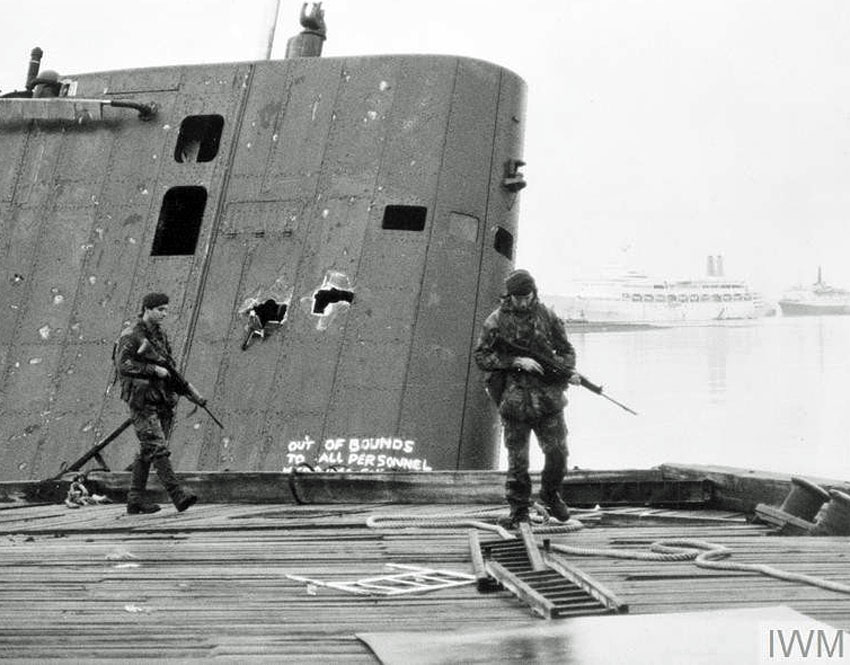

A new member who has joined us recently:
Welcome to the OBA!
Joe Fisher, Dunfermline

From: Dave Salmon, Springfield, OR
Subject: Stories from the Falkland Islands War
Hi Tony,
In February 1982, I finished MAMS training and joined Bravo team. The team consisted of PO Joe Joseph, F/Sgt Stu Everett, Sgt John McClymont (Sr), no Cpl, but 3 SACs, SAC Steve Perry, SAC Kit Kitson, and of course myself. Bravo team was on standby during the week of the 29 March - 02 April 1982, Joe was away on task. With the escalation of the Argentinian invasion, we expected to be deployed at any time.
On 01 April 1982 with kit packed for the Falklands, Bravo team was tasked; Flt/Lt Jim Stewart became the team leader. We took off from Lyneham on C130 XV196, Flt #4742 at 23.59, our destination Gibraltar. The load consisted of a track radar unit and 2 TCW guys. We arrived in Gibraltar on the 02 April at 04.06 and by then the Falklands had been invaded. On the 03 April, just after midnight, we took off for Ascension Island; after an 11.30-hour flight we finally arrived.
For the first few days it was pretty quiet, then we started to receive aircraft, and we became extremely busy. I can’t remember how long, but eventually a Belfast landed with another team on board. After they were rested, we went into a 2-shift rotation of 12 hours each. Around 10 April the Royal Navy began to arrive. The aircraft went from returning home empty to being filled with empty beer barrels; the RN had been on exercise before arriving in Ascension.
During our month in Ascension, the Argentinians "supposedly landed on Ascension". Aircraft en-route were returned to Dakar, aircraft already landed were hurriedly turned around and took off; it turned out to be a false alarm, no invasion had taken place. On the 20 April, a VC10 from Montevideo staged through Ascension carrying Sir Rex Hunt*, his wife and the Falklands Royal Marine detachment. The Track Radar unit was loaded on a ship heading to the Falklands, along with the 2 TCW chaps. On the 30 April, we watched as the two Vulcans took off for their bombing run on Stanley. One eventually returned after going u/s, the other carried on and bombed the runway at Port Stanley in the early hours 01 May.
Kit returned to the UK earlier than the rest of us due to a vacation he had booked, the rest of Bravo Team departed on a VC10 to the UK via Dakar on the 05 May, arriving at Brize the 06 May 1982. Steve and I returned to Ascension for 6 weeks, 20 July - 01 September 1982, a week late due to our previous 4-day trip to the USA, turning into a 12-day trip. I eventually made it to the Falklands for a 4-month detachment, Apr 1987 - Aug 1987, but that's another story.
Some of my memory of what occurred almost 42 years ago may be a little hazy, but after picking Steve Perry's brain it should be pretty accurate. I do recall when the Royal Navy arrived they had us move from on-base accommodation to English Bay, and the ensuing battle for control of the operation by the RN. Moving to English Bay was actually a good thing, as we spent most of the time on the beach even though we had spotted Hammerhead sharks before landing. Lastly, I learnt a valuable lesson when packing for a task, no matter the destination always pack shorts, t-shirts and swimming trunks. On request to MAMS Ops, they did send us pairs of WWII shorts, that on me hung down to my ankles and wouldn't stay up because they were too large, although now they might fit.
Best regards
Dave
*Sir Rex Masterman Hunt, CMG (29 June 1926 – 11 November 2012) was a British Government diplomat and colonial administrator. He was Governor, Commander-in-Chief, and Vice Admiral of the Falkland Islands (and concurrently High Commissioner of the British Antarctic Territory) between 1980 and September 1985. He became a household name in the United Kingdom during the Falklands War, after the Argentine invasion of the islands in 1982, when he was taken prisoner and temporarily removed from his position.
Subject: Stories from the Falkland Islands War
Hi Tony,
In February 1982, I finished MAMS training and joined Bravo team. The team consisted of PO Joe Joseph, F/Sgt Stu Everett, Sgt John McClymont (Sr), no Cpl, but 3 SACs, SAC Steve Perry, SAC Kit Kitson, and of course myself. Bravo team was on standby during the week of the 29 March - 02 April 1982, Joe was away on task. With the escalation of the Argentinian invasion, we expected to be deployed at any time.
On 01 April 1982 with kit packed for the Falklands, Bravo team was tasked; Flt/Lt Jim Stewart became the team leader. We took off from Lyneham on C130 XV196, Flt #4742 at 23.59, our destination Gibraltar. The load consisted of a track radar unit and 2 TCW guys. We arrived in Gibraltar on the 02 April at 04.06 and by then the Falklands had been invaded. On the 03 April, just after midnight, we took off for Ascension Island; after an 11.30-hour flight we finally arrived.
For the first few days it was pretty quiet, then we started to receive aircraft, and we became extremely busy. I can’t remember how long, but eventually a Belfast landed with another team on board. After they were rested, we went into a 2-shift rotation of 12 hours each. Around 10 April the Royal Navy began to arrive. The aircraft went from returning home empty to being filled with empty beer barrels; the RN had been on exercise before arriving in Ascension.
During our month in Ascension, the Argentinians "supposedly landed on Ascension". Aircraft en-route were returned to Dakar, aircraft already landed were hurriedly turned around and took off; it turned out to be a false alarm, no invasion had taken place. On the 20 April, a VC10 from Montevideo staged through Ascension carrying Sir Rex Hunt*, his wife and the Falklands Royal Marine detachment. The Track Radar unit was loaded on a ship heading to the Falklands, along with the 2 TCW chaps. On the 30 April, we watched as the two Vulcans took off for their bombing run on Stanley. One eventually returned after going u/s, the other carried on and bombed the runway at Port Stanley in the early hours 01 May.
Kit returned to the UK earlier than the rest of us due to a vacation he had booked, the rest of Bravo Team departed on a VC10 to the UK via Dakar on the 05 May, arriving at Brize the 06 May 1982. Steve and I returned to Ascension for 6 weeks, 20 July - 01 September 1982, a week late due to our previous 4-day trip to the USA, turning into a 12-day trip. I eventually made it to the Falklands for a 4-month detachment, Apr 1987 - Aug 1987, but that's another story.
Some of my memory of what occurred almost 42 years ago may be a little hazy, but after picking Steve Perry's brain it should be pretty accurate. I do recall when the Royal Navy arrived they had us move from on-base accommodation to English Bay, and the ensuing battle for control of the operation by the RN. Moving to English Bay was actually a good thing, as we spent most of the time on the beach even though we had spotted Hammerhead sharks before landing. Lastly, I learnt a valuable lesson when packing for a task, no matter the destination always pack shorts, t-shirts and swimming trunks. On request to MAMS Ops, they did send us pairs of WWII shorts, that on me hung down to my ankles and wouldn't stay up because they were too large, although now they might fit.
Best regards
Dave
*Sir Rex Masterman Hunt, CMG (29 June 1926 – 11 November 2012) was a British Government diplomat and colonial administrator. He was Governor, Commander-in-Chief, and Vice Admiral of the Falkland Islands (and concurrently High Commissioner of the British Antarctic Territory) between 1980 and September 1985. He became a household name in the United Kingdom during the Falklands War, after the Argentine invasion of the islands in 1982, when he was taken prisoner and temporarily removed from his position.


From: Clive Price, Brecon
Subject: Stories from the Falkland Islands War
Hello Tony,
I had been put out to pasture 12 years before this kicked off and I was working for the army where the brigades were training in Wales. The troops were giving us tins of South American corned beef from their rations that they didn't feel like eating. We didn't mind and gladly accepted it!
A good friend of mine who was in the RAF Regiment (airfield defence) was paired with another, firing tracer rounds from the ship’s machine guns. They homed in on an Argentinean jet fighter, saw a puff of smoke coming out of the engine and watched the pilot bail out over land. My friend didn’t get a medal, but felt he had done a good job.
Cheers!
Taff Price
Subject: Stories from the Falkland Islands War
Hello Tony,
I had been put out to pasture 12 years before this kicked off and I was working for the army where the brigades were training in Wales. The troops were giving us tins of South American corned beef from their rations that they didn't feel like eating. We didn't mind and gladly accepted it!
A good friend of mine who was in the RAF Regiment (airfield defence) was paired with another, firing tracer rounds from the ship’s machine guns. They homed in on an Argentinean jet fighter, saw a puff of smoke coming out of the engine and watched the pilot bail out over land. My friend didn’t get a medal, but felt he had done a good job.
Cheers!
Taff Price


OPERATION CORPORATE – THE EARLY STAGES
By Ian Berry
By Ian Berry
This article was written for and already published in my local U3A Aviation Group newsletter. It is aimed at keen aviation enthusiasts and NOT Movers.
On 13th May, 1982, I was tasked to take a “scratch” Team on a “special” VC10 task to Pope AFB and then Dulles before returning to the UK. Along with myself, my team consisted of five Corporals, “Dinger”, Paddy, Hammy, Steve and “Smudge”, one of our Engineers. Never before or since have I ever had a team full of Corporals.
Our brief was to take a VC10 full freighter to Pope AFB and then collect a “classified” load from Fort Bragg for the special forces and recover to UK. (We weren’t aware but mid-task Ascot Ops debated whether to divert us straight to Ascension once loaded... ). After loading at Pope AFB, we were to carry on to Dulles and collect 800lbs of “chaff”. The briefing was straightforward, extra equipment was ordered and we departed from Brize Norton that night. I spoke to the aircraft captain who was very much “on side” and he promised me his crew would give all the assistance they could.
We duly arrived on VC10 XV102 at Pope AFB at 22.00 local time. The enormity of the task then hit us as three large US Army truckloads of freight arrived, all vehicles carrying explosives labels stating UN Class 1. Each truck was crammed with crates and the load seemed to be too much to fit inside the fuselage.
Each item was about 3 ft long and 1ft high and wide and wrapped inside a crate. I spoke to the US Army Ammunition Technician (Ammo Tech) who confirmed it was safe to remove all this outer packaging and just transport the item in it’s own metal case. We began the loading of the aircraft, with the US personnel assisting. As time progressed a huge mountain of discarded timber was piling up alongside the K Loader operated by the USAF outside the aircraft.
As we progressed, the aircraft captain enquired as to our progress. I was grateful his crew were keeping out of the way and allowing us to get on with our task. This did not include the female Air Loadmaster who told the captain she would be checking our work and demanding it be done her way. To our amazement he told her that she would do no such thing, keep out of our way and the steward and herself were to keep us supplied with hot drinks! (I am not being feminist as this “M*A*S*H moment” actually happened).
By the time we had worked down the fuselage and made six large netted stacks, there was still a sizeable amount of freight left on one of the vehicles. At this stage the aircraft captain again asked how we were coping and could we get all the load on board? I had to advise that we were “bulking out” but if the RAF regulations were just a bit more flexible we could have achieved it. He asked me what I meant and I said that apart from safety class ammunition, we were not allowed to load explosives to the lower holds. Once again, to my utter amazement and gratitude forever he said “You have my authority to utilise the lower holds, we are in a conflict and our troops need this equipment!”
Consequently we managed to load all the explosives and leave some room for the 800lbs of chaff to be collected at Dulles. At this stage I had also met our two passengers we were taking back to UK with the load. One was from 22 SAS and the other was a US Ranger. I must admit they were like “Chalk & Cheese”, the Brit was stone faced, unfriendly and quiet whereas the American was the opposite. One was an expert on the munitions being carried and the other had been trained to operate and train others on return to UK.
Our brief was to take a VC10 full freighter to Pope AFB and then collect a “classified” load from Fort Bragg for the special forces and recover to UK. (We weren’t aware but mid-task Ascot Ops debated whether to divert us straight to Ascension once loaded... ). After loading at Pope AFB, we were to carry on to Dulles and collect 800lbs of “chaff”. The briefing was straightforward, extra equipment was ordered and we departed from Brize Norton that night. I spoke to the aircraft captain who was very much “on side” and he promised me his crew would give all the assistance they could.
We duly arrived on VC10 XV102 at Pope AFB at 22.00 local time. The enormity of the task then hit us as three large US Army truckloads of freight arrived, all vehicles carrying explosives labels stating UN Class 1. Each truck was crammed with crates and the load seemed to be too much to fit inside the fuselage.
Each item was about 3 ft long and 1ft high and wide and wrapped inside a crate. I spoke to the US Army Ammunition Technician (Ammo Tech) who confirmed it was safe to remove all this outer packaging and just transport the item in it’s own metal case. We began the loading of the aircraft, with the US personnel assisting. As time progressed a huge mountain of discarded timber was piling up alongside the K Loader operated by the USAF outside the aircraft.
As we progressed, the aircraft captain enquired as to our progress. I was grateful his crew were keeping out of the way and allowing us to get on with our task. This did not include the female Air Loadmaster who told the captain she would be checking our work and demanding it be done her way. To our amazement he told her that she would do no such thing, keep out of our way and the steward and herself were to keep us supplied with hot drinks! (I am not being feminist as this “M*A*S*H moment” actually happened).
By the time we had worked down the fuselage and made six large netted stacks, there was still a sizeable amount of freight left on one of the vehicles. At this stage the aircraft captain again asked how we were coping and could we get all the load on board? I had to advise that we were “bulking out” but if the RAF regulations were just a bit more flexible we could have achieved it. He asked me what I meant and I said that apart from safety class ammunition, we were not allowed to load explosives to the lower holds. Once again, to my utter amazement and gratitude forever he said “You have my authority to utilise the lower holds, we are in a conflict and our troops need this equipment!”
Consequently we managed to load all the explosives and leave some room for the 800lbs of chaff to be collected at Dulles. At this stage I had also met our two passengers we were taking back to UK with the load. One was from 22 SAS and the other was a US Ranger. I must admit they were like “Chalk & Cheese”, the Brit was stone faced, unfriendly and quiet whereas the American was the opposite. One was an expert on the munitions being carried and the other had been trained to operate and train others on return to UK.

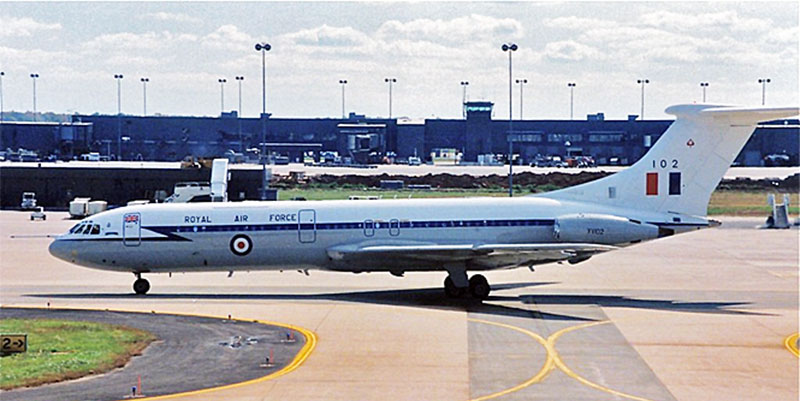
VC10 XV102 (Guy Gibson VC) at Dulles
Some 4hrs 30mins after landing we departed again for our 45 minutes flight on to Dulles. On arrival there we were met by the RAFLO who advised us that the ‘chaff’ we were expecting from Texas had been delayed. This was because just that morning the Airline, Braniff, which the freight had been booked on had gone bankrupt! These things happen but to help make our enforced delay comfortable we were booked into an Airport Hotel for a few hours. The RAFLO had also advised us that once again back in UK they were considering sending us straight on down to Wideawake. Not a clever option for us as we were all in ‘blues’ and Ascension was close to the Equator. In the event this did not happen. After a couple of hours rest we were back at the aircraft and onloading the ‘chaff’ freight that had delayed us. So it was just 9hrs after arriving we were on our way again back to Brize Norton.
Our task was complete once we arrived back in UK. The freight itself was divided up and some forwarded straight to Ascension and the remainder left for Hereford or an ammunition unit at Kineton.
Some four days later, on the 18th May, I deployed myself with my team to Ascension and worked on a three-shift system for the next several weeks until after the Falklands were retaken and a ceasefire agreed. During that time I also ‘bumped’ into the ‘not so grey chap’ from the SAS who I had brought back from the States and he was even more annoyed when I recognised him! The main SAS chap I dealt with in my time there was ‘Taff’ the Quartermaster and a more friendly chap you couldn’t meet.
What was the equipment we picked up from Fort Bragg? It was many years later that I discovered the items were known as M202A1 FLASH (Flame Assault Shoulder) launched 66mm rockets. They were the replacement for the old flame throwers. They were installed inside a four tube suitcase style container. Activated with a trigger they can be fired singularly or all four together. These items were still in use by the SAS during the Gulf Wars and the US Army still had them in Afghanistan.
Our task was complete once we arrived back in UK. The freight itself was divided up and some forwarded straight to Ascension and the remainder left for Hereford or an ammunition unit at Kineton.
Some four days later, on the 18th May, I deployed myself with my team to Ascension and worked on a three-shift system for the next several weeks until after the Falklands were retaken and a ceasefire agreed. During that time I also ‘bumped’ into the ‘not so grey chap’ from the SAS who I had brought back from the States and he was even more annoyed when I recognised him! The main SAS chap I dealt with in my time there was ‘Taff’ the Quartermaster and a more friendly chap you couldn’t meet.
What was the equipment we picked up from Fort Bragg? It was many years later that I discovered the items were known as M202A1 FLASH (Flame Assault Shoulder) launched 66mm rockets. They were the replacement for the old flame throwers. They were installed inside a four tube suitcase style container. Activated with a trigger they can be fired singularly or all four together. These items were still in use by the SAS during the Gulf Wars and the US Army still had them in Afghanistan.

RAF Tests Airbus A400M Tactical Refuelling in the Arctic
The UK's Royal Air Force (RAF) has successfully refueled one of its Airbus A400M transport aircraft via a tactical fuel system in the bitter Arctic cold. The exercise took place in Norway in an extreme cold environment.
A team from the RAF's No 1 Expeditionary Logistics Squadron built the temporary fuel system - known as Air Landed Aircraft Refuelling System (ALARS) - with a fabric tank supported by snow-filled sandbags. The team then successfully de-fueled, then refueled, an Atlas A400M military transport at Bardufoss Air Station (BDU) located in the northern region of Norway.
a400m refueling team
This represents the first time the RAF has successfully deployed this type of refueling system in extreme Arctic conditions. While the air base is operated by the Royal Norwegian Air Force, it is often used as a training center for British military forces looking to enhance their cold weather capabilities.
Flight Lieutenant Woodhouse, Fuels Support Team Lead, commented, "In collaboration with other Force Elements, we have worked to enhance tactical refueling capability under challenging conditions. We’ve been able to test and prove the ALARS capability in the High North for the first time, with valuable support from our Norwegian partners."
The refueling test was part of the RAF's Exercise Arctic Phoenix, which is training personnel to operate under challenging Arctic conditions. During the winter, there is only limited daylight in polar regions, not to mention the sub-zero temperatures and challenging icy terrain. The idea behind the exercise was to test the RAF's capability to maintain air operations in extreme, remote regions like the Arctic, a concept it calls Agile Combat Deployment. As explained by the RAF, "the ability to maintain flying operations from remote and austere locations is vital to the RAF being ready to survive or evade attack and outmaneuver an adversary."
simpleflying.com
A team from the RAF's No 1 Expeditionary Logistics Squadron built the temporary fuel system - known as Air Landed Aircraft Refuelling System (ALARS) - with a fabric tank supported by snow-filled sandbags. The team then successfully de-fueled, then refueled, an Atlas A400M military transport at Bardufoss Air Station (BDU) located in the northern region of Norway.
a400m refueling team
This represents the first time the RAF has successfully deployed this type of refueling system in extreme Arctic conditions. While the air base is operated by the Royal Norwegian Air Force, it is often used as a training center for British military forces looking to enhance their cold weather capabilities.
Flight Lieutenant Woodhouse, Fuels Support Team Lead, commented, "In collaboration with other Force Elements, we have worked to enhance tactical refueling capability under challenging conditions. We’ve been able to test and prove the ALARS capability in the High North for the first time, with valuable support from our Norwegian partners."
The refueling test was part of the RAF's Exercise Arctic Phoenix, which is training personnel to operate under challenging Arctic conditions. During the winter, there is only limited daylight in polar regions, not to mention the sub-zero temperatures and challenging icy terrain. The idea behind the exercise was to test the RAF's capability to maintain air operations in extreme, remote regions like the Arctic, a concept it calls Agile Combat Deployment. As explained by the RAF, "the ability to maintain flying operations from remote and austere locations is vital to the RAF being ready to survive or evade attack and outmaneuver an adversary."
simpleflying.com
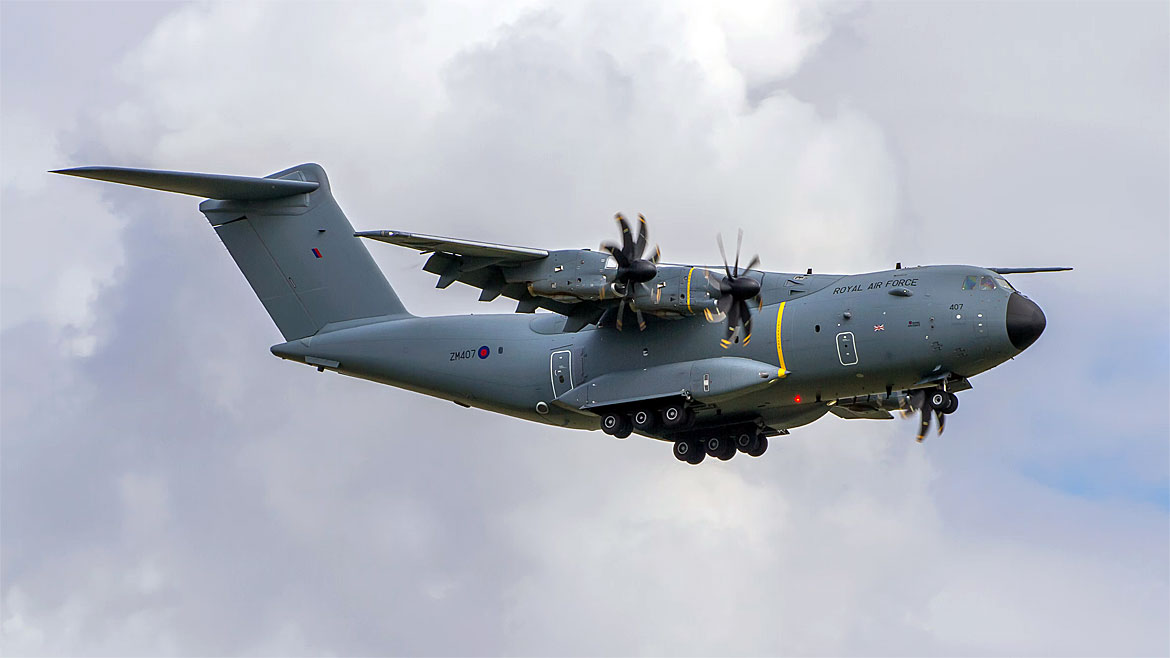

From: Chris Goss, Marlow, Bucks
Subject: Stories from the Falkland Islands War
Tony,
I spent much of the Falklands War at Jever in northern Germany where I was the Detachment Supply Officer for two F-4s from RAF Leuchars taking part in the Tactical Leadership Programme. In the German Mess each evening, the German officers would announce how many aircraft the RAF and RN had shot down and buy us all beers. I was also under strict instructions from OC S&M, Jon Mayo, that I was not to get off the C-130 when at home wearing a German leather flying jacket. We had, however, purloined a red and white chequered flag carried by all vehicle on the airfield which then adorned the squadron trophy cabinet.
By the way, I was OC Electrical Stores Group and on getting back to work, much of the stores had "gone south"
Best regards
Chris
Subject: Stories from the Falkland Islands War
Tony,
I spent much of the Falklands War at Jever in northern Germany where I was the Detachment Supply Officer for two F-4s from RAF Leuchars taking part in the Tactical Leadership Programme. In the German Mess each evening, the German officers would announce how many aircraft the RAF and RN had shot down and buy us all beers. I was also under strict instructions from OC S&M, Jon Mayo, that I was not to get off the C-130 when at home wearing a German leather flying jacket. We had, however, purloined a red and white chequered flag carried by all vehicle on the airfield which then adorned the squadron trophy cabinet.
By the way, I was OC Electrical Stores Group and on getting back to work, much of the stores had "gone south"
Best regards
Chris


Royal Irish train for deployment by air
The 1st Battalion, The Royal Irish Regiment (1 R IRISH), has taken part in Exercise Pegasus Clover at RAF Shawbury to refine their air landing competencies with the A400M transport aircraft. The exercise was geared towards equipping troops with the skills necessary for rapid deployment and operational readiness as part of their role within 16 Air Assault Brigade. During the exercise, troops from 1 R IRISH were involved in loading and securing Land Rovers and Jackal patrol vehicles onto the aircraft, followed by practice drills focussed on swift disembarkation and readiness for immediate action upon landing.
Major Matt Hazlett, Officer Commanding C (Ranger) Company, emphasised the critical importance of mobility in their operational strategy. He remarked in a press release, “We must have the mobility to get our troops and vehicles anywhere in the world by air, to then use our mobility on the ground to achieve the mission.” He further outlined their operational tactics, stating, “On an operation, we would be the first troops mounted in vehicles to arrive on an airfield that has been captured by a parachute or helicopter assault. Our role is to then push out to secure and expand that foothold.”
The reintegration of 1 R IRISH into the 16 Air Assault Brigade in 2021 is part of the broader Future Soldier vision, which seeks to transform the Army into a force characterised by greater agility, lethality, and expeditionary capabilities.
ukdefencejournal.org.uk
Major Matt Hazlett, Officer Commanding C (Ranger) Company, emphasised the critical importance of mobility in their operational strategy. He remarked in a press release, “We must have the mobility to get our troops and vehicles anywhere in the world by air, to then use our mobility on the ground to achieve the mission.” He further outlined their operational tactics, stating, “On an operation, we would be the first troops mounted in vehicles to arrive on an airfield that has been captured by a parachute or helicopter assault. Our role is to then push out to secure and expand that foothold.”
The reintegration of 1 R IRISH into the 16 Air Assault Brigade in 2021 is part of the broader Future Soldier vision, which seeks to transform the Army into a force characterised by greater agility, lethality, and expeditionary capabilities.
ukdefencejournal.org.uk
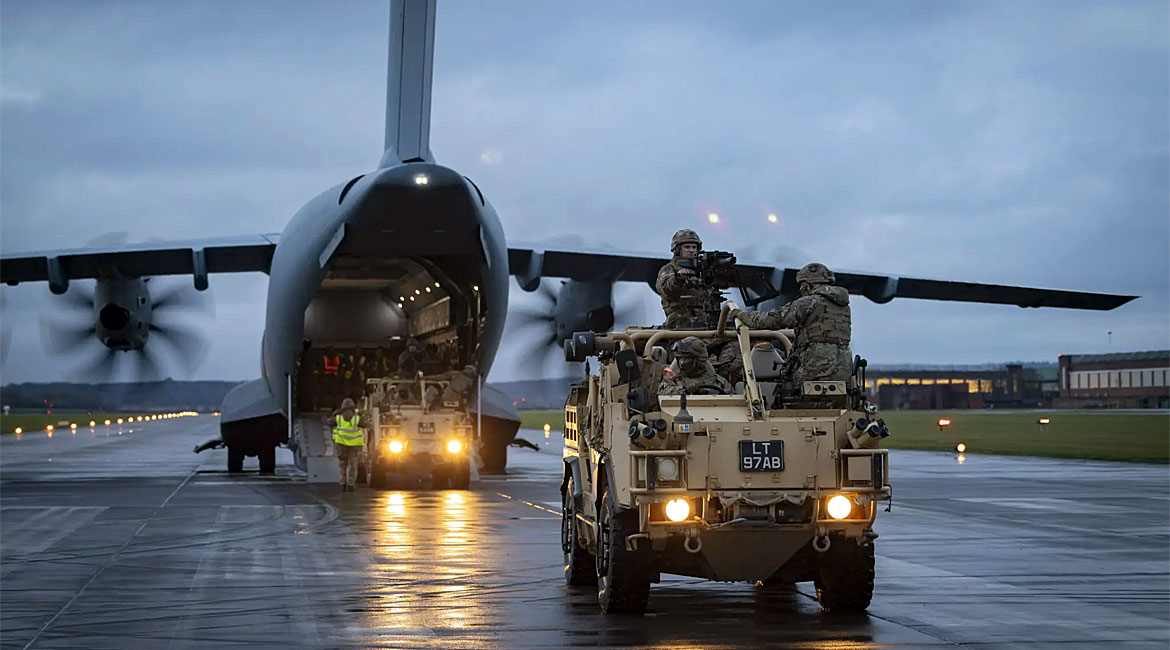

Argentina ‘Re-Ignites’ 1982 Falklands War Memories;
New President Javier Milei Wants It Back From The UK?
New President Javier Milei Wants It Back From The UK?
Argentina’s new President Javier Milei has reopened the debate on the disputed Islas Malvinas (Malvinas Islands) with the United Kingdom (UK), reigniting memories of the 74-day bitterly fought Falklands War, as the islands are called in England.
Reports have quoted Milei striking a very reconciliatory tone in the territorial assertion, suggesting the resumption of the stalled diplomacy between Argentina and the UK over the islands.
That the Malvinas is a solid emotional issue in Argentine society transcending political lines is evident from Milei broaching the topic immediately after coming to power, far from the next election.
But what has complicated matters is official Brazilian support to Argentine territorial claims, like most of South America. This highlights the contradictions in the continent’s equations with the US and the UK.
For the complete article: https://www.eurasiantimes.com/argentina-re-ignites-1982-falklands-war-memories-new/
Reports have quoted Milei striking a very reconciliatory tone in the territorial assertion, suggesting the resumption of the stalled diplomacy between Argentina and the UK over the islands.
That the Malvinas is a solid emotional issue in Argentine society transcending political lines is evident from Milei broaching the topic immediately after coming to power, far from the next election.
But what has complicated matters is official Brazilian support to Argentine territorial claims, like most of South America. This highlights the contradictions in the continent’s equations with the US and the UK.
For the complete article: https://www.eurasiantimes.com/argentina-re-ignites-1982-falklands-war-memories-new/

Britain’s ruling elite back call for conscription
Britain’s media has been flooded with statements backing the call by British Army chief General Sir Patrick Sanders for the government to prepare to “mobilise the nation” for war, increase regular army numbers to 120,000 within three years and create a “citizen army” of up to 500,000. Many statements explicitly include support for conscription.
The headlines accompanying these calls are a sign of the times: “Could World War 3 happen?” and “Will I be drafted for WW3 in the UK?” in The Sun; “Are you ready to fight in World War 3?” in the Daily Express; “World War 3: 5 chilling signs UK and US are heading for all out conflict amid global unrest” in the Daily Mirror.
All these articles assume that a major conflict between the NATO powers and Russia and China is inevitable, raising the prospect of nuclear war, and that the necessary sacrifices by the working class must be made. This is the fate of, in Sanders’ words, the “pre-war generation” now that the post-war “peace dividend” is over.
The headlines accompanying these calls are a sign of the times: “Could World War 3 happen?” and “Will I be drafted for WW3 in the UK?” in The Sun; “Are you ready to fight in World War 3?” in the Daily Express; “World War 3: 5 chilling signs UK and US are heading for all out conflict amid global unrest” in the Daily Mirror.
All these articles assume that a major conflict between the NATO powers and Russia and China is inevitable, raising the prospect of nuclear war, and that the necessary sacrifices by the working class must be made. This is the fate of, in Sanders’ words, the “pre-war generation” now that the post-war “peace dividend” is over.
Events in the last days confirm that British imperialism is in the maelstrom of a developing third world war. On January 22, British Royal Air Force Typhoon jets carried out—under the guise of protecting the Red Sea global trade artery—further airstrikes with Paveway IV missiles against Houthi targets in Yemen. These followed the first strikes in Yemen, carried out alongside US military forces, on January 11.
Tensions escalated on Friday with Houthi forces striking the Marlin Luanda oil tanker as it transited the Red Sea. The blaze from the strikes was put out by Indian, US and French navy vessels with no fatalities reported.
Houthi Brigadier General Yahya Saree claimed the Marlin Luanda was a “British” tanker and that it was attacked in support “of the oppressed Palestinian people” and in response “to the American-British aggression against our country.” The ship is owned by Singaporean-based French multinational oil and commodities trader Trafigura and was sailing under the flag of the Marshall Islands on its way to Singapore. Management of the ship is contracted out to UK-based Oceonix Services Ltd.
On Sunday [28th January], the UK Ministry of Defence showed footage of its main Type 45 destroyer warship in the region, HMS Diamond, shooting down a drone.
Confirming planning for nuclear war, the Telegraph reported Saturday, citing Pentagon documents, that a “nuclear mission” would happen at RAF Lakenheath in Suffolk “imminently.” Last September it was reported that the previous March the US Congress had received a 2024 budgetary request for $50 million (£39.5 million) from the US Air Force for a “surety dormitory” at RAF Lakenheath—a term in US military parlance referring to nuclear weapons.
According to the newspaper, unredacted procurement contracts “show how the Pentagon has ordered new equipment for the base, including ballistic shields designed to protect military personnel from attacks on ‘high value assets’.” The newspaper added that 15 years after the removal of US nuclear missiles from UK soil, “Lakenheath is expected to house B61-12 gravity bombs, which have a variable yield of up to 50 kilotons—more than three times the power of the atomic weapon dropped on Hiroshima in 1945.”
US military figures were among those backing Sanders’ call to massively expand the Armed Forces. Carlos Del Toro, the US navy secretary, said in a briefing after a speech at the Royal United Services Institute (Rusi) in London, “I think it is important for the United Kingdom to reassess where they are today given the threats that exist today.
Tensions escalated on Friday with Houthi forces striking the Marlin Luanda oil tanker as it transited the Red Sea. The blaze from the strikes was put out by Indian, US and French navy vessels with no fatalities reported.
Houthi Brigadier General Yahya Saree claimed the Marlin Luanda was a “British” tanker and that it was attacked in support “of the oppressed Palestinian people” and in response “to the American-British aggression against our country.” The ship is owned by Singaporean-based French multinational oil and commodities trader Trafigura and was sailing under the flag of the Marshall Islands on its way to Singapore. Management of the ship is contracted out to UK-based Oceonix Services Ltd.
On Sunday [28th January], the UK Ministry of Defence showed footage of its main Type 45 destroyer warship in the region, HMS Diamond, shooting down a drone.
Confirming planning for nuclear war, the Telegraph reported Saturday, citing Pentagon documents, that a “nuclear mission” would happen at RAF Lakenheath in Suffolk “imminently.” Last September it was reported that the previous March the US Congress had received a 2024 budgetary request for $50 million (£39.5 million) from the US Air Force for a “surety dormitory” at RAF Lakenheath—a term in US military parlance referring to nuclear weapons.
According to the newspaper, unredacted procurement contracts “show how the Pentagon has ordered new equipment for the base, including ballistic shields designed to protect military personnel from attacks on ‘high value assets’.” The newspaper added that 15 years after the removal of US nuclear missiles from UK soil, “Lakenheath is expected to house B61-12 gravity bombs, which have a variable yield of up to 50 kilotons—more than three times the power of the atomic weapon dropped on Hiroshima in 1945.”
US military figures were among those backing Sanders’ call to massively expand the Armed Forces. Carlos Del Toro, the US navy secretary, said in a briefing after a speech at the Royal United Services Institute (Rusi) in London, “I think it is important for the United Kingdom to reassess where they are today given the threats that exist today.
Britain would decide the strength of its army, “But I would argue, quite frankly, that given the near-term economic threats to the United Kingdom and the United States that investments in their navy are significantly important.”
Sanders, backed by Britain’s former NATO commander General Sir Richard Sherriff, intends to ensure that an increase in military spending—way beyond the current just above two percent of GDP and a target of 2.5 percent—is made a key issue in a general election to be held later this year.
Defence Secretary Grant Shapps has said that military spending must reach three percent of GDP, but Sanders, Sheriff, the US top brass and a slew of Tory and Labour politicians are demanding spending on war that massively outstrips Shapps’ goal.
A frenzied campaign is underway in the media to denounce successive governments for trying to do imperialism “on the cheap.”
The Telegraph wrote earlier this month that “Calls to send the £3bn HMS Queen Elizabeth to the [Middle East] region” were “set to be spurned” because RFA [Royal Fleet Auxiliary] Fort Victoria, the only Solid Support Ship capable of providing “the amount of ammunition, aircraft, spare equipment and food required for a full deployment, is unable to sail owing to a lack of sailors.”
In a Daily Mail op-ed, influential media figure Andrew Neil complained, “Politicians on the Left and the Right were too quick to pocket the proceeds of the peace dividend, oblivious to new threats that were rising, from Russia to Iran to China and North Korea… Britain has made a big deal of being part of the American-led attacks on Houthi installations. But our Typhoon fighter jets have had to endure a 3,000-mile round trip from Cyprus on their bombing raids, requiring in-air refuelling there and back.”
He noted that the Royal Navy’s “two state-of-the-art aircraft carriers, the Queen Elizabeth II and the Prince of Wales, built at a combined cost of £8 billion and carrying F35s, the world’s most sophisticated warplane, both lie idle in dock in Portsmouth. Apparently we don’t have enough protective ships to put around them to deploy them to where they are needed. So our RAF pilots have to fly 3,000 miles instead.”
He added, “We now spend over £50 billion a year on defence yet remain severely limited on what military power we can deploy when it is needed…. Even HMS Diamond depends entirely on the US Navy for supplies.”
Cuts to the British Army, he noted, meant it “is no longer big enough to field even a 25,000-strong armoured division… The US military increasingly thinks we lack the scale to be useful allies in war zones.”
Conservative MP Tobias Ellwood, former head of the Defence Select Committee, praised Sanders on LBC Radio, saying “What’s coming over the horizon should shock us.” The army is “half the size of what it should be,” he said, calling for an immediate doubling of the size of the military budget from two percent of GDP to four percent.
The Guardian editorialised that Sanders was stepping down as Army chief in six months and “knows that this is an election year. He wants the political parties to hear him.”
Noting that the military “has to compete for resources with hospitals, care services, local government, schools and the green agenda, to name but a few,” it said, “None of this is an outright argument against some of what Gen Sanders is calling for. The international dangers are indeed mounting. Russia is a genuine threat, particularly to Poland and the Baltic and Nordic states. Deployable military numbers really matter.”
While Tory Prime Minister Rishi Sunak has no fundamental differences with Sanders over the need to increase military spending, he has not at this stage backed the calls for conscription.
But on Saturday Boris Johnson, who Sunak replaced as prime minister following the short-lived Liz Truss premiership, referred to himself in a video which began with an army salute, “Lance Corporal Johnson reporting for duty.” He wrote in his column for the Daily Mail, “The best way to prevent a war is to prepare for it… That is why General Sanders is right in his essential point, that we must tackle the current problems in the Armed Forces, and especially of under-recruitment.”
Anything that these rabid forces demand will be more than matched by the other main tool of British imperialism, the Labour Party.
Shadow Defence Secretary John Healey, following his latest trip to Estonia to visit UK NATO regiment troops, tweeted Friday, “Over 14 years the Conservatives have hollowed out our Armed Forces. Labour will conduct a Strategic Defence Review in our first year to assess fully the state of our Armed Forces, the threats against us and the capabilities needed to defend the UK.”
wsws.org
Sanders, backed by Britain’s former NATO commander General Sir Richard Sherriff, intends to ensure that an increase in military spending—way beyond the current just above two percent of GDP and a target of 2.5 percent—is made a key issue in a general election to be held later this year.
Defence Secretary Grant Shapps has said that military spending must reach three percent of GDP, but Sanders, Sheriff, the US top brass and a slew of Tory and Labour politicians are demanding spending on war that massively outstrips Shapps’ goal.
A frenzied campaign is underway in the media to denounce successive governments for trying to do imperialism “on the cheap.”
The Telegraph wrote earlier this month that “Calls to send the £3bn HMS Queen Elizabeth to the [Middle East] region” were “set to be spurned” because RFA [Royal Fleet Auxiliary] Fort Victoria, the only Solid Support Ship capable of providing “the amount of ammunition, aircraft, spare equipment and food required for a full deployment, is unable to sail owing to a lack of sailors.”
In a Daily Mail op-ed, influential media figure Andrew Neil complained, “Politicians on the Left and the Right were too quick to pocket the proceeds of the peace dividend, oblivious to new threats that were rising, from Russia to Iran to China and North Korea… Britain has made a big deal of being part of the American-led attacks on Houthi installations. But our Typhoon fighter jets have had to endure a 3,000-mile round trip from Cyprus on their bombing raids, requiring in-air refuelling there and back.”
He noted that the Royal Navy’s “two state-of-the-art aircraft carriers, the Queen Elizabeth II and the Prince of Wales, built at a combined cost of £8 billion and carrying F35s, the world’s most sophisticated warplane, both lie idle in dock in Portsmouth. Apparently we don’t have enough protective ships to put around them to deploy them to where they are needed. So our RAF pilots have to fly 3,000 miles instead.”
He added, “We now spend over £50 billion a year on defence yet remain severely limited on what military power we can deploy when it is needed…. Even HMS Diamond depends entirely on the US Navy for supplies.”
Cuts to the British Army, he noted, meant it “is no longer big enough to field even a 25,000-strong armoured division… The US military increasingly thinks we lack the scale to be useful allies in war zones.”
Conservative MP Tobias Ellwood, former head of the Defence Select Committee, praised Sanders on LBC Radio, saying “What’s coming over the horizon should shock us.” The army is “half the size of what it should be,” he said, calling for an immediate doubling of the size of the military budget from two percent of GDP to four percent.
The Guardian editorialised that Sanders was stepping down as Army chief in six months and “knows that this is an election year. He wants the political parties to hear him.”
Noting that the military “has to compete for resources with hospitals, care services, local government, schools and the green agenda, to name but a few,” it said, “None of this is an outright argument against some of what Gen Sanders is calling for. The international dangers are indeed mounting. Russia is a genuine threat, particularly to Poland and the Baltic and Nordic states. Deployable military numbers really matter.”
While Tory Prime Minister Rishi Sunak has no fundamental differences with Sanders over the need to increase military spending, he has not at this stage backed the calls for conscription.
But on Saturday Boris Johnson, who Sunak replaced as prime minister following the short-lived Liz Truss premiership, referred to himself in a video which began with an army salute, “Lance Corporal Johnson reporting for duty.” He wrote in his column for the Daily Mail, “The best way to prevent a war is to prepare for it… That is why General Sanders is right in his essential point, that we must tackle the current problems in the Armed Forces, and especially of under-recruitment.”
Anything that these rabid forces demand will be more than matched by the other main tool of British imperialism, the Labour Party.
Shadow Defence Secretary John Healey, following his latest trip to Estonia to visit UK NATO regiment troops, tweeted Friday, “Over 14 years the Conservatives have hollowed out our Armed Forces. Labour will conduct a Strategic Defence Review in our first year to assess fully the state of our Armed Forces, the threats against us and the capabilities needed to defend the UK.”
wsws.org

A Blast from the Past!
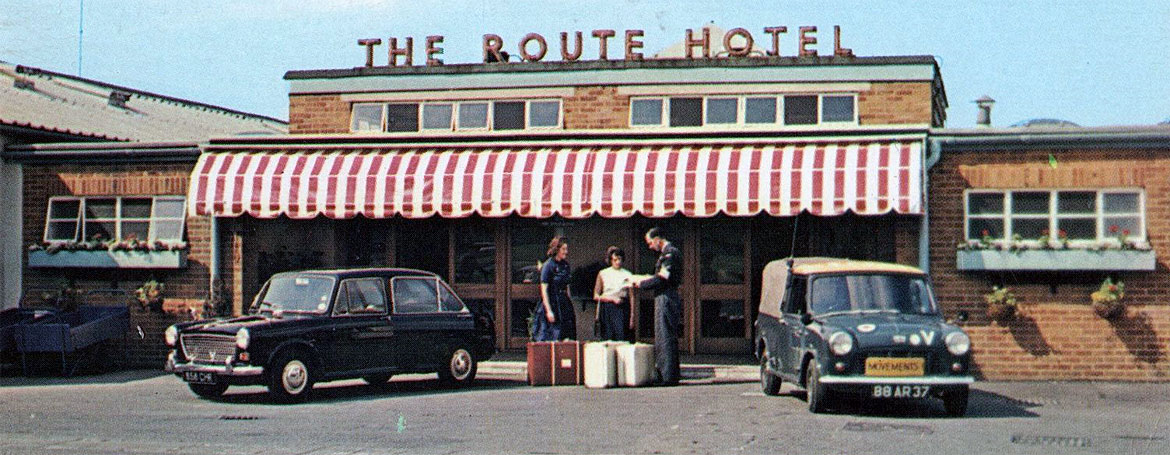
RAF Lyneham's Transit Hotel - a real favourite (Courtesy of Ian Berry)

From: Patrick Meehan, Fuengirola
Subject: Reflection on a Life: Terry Joint
Hi Tony,
Terry Joint passed away on 15 November 2023 at Costa del Sol Hospital here in Spain. He was a very dear friend of mine, so much so that I have put together a history of his life which I would like to share with you: Reflection on a Life: Terry Joint
RIP dear friend,
Patrick
Subject: Reflection on a Life: Terry Joint
Hi Tony,
Terry Joint passed away on 15 November 2023 at Costa del Sol Hospital here in Spain. He was a very dear friend of mine, so much so that I have put together a history of his life which I would like to share with you: Reflection on a Life: Terry Joint
RIP dear friend,
Patrick


From: Neville Whitham, Preston, Lancs
Subject: My brother, Derek
Tony
It is with great sadness that I wish to inform you of my brother's passing; Derek Whitham died in the early hours of this morning, Saturday 6 Jan 24, at Springhill Nursing Home, Accrington, aged 70.
Subject: My brother, Derek
Tony
It is with great sadness that I wish to inform you of my brother's passing; Derek Whitham died in the early hours of this morning, Saturday 6 Jan 24, at Springhill Nursing Home, Accrington, aged 70.

From: Sam Alexander, Logistics Branch
Subject: Squadron Leader Richard Lloyd
I am sorry to have to inform you of the death of Squadron Leader Richard Lloyd who died on 15 December after a very short battle with cancer. He died peacefully at home in Dunfermline, Fife, with his wife, Sue, and family at his bedside.
Subject: Squadron Leader Richard Lloyd
I am sorry to have to inform you of the death of Squadron Leader Richard Lloyd who died on 15 December after a very short battle with cancer. He died peacefully at home in Dunfermline, Fife, with his wife, Sue, and family at his bedside.
Richard was commissioned into the Equipment Branch in the mid-60s and enjoyed postings in the UK and overseas as a Movements Officer before a tour at MOD Harrogate leading a section provisioning aircraft engine spares. He transferred to Bordeaux as the second Jaguar Priority Supply Liaison Officer in 1976 where his language skills, warm personality and professionalism gained affection and respect from French colleagues.
Promoted to Squadron Leader in 1978 for a return to Harrogate, he resigned shortly afterwards. Then followed a varied career in the civil aviation world in sales and subsequently in management development both in the United Kingdom and in the Netherlands. In retirement he was much sought after within the Church of Scotland for his skills, delivered pro-bono, in leadership, organisational and change management. In recent years, he was part of a small network of retired Supply Branch officers where his charm and wit will be sadly missed.
Kind regards
Sam
Promoted to Squadron Leader in 1978 for a return to Harrogate, he resigned shortly afterwards. Then followed a varied career in the civil aviation world in sales and subsequently in management development both in the United Kingdom and in the Netherlands. In retirement he was much sought after within the Church of Scotland for his skills, delivered pro-bono, in leadership, organisational and change management. In recent years, he was part of a small network of retired Supply Branch officers where his charm and wit will be sadly missed.
Kind regards
Sam
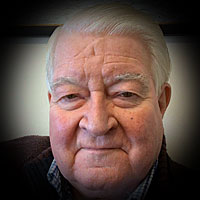
Richard Lloyd
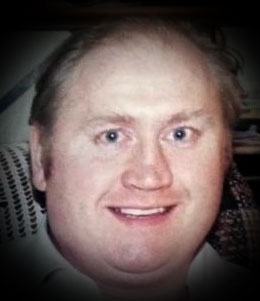
Derek Whitham
Derek had joined the RAF back in March 1973 and had Movements tours at Brize Norton, Thorney Island and latterly Lyneham, working on Static (UKMAMS) shift and also CPRS. He left the RAF in July 1978, going on to work at University College London (UCL), gaining an HND in Business Studies at The Bolton Institute, then going on to work in educational establishments within Lancashire. He will be greatly missed.
Derek's funeral will take place at the Accrington Crematorium, Burnley Road, Accrington, BB5 6HA on Friday, 2 Feb 24 at 11:40 then afterwards at The Peel Park Hotel, Turkey Street, Accrington BB5 6QT.
Neville
Derek's funeral will take place at the Accrington Crematorium, Burnley Road, Accrington, BB5 6HA on Friday, 2 Feb 24 at 11:40 then afterwards at The Peel Park Hotel, Turkey Street, Accrington BB5 6QT.
Neville
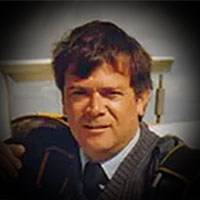
Terry Joint
This Newsletter is Dedicated
to the Memories of:
Terry Joint (RAF)
Ed Morgan (RAF)
James Eade (RAF)
Kevin Starr (RAAF)
Carl Gushue (RCAF)
Richard Lloyd (RAF)
Ivan Vienneau (RAF)
Roger Smiley (RCAF)
Carl Bertrand (RCAF)
Derek Whitham (RAF)
Hugh Thompson (RAF)
James (Jim) Jamieson (RAF)
Mavis Corke, wife of Mervyn (RAF)
Charlie Grant (RAF - died in ASI 1982)
The crew and passengers on board C130 "Hilton 22" (RAF)
to the Memories of:
Terry Joint (RAF)
Ed Morgan (RAF)
James Eade (RAF)
Kevin Starr (RAAF)
Carl Gushue (RCAF)
Richard Lloyd (RAF)
Ivan Vienneau (RAF)
Roger Smiley (RCAF)
Carl Bertrand (RCAF)
Derek Whitham (RAF)
Hugh Thompson (RAF)
James (Jim) Jamieson (RAF)
Mavis Corke, wife of Mervyn (RAF)
Charlie Grant (RAF - died in ASI 1982)
The crew and passengers on board C130 "Hilton 22" (RAF)
Tony Gale
ukmamsoba@gmail.com
ukmamsoba@gmail.com







